
Page -1
Direct RDRAM
TM
K4R881869M
Rev. 0.9 Jan. 2000
Preliminary
288Mbit RDRAM
512K x 18 bit x 2*16 Dependent Banks
Direct RDRAM
TM
Revision 0.9
January 2000

Page 0
Direct RDRAM
TM
K4R881869M
Rev. 0.9 Jan. 2000
Preliminary
Revision History
Version 0.9 (January 2000) - Preliminary
- First Copy
- Based on the Rambus Datasheet 0.9ver.
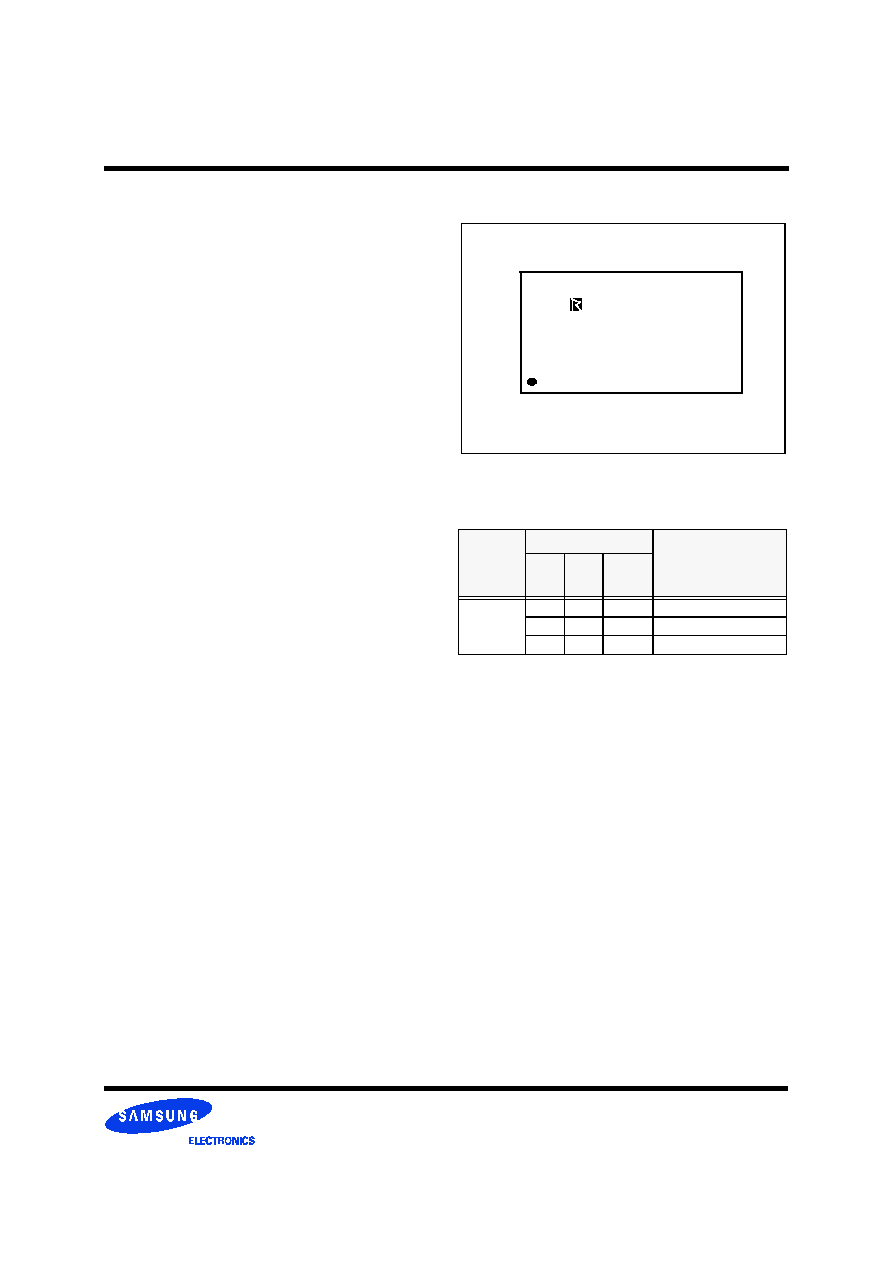
Page 1
Direct RDRAM
TM
K4R881869M
Rev. 0.9 Jan. 2000
Preliminary
Overview
The Rambus Direct RDRAMTM is a general purpose high-
performance memory device suitable for use in a broad
range of applications including computer memory, graphics,
video, and any other application where high bandwidth and
low latency are required.
The 288Mbit Direct Rambus DRAMs (RDRAM
Æ
) are
extremely high-speed CMOS DRAMs organized as 16M
words by 18 bits. The use of Rambus Signaling Level (RSL)
technology permits 600MHz to 800MHz transfer rates while
using conventional system and board design technologies.
Direct RDRAM devices are capable of sustained data trans-
fers at 1.25 ns per two bytes (10ns per sixteen bytes).
The architecture of the Direct RDRAMs allows the highest
sustained bandwidth for multiple, simultaneous randomly
addressed memory transactions. The separate control and
data buses with independent row and column control yield
over 95% bus efficiency. The Direct RDRAM's 32 banks
support up to four simultaneous transactions.
System oriented features for mobile, graphics and large
memory systems include power management, byte masking,
and x18 organization. The two data bits in the x18 organiza-
tion are general and can be used for additional storage/band-
width or for error correction.
Features
Highest sustained bandwidth per DRAM device
- 1.6GB/s sustained data transfer rate
- Separate control/data buses for maximum efficiency
- Separate row and column control buses for easy
scheduling and highest performance
- 32 banks: four transactions can take place simul-
taneously at full bandwidth data rates
Low latency features
- Write buffer to reduce read latency
- 3 precharge mechanisms for controller flexibility
- Interleaved transactions
Advanced power management:
- Multiple low power states allows flexibility in power
consumption versus time to active state
- Power-down self-refresh
Organization: 2Kbyte pages and 32 banks, x 18
- x18 organization allows ECC configurations or
increased storage and bandwidth
Used Rambus Signaling Level (RSL) for up to 800MHz oper-
ation
The 288Mbit Direct RDRAMs are offered in a CSP hori-
zontal package suitable for desktop as well as low-profile
add-in card and mobile applications.
Key Timing Parameters/Part Numbers
a.The
"
32s
"
designation indicates that this RDRAM core is composed of 32
banks which use a
"
split
"
bank architecture.
b.The
"
N
"
designator indicates the normal package
c.The
"
C
"
designator indicates that this RDRAM core uses Normal Power
Self Refresh.
Figure 1: Direct RDRAM CSP Package
Organization
Speed
Part Number
Bin
I/O
Freq.
MHz
t
RAC
(Row
Access
Time) ns
512Kx18x32s
a
-CG6
600
53.3
K4R881869M-N
b
C
c
G6
-CK7
711
45
K4R881869M-NCK7
-CK8
800
45
K4R881869M-NCK8
K4R88
xx
69A-
N
xxx
SAMSUNG 001

Page 2
Direct RDRAM
TM
K4R881869M
Rev. 0.9 Jan. 2000
Preliminary
The pin #1(ROW 1, COL A) is located at the
A1 position on the top side and the A1 position
is marked by the marker
"
"
.
Pinouts and Definitions
Center-Bonded Devices - Preliminary
These tables shows the pin assignments of the center-bonded
RDRAM package. The mechanical dimensions of this
package are shown in a later section. Refer to Section
"
Center-Bonded uBGA Package
"
on page 58. Note - pin #1
is at the A1 position. .
Table 1: Center-Bonded Device (top view)
10
V
DD
GND
V
DD
GND
V
DD
V
DD
V
DD
V
DD
GND
V
DD
9
8
GND
V
DD
CMD
V
DD
GND
GNDa
GNDa
V
DD
V
DD
GND
GND
V
DD
V
DD
GND
GND
V
CMOS
V
DD
GND
7
V
DD
DQA8
DQA7
DQA5
DQA3
DQA1
CTMN
CTM
RQ7
RQ5
RQ3
RQ1
DQB1
DQB3
DQB5
DQB7
DQB8
V
DD
6
5
4
GND
GND
DQA6
DQA4
DQA2
DQA0
CFM
CFMN
RQ6
RQ4
RQ2
RQ0
DQB0
DQB2
DQB4
DQB6
GND
GND
3
V
DD
GND
SCK
V
CMOS
GND
V
DD
GND
V
DDa
V
REF
GND
V
DD
GND
GND
V
DD
SIO0
SIO1
GND
V
DD
2
1
V
DD
GND
GND
V
DD
GND
GND
GND
GND
GND
V
DD
A
B
C
D
E
F
G
H
J
K
L
M
N
P
R
S
T
U
COL
ROW
Chip
Top View
K4R88
xx
69A-
N
xxx
SAMSUNG 001

Page 3
Direct RDRAM
TM
K4R881869M
Rev. 0.9 Jan. 2000
Preliminary
Table 2: Pin Description
Signal
I/O
Type
# Pins
Description
SIO1,SIO0
I/O
CMOS
a
2
Serial input/output. Pins for reading from and writing to the control
registers using a serial access protocol. Also used for power man-
agement.
CMD
I
CMOS
a
1
Command input. Pins used in conjunction with SIO0 and SIO1 for
reading from and writing to the control registers. Also used for
power management.
SCK
I
CMOS
a
1
Serial clock input. Clock source used for reading from and writing to
the control registers
V
DD
24
Supply voltage for the RDRAM core and interface logic.
V
DDa
1
Supply voltage for the RDRAM analog circuitry.
V
CMOS
2
Supply voltage for CMOS input/output pins.
GND
28
Ground reference for RDRAM core and interface.
GNDa
2
Ground reference for RDRAM analog circuitry.
DQA8..DQA0
I/O
RSL
b
9
Data byte A. Nine pins which carry a byte of read or write data
between the Channel and the RDRAM.
CFM
I
RSL
b
1
Clock from master. Interface clock used for receiving RSL signals
from the Channel. Positive polarity.
CFMN
I
RSL
b
1
Clock from master. Interface clock used for receiving RSL signals
from the Channel. Negative polarity
V
REF
1
Logic threshold reference voltage for RSL signals
CTMN
I
RSL
b
1
Clock to master. Interface clock used for transmitting RSL signals
to the Channel. Negative polarity.
CTM
I
RSL
b
1
Clock to master. Interface clock used for transmitting RSL signals
to the Channel. Positive polarity.
RQ7..RQ5 or
ROW2..ROW0
I
RSL
b
3
Row access control. Three pins containing control and address
information for row accesses.
RQ4..RQ0 or
COL4..COL0
I
RSL
b
5
Column access control. Five pins containing control and address
information for column accesses.
DQB8..
DQB0
I/O
RSL
b
9
Data byte B. Nine pins which carry a byte of read or write data
between the Channel and the RDRAM.
Total pin count per package
92
a. All CMOS signals are high-true; a high voltage is a logic one and a low voltage is logic zero.
b. All RSL signals are low-true; a low voltage is a logic one and a high voltage is logic zero.
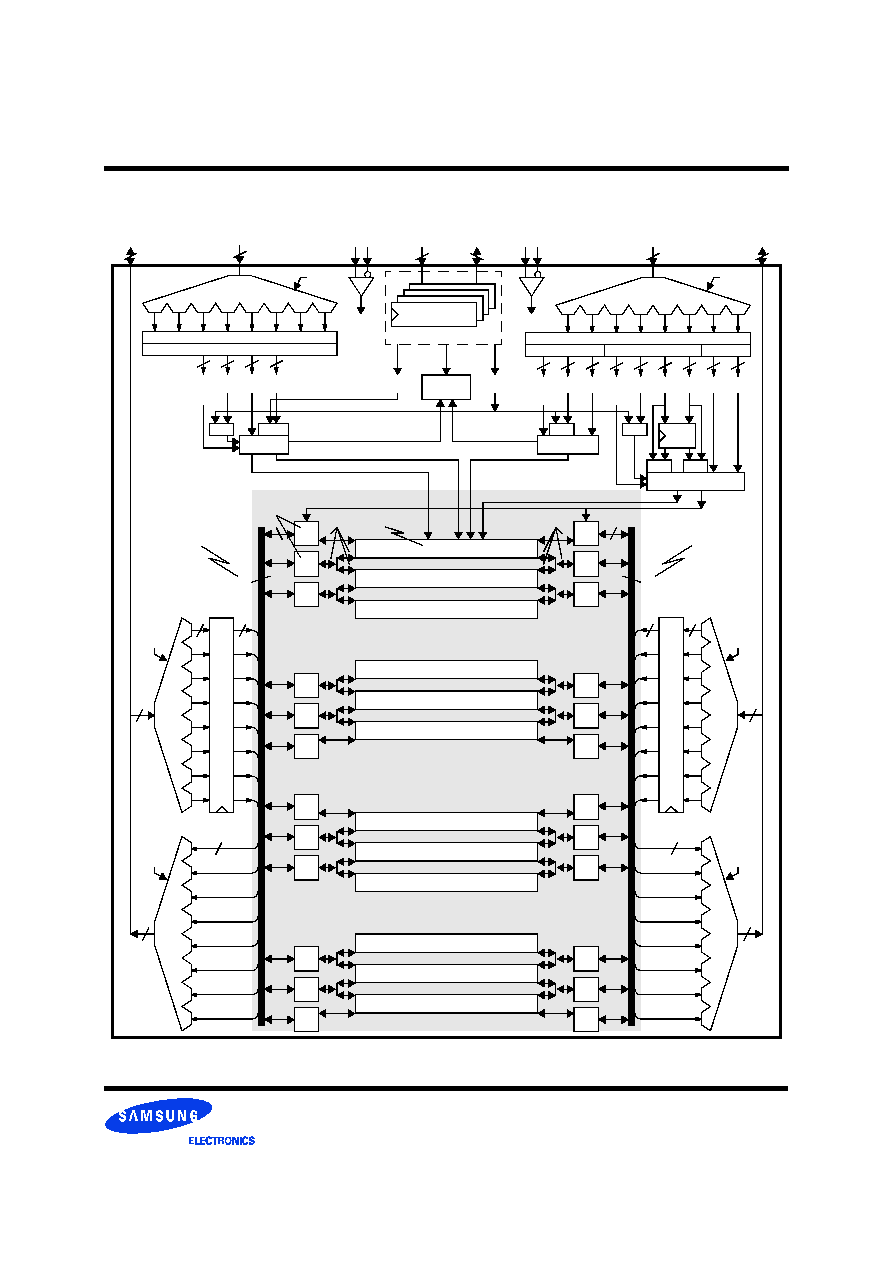
Page 4
Direct RDRAM
TM
K4R881869M
Rev. 0.9 Jan. 2000
Preliminary
Figure 2: 288 Mbit Direct RDRAM Block Diagram
Bank 31
DQA8..DQA0
1
:
8
D
e
m
u
x
8
:
1
M
u
x
W
r
i
t
e
B
u
f
f
e
r
1
:
8
D
e
m
u
x
W
r
i
t
e
B
u
f
f
e
r
8
:
1
M
u
x
Bank 30
Bank 29
Bank 18
Bank 17
Bank 16
Bank 15
Bank 14
Bank 13
Bank 1
Bank 0
S
A
m
p
1
/
2
DQB8..DQB0
9
1:8 Demux
1:8 Demux
Packet Decode
9
5
3
ROW2..ROW0
COL4..COL0
CTM CTMN
CFM CFMN
2
SCK,CMD
RCLK
TCLK
Control Registers
DC
COP
C
BC
MA
MB
DX
XOP
BX
DR
R
ROP
BR
8
8
7
5
5
5
5
5
6
9
5
5
11
AV
M
S
Write
Buffer
Match
Match
Mux
Match
DEVID
512x128x144
Internal DQB Data Path
Column Decode & Mask
72
9
9
72
9
DM
REFR
Row Decode
Mux
ACT
RD, WR
Power Modes
DRAM Core
Mux
XOP Decode
PREX
PREC
9
9
9
9
72
9
9
9
PRER
COLX
COLC
COLM
2
SIO0,SIO1
Sense Amp
Internal DQA Data Path
Packet Decode
ROWA
ROWR
RCLK
RCLK
R
C
L
K
T
C
L
K
R
C
L
K
T
C
L
K
RQ7..RQ5 or
RQ4..RQ0 or
S
A
m
p
0
/
1
S
A
m
p
0
S
A
m
p
1
4
/
1
5
S
A
m
p
1
5
S
A
m
p
1
3
/
1
4
S
A
m
p
1
6
/
1
7
S
A
m
p
1
7
/
1
8
S
A
m
p
1
6
S
A
m
p
2
9
/
3
0
S
A
m
p
3
0
/
3
1
S
A
m
p
3
1
64x72
S
A
m
p
1
/
2
72
S
A
m
p
0
/
1
S
A
m
p
0
S
A
m
p
1
4
/
1
5
S
A
m
p
1
5
S
A
m
p
1
3
/
1
4
S
A
m
p
1
6
/
1
7
S
A
m
p
1
7
/
1
8
S
A
m
p
1
6
S
A
m
p
2
9
/
3
0
S
A
m
p
3
0
/
3
1
S
A
m
p
3
1
64x72
64x72
Bank 2
∑
∑
∑
∑
∑
∑
∑
∑
∑
∑
∑
∑
∑
∑
∑
∑
∑
∑

Page 5
Direct RDRAM
TM
K4R881869M
Rev. 0.9 Jan. 2000
Preliminary
General Description
Figure 2 is a block diagram of the 288Mbit Direct RDRAM.
It consists of two major blocks: a
"
core
"
block built from
banks and sense amps similar to those found in other types
of DRAM, and a Direct Rambus interface block which
permits an external controller to access this core at up to
1.6GB/s.
Control Registers:
The CMD, SCK, SIO0, and SIO1
pins appear in the upper center of Figure 2. They are used to
write and read a block of control registers. These registers
supply the RDRAM configuration information to a
controller and they select the operating modes of the device.
The nine bit REFR value is used for tracking the last
refreshed row. Most importantly, the five bit DEVID speci-
fies the device address of the RDRAM on the Channel.
Clocking:
The CTM and CTMN pins (Clock-To-Master)
generate TCLK (Transmit Clock), the internal clock used to
transmit read data. The CFM and CFMN pins (Clock-From-
Master) generate RCLK (Receive Clock), the internal clock
signal used to receive write data and to receive the ROW and
COL pins.
DQA,DQB Pins:
These 18 pins carry read (Q) and write
(D) data across the Channel. They are multiplexed/de-multi-
plexed from/to two 72-bit data paths (running at one-eighth
the data frequency) inside the RDRAM.
Banks:
The 32Mbyte core of the RDRAM is divided into
32 one-Mbyte banks, each organized as 512 rows, with each
row containing 128 dualocts (2 Kbytes), and each dualoct
containing 16 bytes. A dualoct is the smallest unit of data
that can be addressed.
Sense Amps:
The RDRAM contains 34 sense amps. Each
sense amp consists of 1024 bytes of fast storage (512 for
DQA and 512 for DQB) and can hold one-half of one row of
one bank of the RDRAM. The sense amp may hold any of
the 512 half-rows of an associated bank. However, each
sense amp is shared between two adjacent banks of the
RDRAM (except for numbers 0, 15, 30, and 31). This intro-
duces the restriction that adjacent banks may not be simulta-
neously accessed.
RQ Pins:
These pins carry control and address informa-
tion. They are broken into two groups. RQ7..RQ5 are also
called ROW2..ROW0, and are used primarily for controlling
row accesses. RQ4..RQ0 are also called COL4..COL0, and
are used primarily for controlling column accesses.
ROW Pins:
The principle use of these three pins is to
manage the transfer of data between the banks and the sense
amps of the RDRAM. These pins are de-multiplexed into a
24-bit ROWA (row-activate) or ROWR (row-operation)
packet.
COL Pins:
The principle use of these five pins is to
manage the transfer of data between the DQA/DQB pins and
the sense amps of the RDRAM. These pins are de-multi-
plexed into a 23-bit COLC (column-operation) packet and
either a 17-bit COLM (mask) packet or a 17-bit COLX
(extended-operation) packet.
ACT Command:
An ACT (activate) command from an
ROWA packet causes one of the 512 rows of the selected
bank to be loaded to its associated sense amps (two 512 byte
sense amps for DQA and two for DQB).
PRER Command:
A PRER (precharge) command from
an ROWR packet causes the selected bank to release its two
associated sense amps, permitting a different row in that
bank to be activated, or permitting adjacent banks to be acti-
vated.
RD Command:
The RD (read) command causes one of
the 128 dualocts of one of the sense amps to be transmitted
on the DQA/DQB pins of the Channel.
WR Command:
The WR (write) command causes a
dualoct received from the DQA/DQB data pins of the
Channel to be loaded into the write buffer. There is also
space in the write buffer for the BC bank address and C
column address information. The data in the write buffer is
automatically retired (written with optional bytemask) to one
of the 128 dualocts of one of the sense amps during a subse-
quent COP command. A retire can take place during a RD,
WR, or NOCOP to another device, or during a WR or
NOCOP to the same device. The write buffer will not retire
during a RD to the same device. The write buffer reduces the
delay needed for the internal DQA/DQB data path turn-
around.
PREC Precharge:
The PREC, RDA and WRA
commands are similar to NOCOP, RD and WR, except that
a precharge operation is performed at the end of the column
operation. These commands provide a second mechanism
for performing precharge.
PREX Precharge:
After a RD command, or after a WR
command with no byte masking (M=0), a COLX packet may
be used to specify an extended operation (XOP). The most
important XOP command is PREX. This command provides
a third mechanism for performing precharge.
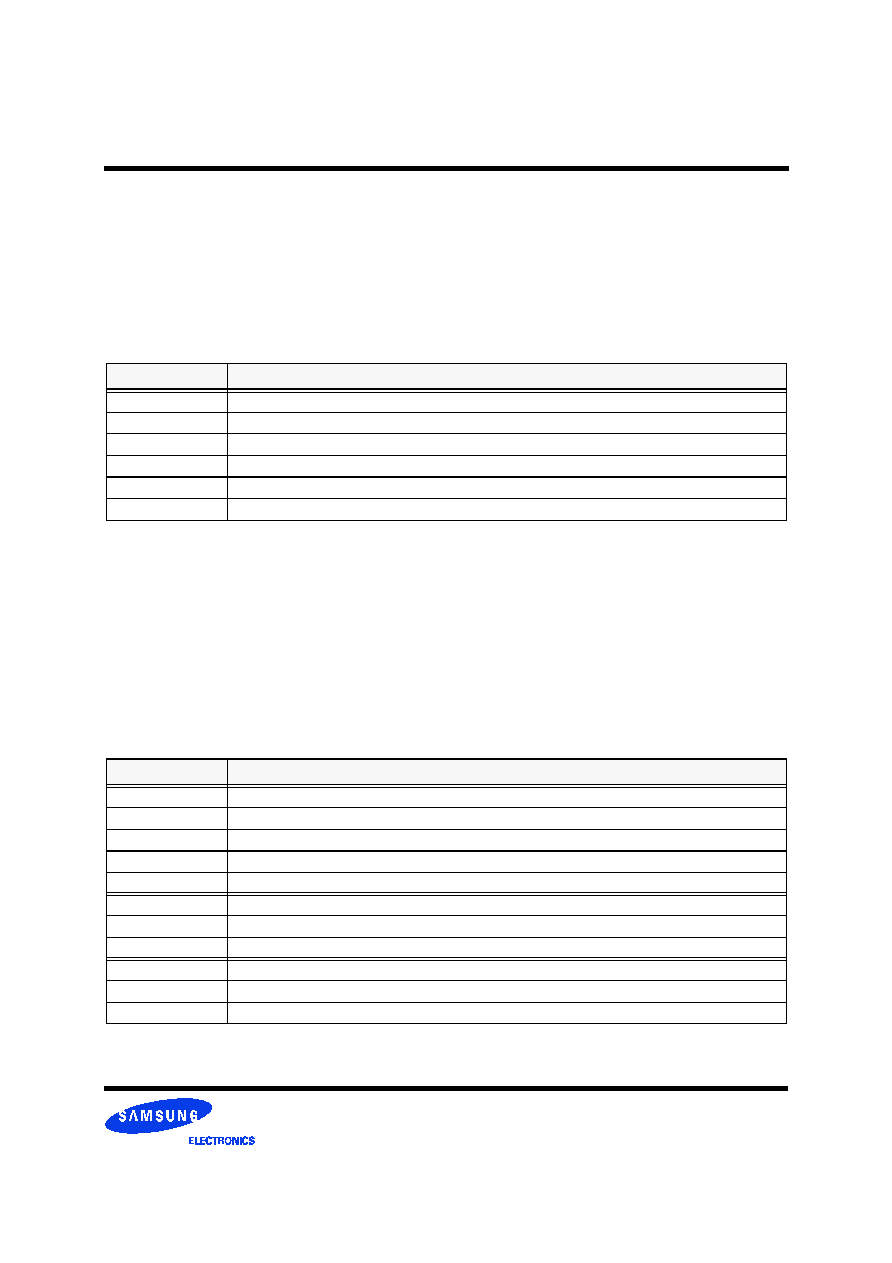
Page 6
Direct RDRAM
TM
K4R881869M
Rev. 0.9 Jan. 2000
Preliminary
Packet Format
Figure 3 shows the formats of the ROWA and ROWR
packets on the ROW pins. Table 4 describes the fields which
comprise these packets. DR4T and DR4F bits are encoded to
contain both the DR4 device address bit and a framing bit
which allows the ROWA or ROWR packet to be recognized
by the RDRAM.
The AV (ROWA/ROWR packet selection) bit distinguishes
between the two packet types. Both the ROWA and ROWR
packet provide a five bit device address and a five bit bank
address. An ROWA packet uses the remaining bits to
specify a nine bit row address, and the ROWR packet uses
the remaining bits for an eleven bit opcode field. Note the
use of the
"
RsvX
"
notation to reserve bits for future address
field extension.
Figure 3 also shows the formats of the COLC, COLM, and
COLX packets on the COL pins. Table 5 describes the fields
which comprise these packets.
The COLC packet uses the S (Start) bit for framing. A
COLM or COLX packet is aligned with this COLC packet,
and is also framed by the S bit.
The 23 bit COLC packet has a five bit device address, a five
bit bank address, a seven bit column address, and a four bit
opcode. The COLC packet specifies a read or write
command, as well as some power management commands.
The remaining 17 bits are interpreted as a COLM (M=1) or
COLX (M=0) packet. A COLM packet is used for a COLC
write command which needs bytemask control. The COLM
packet is associated with the COLC packet from a time t
RTR
earlier. An COLX packet may be used to specify an indepen-
dent precharge command. It contains a five bit device
address, a five bit bank address, and a five bit opcode. The
COLX packet may also be used to specify some house-
keeping and power management commands. The COLX
packet is framed within a COLC packet but is not otherwise
associated with any other packet.
Table 4: Field Description for ROWA Packet and ROWR Packet
Field
Description
DR4T,DR4F
Bits for framing (recognizing) a ROWA or ROWR packet. Also encodes highest device address bit.
DR3..DR0
Device address for ROWA or ROWR packet.
BR4..BR0
Bank address for ROWA or ROWR packet. RsvB denotes bits ignored by the RDRAM.
AV
Selects between ROWA packet (AV=1) and ROWR packet (AV=0).
R8..R0
Row address for ROWA packet. RsvR denotes bits ignored by the RDRAM.
ROP10..ROP0
Opcode field for ROWR packet. Specifies precharge, refresh, and power management functions.
Table 5: Field Description for COLC Packet, COLM Packet, and COLX Packet
Field
Description
S
Bit for framing (recognizing) a COLC packet, and indirectly for framing COLM and COLX packets.
DC4..DC0
Device address for COLC packet.
BC4..BC0
Bank address for COLC packet. RsvB denotes bits reserved for future extension (controller drives 0's).
C6..C0
Column address for COLC packet.
COP3..COP0
Opcode field for COLC packet. Specifies read, write, precharge, and power management functions.
M
Selects between COLM packet (M=1) and COLX packet (M=0).
MA7..MA0
Bytemask write control bits. 1=write, 0=no-write. MA0 controls the earliest byte on DQA8..0.
MB7..MB0
Bytemask write control bits. 1=write, 0=no-write. MB0 controls the earliest byte on DQB8..0.
DX4..DX0
Device address for COLX packet.
BX4..BX0
Bank address for COLX packet. RsvB denotes bits reserved for future extension (controller drives 0's).
XOP4..XOP0
Opcode field for COLX packet. Specifies precharge, I
OL
control, and power management functions.

Page 7
Direct RDRAM
TM
K4R881869M
Rev. 0.9 Jan. 2000
Preliminary
Figure 3: Packet Formats
CTM/CFM
COL4
COL3
COL2
COL1
COL0
T
8
T
9
T
10
T
11
T
12
T
13
T
14
T
15
T
8
T
9
T
10
T
11
T
0
T
1
T
2
T
3
T
0
T
1
T
2
T
3
S=1
a
MA7 MA5 MA3 MA1
M=1 MA6 MA4 MA2 MA0
MB7 MB4 MB1
MB6 MB3 MB0
MB5 MB2
R2
CTM/CFM
ROW2
DR4T DR2 BR0
BR3 RsvR
R8
R5
ROW1
DR4F DR1 BR1
BR4 RsvR
R7
R4
R1
ROW0
DR3
DR0 BR2 RsvB AV=1
R6
R3
R0
ACT a0
PREX d0
MSK (b1)
PRER c0
WR b1
C4
CTM/CFM
COL4
DC4
S=1
C6
COL3
DC3
C5
C3
COL2
DC2 COP1
RsvB BC2
C2
DC1 COP0
BC4
BC1
C1
DC0 COP2
COP3 BC3
BC0
C0
COL1
COL0
CTM/CFM
ROW2
ROW1
ROW0
CTM/CFM
COL4
COL3
COL2
COL1
COL0
ROP2
DR4T DR2 BR0
BR3
ROP10
ROP8 ROP5
DR4F DR1 BR1 4RsvB ROP9 ROP7 ROP4 ROP1
DR3
DR0 BR2 RsvB AV=0 ROP6 ROP3 ROP0
S=1
b
DX4 XOP4 RsvB BX1
M=0 DX3 XOP3 BX4
BX0
DX2 XOP2 BX3
DX1 XOP1 BX2
DX0 XOP0
T
0
T
4
T
8
T
12
T
1
T
5
T
9
T
13
T
2
T
6
T
10
T
14
T
3
T
7
T
11
T
15
ROWA Packet
COLM Packet
COLC Packet
COLX Packet
ROWR Packet
CTM/CFM
DQA8..0
DQB8..0
COL4
..COL0
ROW2
..ROW0
t
PACKET
a
The COLM is associated with a
previous COLC, and is aligned
with the present COLC, indicated
by the Start bit (S=1) position.
b
The COLX is aligned
with the present COLC,
indicated by the Start
bit (S=1) position.

Page 8
Direct RDRAM
TM
K4R881869M
Rev. 0.9 Jan. 2000
Preliminary
Field Encoding Summary
Table 6 shows how the six device address bits are decoded
for the ROWA and ROWR packets. The DR4T and DR4F
encoding merges a fifth device bit with a framing bit. When
neither bit is asserted, the device is not selected. Note that a
broadcast operation is indicated when both bits are set.
Broadcast operation would typically be used for refresh and
power management commands. If the device is selected, the
DM (DeviceMatch) signal is asserted and an ACT or ROP
command is performed.
Table 7 shows the encodings of the remaining fields of the
ROWA and ROWR packets. An ROWA packet is specified
by asserting the AV bit. This causes the specified row of the
specified bank of this device to be loaded into the associated
sense amps.
An ROWR packet is specified when AV is not asserted. An
11 bit opcode field encodes a command for one of the banks
of this device. The PRER command causes a bank and its
two associated sense amps to precharge, so another row or
an adjacent bank may be activated. The REFA (refresh-acti-
vate) command is similar to the ACT command, except the
row address comes from an internal register REFR, and
REFR is incremented at the largest bank address. The REFP
(refresh-precharge) command is identical to a PRER
command.
The NAPR, NAPRC, PDNR, ATTN, and RLXR commands
are used for managing the power dissipation of the RDRAM
and are described in more detail in
"
Power State Manage-
ment
"
on page 38. The TCEN and TCAL commands are
used to adjust the output driver slew rate and they are
described in more detail in
"
Current and Temperature
Control
"
on page 43.
Table 6: Device Field Encodings for ROWA Packet and ROWR Packet
DR4T
DR4F
Device Selection
Device Match signal (DM)
1
1
All devices (broadcast)
DM is set to 1
0
1
One device selected
DM is set to 1 if {DEVID4..DEVID0} == {0,DR3..DR0} else DM is set to 0
1
0
One device selected
DM is set to 1 if {DEVID4..DEVID0} == {1,DR3..DR0} else DM is set to 0
0
0
No packet present
DM is set to 0
Table 7: ROWA Packet and ROWR Packet Field Encodings
DM
a
AV
ROP10..ROP0 Field
Name
Command Description
10
9
8
7
6
5
4
3
2:0
0
-
-
-
-
-
-
-
-
-
---
-
No operation.
1
1
Row address
ACT
Activate row R8..R0 of bank BR4..BR0 of device and move device to ATTN
b
.
1
0
1
1
0
0
0
x
c
x
x
000
PRER
Precharge bank BR4..BR0 of this device.
1
0
0
0
0
1
1
0
0
x
000
REFA
Refresh (activate) row REFR8..REFR0 of bank BR3..BR0 of device.
Increment REFR if BR4..BR0 = 1111 (see Figure 50).
1
0
1
0
1
0
1
0
0
x
000
REFP
Precharge bank BR4..BR0 of this device after REFA (see Figure 50).
1
0
x
x
0
0
0
0
1
x
000
PDNR
Move this device into the powerdown (PDN) power state (see Figure 47).
1
0
x
x
0
0
0
1
0
x
000
NAPR
Move this device into the nap (NAP) power state (see Figure 47).
1
0
x
x
0
0
0
1
1
x
000
NAPRC
Move this device into the nap (NAP) power state conditionally
1
0
x
x
x
x
x
x
x
0
000
ATTN
b
Move this device into the attention (ATTN) power state (see Figure 45).
1
0
x
x
x
x
x
x
x
1
000
RLXR
Move this device into the standby (STBY) power state (see Figure 46).
1
0
0
0
0
0
0
0
0
x
001
TCAL
Temperature calibrate this device (see Figure 52).
1
0
0
0
0
0
0
0
0
x
010
TCEN
Temperature calibrate/enable this device (see Figure 52).
1
0
0
0
0
0
0
0
0
0
000
NOROP
No operation.
a. The DM (Device Match signal) value is determined by the DR4T,DR4F, DR3..DR0 field of the ROWA and ROWR packets. See Table 6.
b. The ATTN command does not cause a RLX-to-ATTN transition for a broadcast operation (DR4T/DR4F=1/1).
c. An
"
x
"
entry indicates which commands may be combined. For instance, the three commands PRER/NAPRC/RLXR may be specified in one ROP value (011000111000).
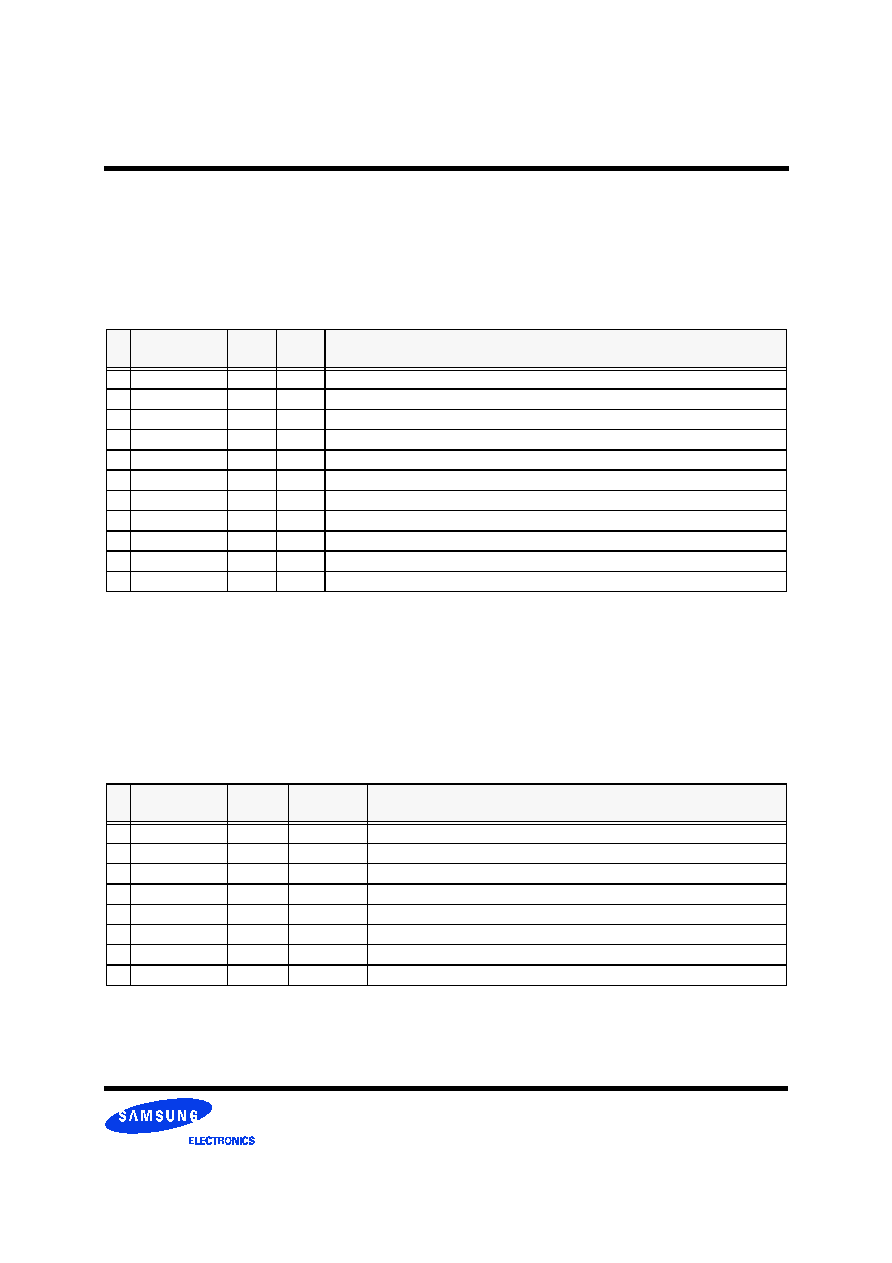
Page 9
Direct RDRAM
TM
K4R881869M
Rev. 0.9 Jan. 2000
Preliminary
Table 8 shows the COP field encoding. The device must be
in the ATTN power state in order to receive COLC packets.
The COLC packet is used primarily to specify RD (read) and
WR (write) commands. Retire operations (moving data from
the write buffer to a sense amp) happen automatically. See
Figure 17 for a more detailed description.
The COLC packet can also specify a PREC command,
which precharges a bank and its associated sense amps. The
RDA/WRA commands are equivalent to combining RD/WR
with a PREC. RLXC (relax) performs a power mode transi-
tion. See
"
Power State Management
"
on page 38.
Table 9 shows the COLM and COLX field encodings. The
M bit is asserted to specify a COLM packet with two 8 bit
bytemask fields MA and MB. If the M bit is not asserted, an
COLX is specified. It has device and bank address fields,
and an opcode field. The primary use of the COLX packet is
to permit an independent PREX (precharge) command to be
specified without consuming control bandwidth on the ROW
pins. It is also used for the CAL(calibrate) and SAM
(sample) current control commands (see
"
Current and
Temperature Control
"
on page 43, and for the RLXX power
mode command (see
"
Power State Management
"
on page
38).
Table 8: COLC Packet Field Encodings
S
DC4.. DC0
(select device)
a
COP3..0 Name
Command Description
0
----
-----
-
No operation.
1
/= (DEVID4 ..0)
-----
-
Retire write buffer of this device.
1
== (DEVID4 ..0)
x000
b
NOCOP
Retire write buffer of this device.
1
== (DEVID4 ..0)
x001
WR
Retire write buffer of this device, then write column C6..C0 of bank BC4..BC0 to write buffer.
1
== (DEVID4 ..0)
x010
RSRV
Reserved, no operation.
1
== (DEVID4 ..0)
x011
RD
Read column C6..C0 of bank BC4..BC0 of this device.
1
== (DEVID4 ..0)
x100
PREC
Retire write buffer of this device, then precharge bank BC4..BC0 (see Figure 14).
1
== (DEVID4 ..0)
x101
WRA
Same as WR, but precharge bank BC4..BC0 after write buffer (with new data) is retired.
1
== (DEVID4 ..0)
x110
RSRV
Reserved, no operation.
1
== (DEVID4 ..0)
x111
RDA
Same as RD, but precharge bank BC4..BC0 afterward.
1
== (DEVID4 ..0)
1xxx
RLXC
Move this device into the standby (STBY) power state (see Figure 46).
a.
"
/=
"
means not equal,
"
==
"
means equal.
b. An
"
x
"
entry indicates which commands may be combined. For instance, the two commands WR/RLXC may be specified in one COP value (1001).
Table 9: COLM Packet and COLX Packet Field Encodings
M
DX4 .. DX0
(selects device)
XOP4..0
Name
Command Description
1
----
-
MSK
MB/MA bytemasks used by WR/WRA.
0
/= (DEVID4 ..0)
-
-
No operation.
0
== (DEVID4 ..0)
00000
NOXOP
No operation.
0
== (DEVID4 ..0)
1xxx0
a
PREX
Precharge bank BX4..BX0 of this device (see Figure 14).
0
== (DEVID4 ..0)
x10x0
CAL
Calibrate (drive) I
OL
current for this device (see Figure 51).
0
== (DEVID4 ..0)
x11x0
CAL/SAM
Calibrate (drive) and Sample ( update) I
OL
current for this device (see Figure 51).
0
== (DEVID4 ..0)
xxx10
RLXX
Move this device into the standby (STBY) power state (see Figure 46).
0
== (DEVID4 ..0)
xxxx1
RSRV
Reserved, no operation.
a. An
"
x
"
entry indicates which commands may be combined. For instance, the two commands PREX/RLXX may be specified in one XOP value (10010)
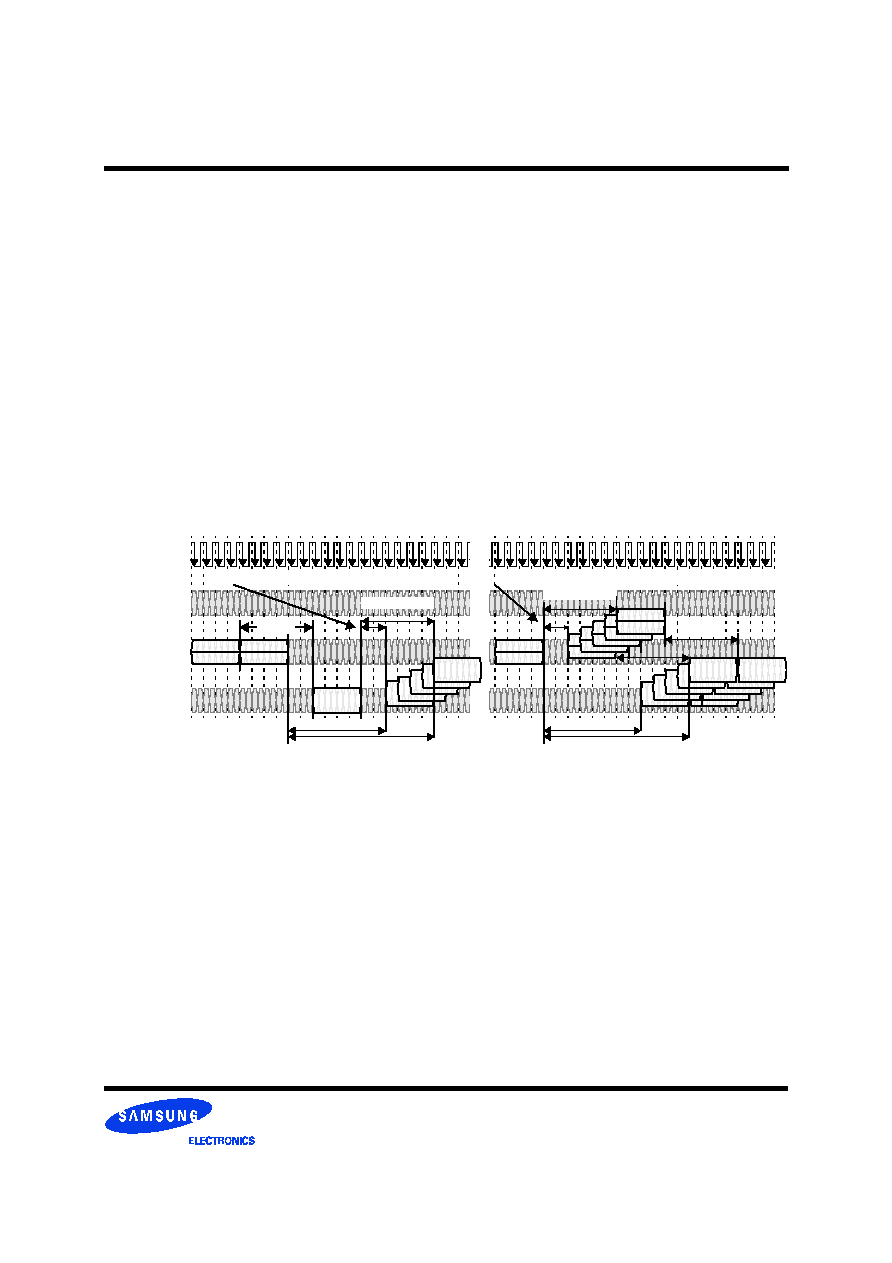
Page 10
Direct RDRAM
TM
K4R881869M
Rev. 0.9 Jan. 2000
Preliminary
DQ Packet Timing
Figure 4 shows the timing relationship of COLC packets
with D and Q data packets. This document uses a specific
convention for measuring time intervals between packets: all
packets on the ROW and COL pins (ROWA, ROWR,
COLC, COLM, COLX) use the trailing edge of the packet as
a reference point, and all packets on the DQA/DQB pins (D
and Q) use the leading edge of the packet as a reference
point.
An RD or RDA command will transmit a dualoct of read
data Q a time t
CAC
later. This time includes one to five
cycles of round-trip propagation delay on the Channel. The
t
CAC
parameter may be programmed to a one of a range of
values ( 8, 9, 10, 11, or 12 t
CYCLE
). The value chosen
depends upon the number of RDRAM devices on the
Channel and the RDRAM timing bin. See Figure 39 for
more information.
A WR or WRA command will receive a dualoct of write
data D a time t
CWD
later. This time does not need to include
the round-trip propagation time of the Channel since the
COLC and D packets are traveling in the same direction.
When a Q packet follows a D packet (shown in the left half
of the figure), a gap (t
CAC
-t
CWD
) will automatically appear
between them because the t
CWD
value is always less than the
t
CAC
value. There will be no gap between the two COLC
packets with the WR and RD commands which schedule the
D and Q packets.
When a D packet follows a Q packet (shown in the right half
of the figure), no gap is needed between them because the
t
CWD
value is less than the t
CAC
value. However, , a gap of
t
CAC
-t
CWD
or greater must be inserted between the COLC
packets with the RD WR commands by the controller so the
Q and D packets do not overlap.
COLM Packet to D Packet Mapping
Figure 5 shows a write operation initiated by a WR
command in a COLC packet. If a subset of the 16 bytes of
write data are to be written, then a COLM packet is trans-
mitted on the COL pins a time t
RTR
after the COLC packet
containing the WR command. The M bit of the COLM
packet is set to indicate that it contains the MA and MB
mask fields. Note that this COLM packet is aligned with the
COLC packet which causes the write buffer to be retired.
See Figure 17 for more details.
If all 16 bytes of the D data packet are to be written, then no
further control information is required. The packet slot that
would have been used by the COLM packet (t
RTR
after the
COLC packet) is available to be used as an COLX packet.
This could be used for a PREX precharge command or for a
housekeeping command (this case is not shown). The M bit
is not asserted in an COLX packet and causes all 16 bytes of
the previous WR to be written unconditionally. Note that a
RD command will never need a COLM packet, and will
always be able to use the COLX packet option (a read opera-
tion has no need for the byte-write-enable control bits).
Figure 5 also shows the mapping between the MA and MB
fields of the COLM packet and bytes of the D packet on the
DQA and DQB pins. Each mask bit controls whether a byte
of data is written (=1) or not written (=0).
Figure 4: Read (Q) and Write (D) Data Packet - Timing for t
CAC
= 8, 9, 10, 11, or 12 t
CYCLE
CTM/CFM
DQA8..0
DQB8..0
COL4
..COL0
ROW2
..ROW0
T
0
T
4
T
8
T
12
T
1
T
5
T
9
T
13
T
2
T
6
T
10
T
14
T
3
T
7
T
11
T
15
T
16
T
20
T
24
T
28
T
17
T
21
T
25
T
29
T
18
T
22
T
26
T
30
T
19
T
23
T
27
T
31
T
32
T
36
T
40
T
44
T
33
T
37
T
41
T
45
T
34
T
38
T
42
T
46
T
35
T
39
T
43
T
47
RD b1
Q (a1)
WR a1
D (a1)
t
CWD
RD c1
Q (a1)
t
CAC
-t
CWD
This gap on the DQA/DQB pins appears automatically
This gap on the COL pins must be inserted by the controller
t
CAC
t
CAC
WR d1
D (d1)
D (d1)
t
CAC
-t
CWD
t
CWD
WR d1
Q (c1)
∑ ∑ ∑
∑ ∑ ∑
WR d1
WR d1
∑ ∑ ∑
D (d1)
Q (c1)
D (d1)
Q (c1)
∑ ∑ ∑
∑ ∑ ∑
Q (a1)
Q (a1)
Q (b1)
Q (b1)
WR d1
D (d1)
Q (c1)
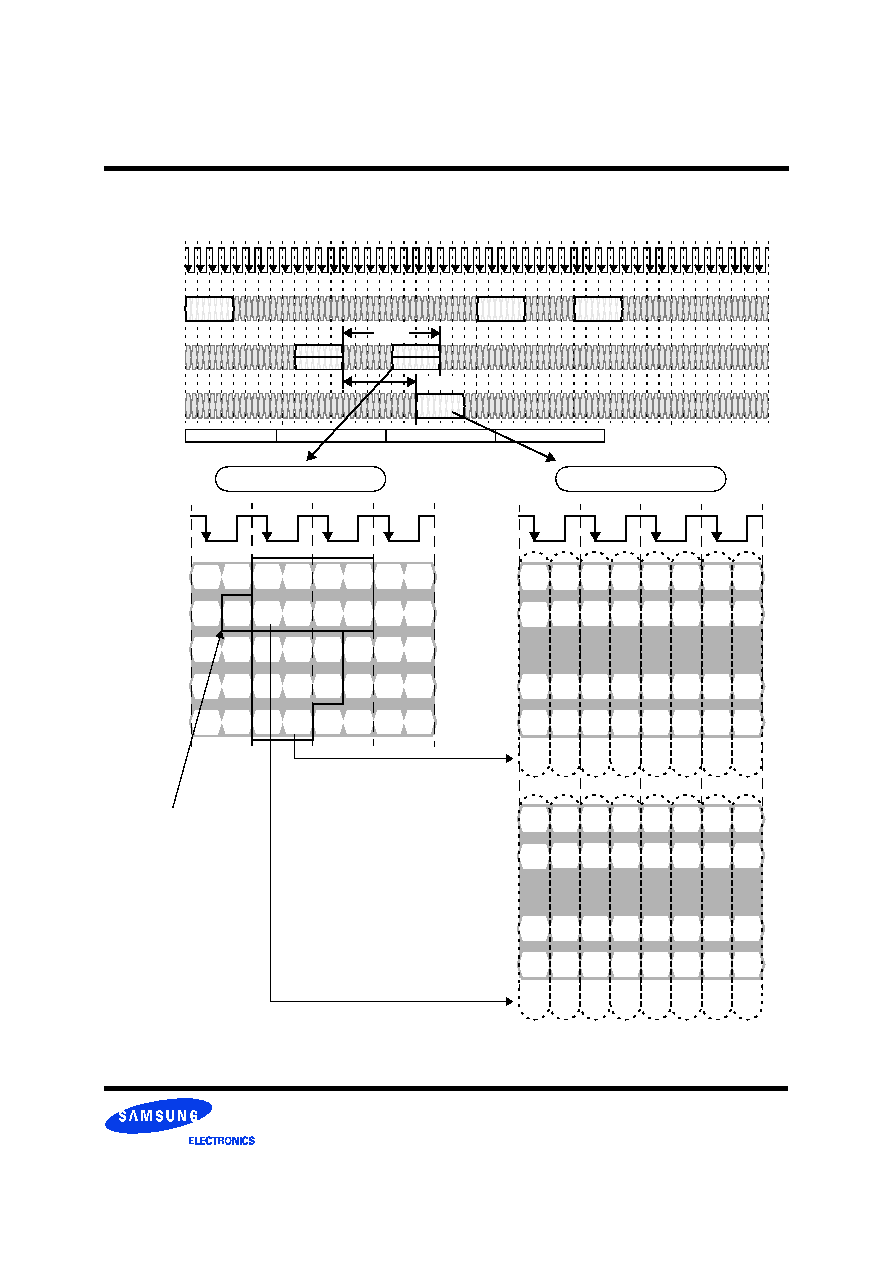
Page 11
Direct RDRAM
TM
K4R881869M
Rev. 0.9 Jan. 2000
Preliminary
Figure 5: Mapping Between COLM Packet and D Packet for WR Command
CTM/CFM
COL4
COL3
COL2
COL1
COL0
T
17
T
18
T
19
T
20
MA7 MA5 MA3 MA1
M=1 MA6 MA4 MA2 MA0
MB7 MB4 MB1
MB6 MB3 MB0
MB5 MB2
CTM/CFM
DQA8..0
DQB8..0
COL4
..COL0
ROW2
..ROW0
T
0
T
4
T
8
T
12
T
1
T
5
T
9
T
13
T
2
T
6
T
10
T
14
T
3
T
7
T
11
T
15
T
16
T
20
T
24
T
28
T
17
T
21
T
25
T
29
T
18
T
22
T
26
T
30
T
19
T
23
T
27
T
31
T
32
T
36
T
40
T
44
T
33
T
37
T
41
T
45
T
34
T
38
T
42
T
46
T
35
T
39
T
43
T
47
MSK (a1)
retire (a1)
WR a1
D (a1)
ACT b0
ACT a0
Transaction a: WR
a0 = {Da,Ba,Ra}
a1 = {Da,Ba,Ca1}
a3 = {Da,Ba}
t
RTR
T
19
T
20
T
21
T
22
CTM/CFM
DQB8
DQB7
DQB1
DQB0
DB71
DB8
DB17 DB26 DB35 DB45 DB53 DB62
DB7
DB16 DB25 DB34 DB44 DB52 DB61 DB70
DB1
DB10 DB19 DB28 DB37 DB46 DB55 DB64
DB0
DB9
DB18 DB27 DB36 DB45 DB54 DB63
COLM Packet
PRER a2
DQA8
DQA7
∑
∑
∑
DQA1
DQA0
D Packet
MB0
DA71
DA8
DA17 DA26 DA35 DA45 DA53 DA62
DA7
DA16 DA25 DA34 DA44 DA52 DA61 DA70
DA1
DA10 DA19 DA28 DA37 DA46 DA55 DA64
DA0
DA9
DA18 DA27 DA36 DA45 DA54 DA63
MA0
MB1
MA1
MB2
MA2
MB3
MA3
MB4
MA4
MB5
MA5
MB6
MA6
MB7
MA7
∑
∑
∑
t
CWD
Each bit of the MB7..MB0 field
controls writing (=1) or no writing
(=0) of the indicated DB bits when
the M bit of the COLM packet is one.
Each bit of the MA7..MA0 field
controls writing (=1) or no writing
(=0) of the indicated DA bits when
the M bit of the COLM packet is one.
When M=1, the MA and MB
fields control writing of
individual data bytes.
When M=0, all data bytes are
written unconditionally.

Page 12
Direct RDRAM
TM
K4R881869M
Rev. 0.9 Jan. 2000
Preliminary
ROW-to-ROW Packet Interaction
Figure 6 shows two packets on the ROW pins separated by
an interval t
RRDELAY
which depends upon the packet
contents. No other ROW packets are sent to banks
{Ba,Ba+1,Ba-1} between packet
"
a
"
and packet
"
b
"
unless
noted otherwise. Table 10 summarizes the t
RRDELAY
values
for all possible cases.
Cases RR1 through RR4 show two successive ACT
commands. In case RR1, there is no restriction since the
ACT commands are to different devices. In case RR2, the
t
RR
restriction applies to the same device with non-adjacent
banks. Cases RR3 and RR4 are illegal (as shown) since bank
Ba needs to be precharged. If a PRER to Ba, Ba+1, or Ba-1
is inserted, t
RRDELAY
is t
RC
(t
RAS
to the PRER command,
and t
RP
to the next ACT).
Cases RR5 through RR8 show an ACT command followed
by a PRER command. In cases RR5 and RR6, there are no
restrictions since the commands are to different devices or to
non-adjacent banks of the same device. In cases RR7 and
RR8, the t
RAS
restriction means the activated bank must wait
before it can be precharged.
Cases RR9 through RR12 show a PRER command followed
by an ACT command. In cases RR9 and RR10, there are
essentially no restrictions since the commands are to
different devices or to non-adjacent banks of the same
device. RR10a and RR10b depend upon whether a bracketed
bank (Ba
±
1) is precharged or activated. In cases RR11 and
RR12, the same and adjacent banks must all wait t
RP
for the
sense amp and bank to precharge before being activated.
Figure 6: ROW-to-ROW Packet Interaction- Timing
CTM/CFM
DQA8..0
DQB8..0
COL4
..COL0
ROW2
..ROW0
T
0
T
4
T
8
T
12
T
1
T
5
T
9
T
13
T
2
T
6
T
10
T
14
T
3
T
7
T
11
T
15
T
16
T
T
17
T
18
T
19
Transaction a: ROPa
Transaction b: ROPb
a0 = {Da,Ba,Ra}
b0= {Db,Bb,Rb}
t
RRDELAY
ROPa a0
ROPb b0
Table 10: ROW-to-ROW Packet Interaction - Rules
Case #
ROPa
Da
Ba
Ra
ROPb
Db
Bb
Rb
t
RRDELAY
Example
RR1
ACT
Da
Ba
Ra
ACT
/= Da
xxxx
x..x
t
PACKET
Figure 11
RR2
ACT
Da
Ba
Ra
ACT
== Da
/= {Ba,Ba+1,Ba-1}
x..x
t
RR
Figure 11
RR3
ACT
Da
Ba
Ra
ACT
== Da
== {Ba+1,Ba-1}
x..x
t
RC
- illegal unless PRER to Ba/Ba+1/Ba-1
Figure 10
RR4
ACT
Da
Ba
Ra
ACT
== Da
== {Ba}
x..x
t
RC
- illegal unless PRER to Ba/Ba+1/Ba-1
Figure 10
RR5
ACT
Da
Ba
Ra
PRER
/= Da
xxxx
x..x
t
PACKET
Figure 11
RR6
ACT
Da
Ba
Ra
PRER
== Da
/= {Ba,Ba+1,Ba-1}
x..x
t
PACKET
Figure 11
RR7
ACT
Da
Ba
Ra
PRER
== Da
== { Ba+1,Ba-1}
x..x
t
RAS
Figure 10
RR8
ACT
Da
Ba
Ra
PRER
== Da
== {Ba}
x..x
t
RAS
Figure 15
RR9
PRER
Da
Ba
Ra
ACT
/= Da
xxxx
x..x
t
PACKET
Figure 12
RR10
PRER
Da
Ba
Ra
ACT
== Da
/= {Ba,Ba
±
1,Ba
±
2}
x..x
t
PACKET
Figure 12
RR10a
PRER
Da
Ba
Ra
ACT
== Da
== {Ba+2}
x..x
t
PACKET
/t
RP
if Ba+1 is precharged/activated.
RR10b
PRER
Da
Ba
Ra
ACT
== Da
== {Ba-2}
x..x
t
PACKET
/t
RP
if Ba-1 is precharged/activated.
RR11
PRER
Da
Ba
Ra
ACT
== Da
== {Ba+1,Ba-1}
x..x
t
RP
Figure 10
RR12
PRER
Da
Ba
Ra
ACT
== Da
== {Ba}
x..x
t
RP
Figure 10
RR13
PRER
Da
Ba
Ra
PRER
/= Da
xxxx
x..x
t
PACKET
Figure 12
RR14
PRER
Da
Ba
Ra
PRER
== Da
/= {Ba,Ba+1,Ba-1}
x..x
t
PP
Figure 12
RR15
PRER
Da
Ba
Ra
PRER
== Da
== {Ba+1,Ba-1}
x..x
t
PP
Figure 12
RR16
PRER
Da
Ba
Ra
PRER
== Da
== Ba
x..x
t
PP
Figure 12
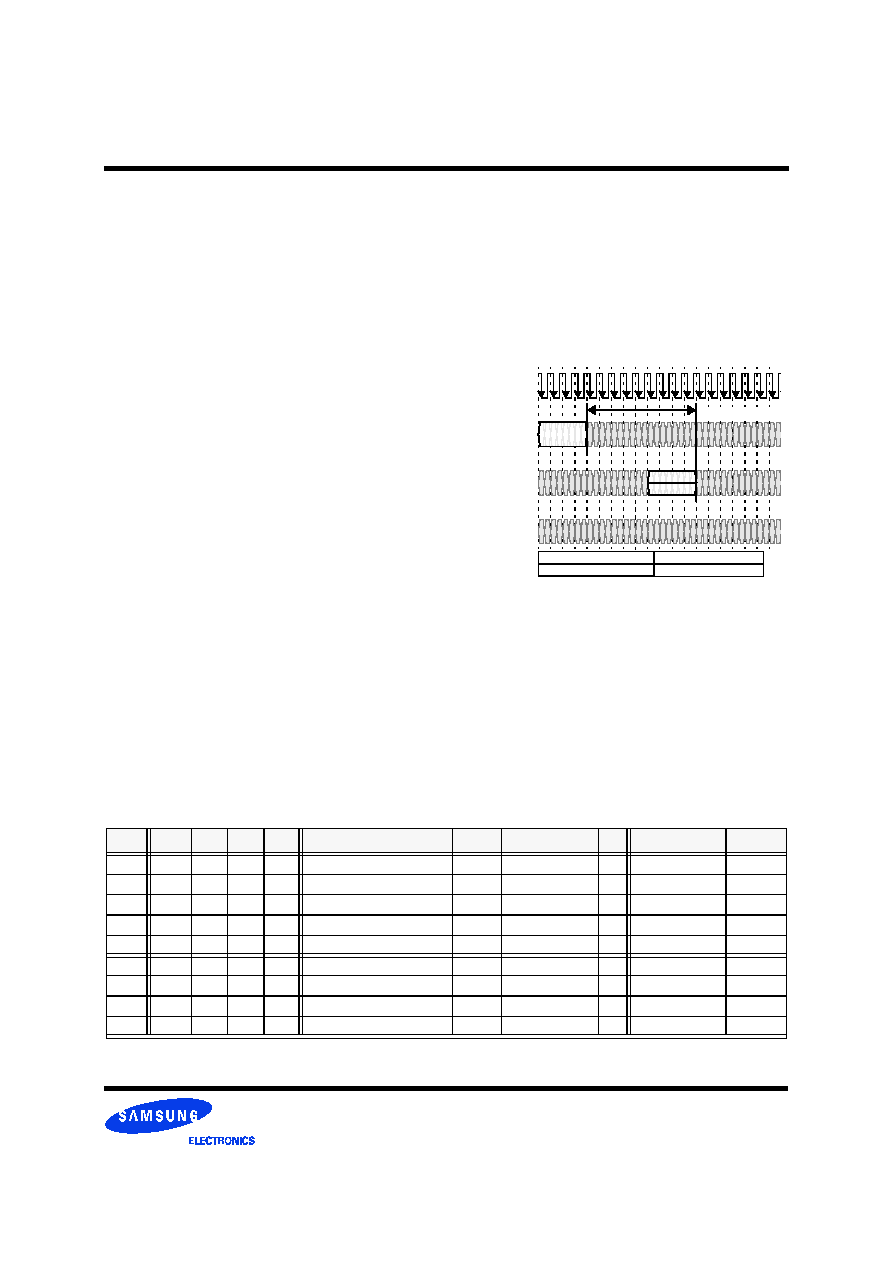
Page 13
Direct RDRAM
TM
K4R881869M
Rev. 0.9 Jan. 2000
Preliminary
ROW-to-ROW Interaction - contin-
ued
Cases RR13 through RR16 summarize the combinations of
two successive PRER commands. In case RR13 there is no
restriction since two devices are addressed. In RR14, t
PP
applies, since the same device is addressed. In RR15 and
RR16, the same bank or an adjacent bank may be given
repeated PRER commands with only the t
PP
restriction.
Two adjacent banks can
'
t be activate simultaneously. A
precharge command to one bank will thus affect the state of
the adjacent banks (and sense amps). If bank Ba is activate
and a PRER is directed to Ba, then bank Ba will be
precharged along with sense amps Ba-1/Ba and Ba/Ba+1. If
bank Ba+1 is activate and a PRER is directed to Ba, then
bank Ba+1 will be precharged along with sense amps
Ba/Ba+1 and Ba+1/Ba+2. If bank Ba-1 is activate and a
PRER is directed to Ba, then bank Ba-1 will be precharged
along with sense amps Ba/Ba-1 and Ba-1/Ba-2.
A ROW packet may contain commands other than ACT or
PRER. The REFA and REFP commands are equivalent to
ACT and PRER for interaction analysis purposes. The inter-
action rules of the NAPR, NAPRC, PDNR, RLXR, ATTN,
TCAL, and TCEN commands are discussed in later sections
(see Table 7 for cross-ref).
ROW-to-COL Packet Interaction
Figure 7 shows two packets on the ROW and COL pins.
They must be separated by an interval t
RCDELAY
which
depends upon the packet contents. Table 11 summarizes the
t
RCDELAY
values for all possible cases. Note that if the COL
packet is earlier than the ROW packet, it is considered a
COL-to-ROW packet interaction.
Cases RC1 through RC5 summarize the rules when the
ROW packet has an ACT command. Figure 15 and
Figure 16 show examples of RC5 - an activation followed by
a read or write. RC4 is an illegal situation, since a read or
write of a precharged banks is being attempted (remember
that for a bank to be activated, adjacent banks must be
precharged). In cases RC1, RC2, and RC3, there is no inter-
action of the ROW and COL packets.
Cases RC6 through RC8 summarize the rules when the
ROW packet has a PRER command. There is either no inter-
action (RC6 through RC9) or an illegal situation with a read
or write of a precharged bank (RC9).
The COL pins can also schedule a precharge operation with
a RDA, WRA, or PREC command in a COLC packet or a
PREX command in a COLX packet. The constraints of these
precharge operations may be converted to equivalent PRER
command constraints using the rules summarized in
Figure 14.
Figure 7: ROW-to-COL Packet Interaction- Timing
CTM/CFM
DQA8..0
DQB8..0
COL4
..COL0
ROW2
..ROW0
T
0
T
4
T
8
T
12
T
1
T
5
T
9
T
13
T
2
T
6
T
10
T
14
T
3
T
7
T
11
T
15
T
16
T
T
17
T
18
T
19
Transaction a: ROPa
Transaction b: COPb
a0 = {Da,Ba,Ra}
b1= {Db,Bb,Cb1}
t
RCDELAY
ROPa a0
COPb b1
Table 11: ROW-to-COL Packet Interaction - Rules
Case #
ROPa
Da
Ba
Ra
COPb
Db
Bb
Cb1
t
RCDELAY
Example
RC1
ACT
Da
Ba
Ra
NOCOP,RD,retire
/= Da
xxxx
x..x
0
RC2
ACT
Da
Ba
Ra
NOCOP
== Da
xxxx
x..x
0
RC3
ACT
Da
Ba
Ra
RD,retire
== Da
/= {Ba,Ba+1,Ba-1}
x..x
0
RC4
ACT
Da
Ba
Ra
RD,retire
== Da
== {Ba+1,Ba-1}
x..x
Illegal
RC5
ACT
Da
Ba
Ra
RD,retire
== Da
== Ba
x..x
t
RCD
Figure 15
RC6
PRER
Da
Ba
Ra
NOCOP,RD,retire
/= Da
xxxx
x..x
0
RC7
PRER
Da
Ba
Ra
NOCOP
== Da
xxxx
x..x
0
RC8
PRER
Da
Ba
Ra
RD,retire
== Da
/= {Ba,Ba+1,Ba-1}
x..x
0
RC9
PRER
Da
Ba
Ra
RD,retire
== Da
== {Ba+1,Ba-1}
x..x
Illegal
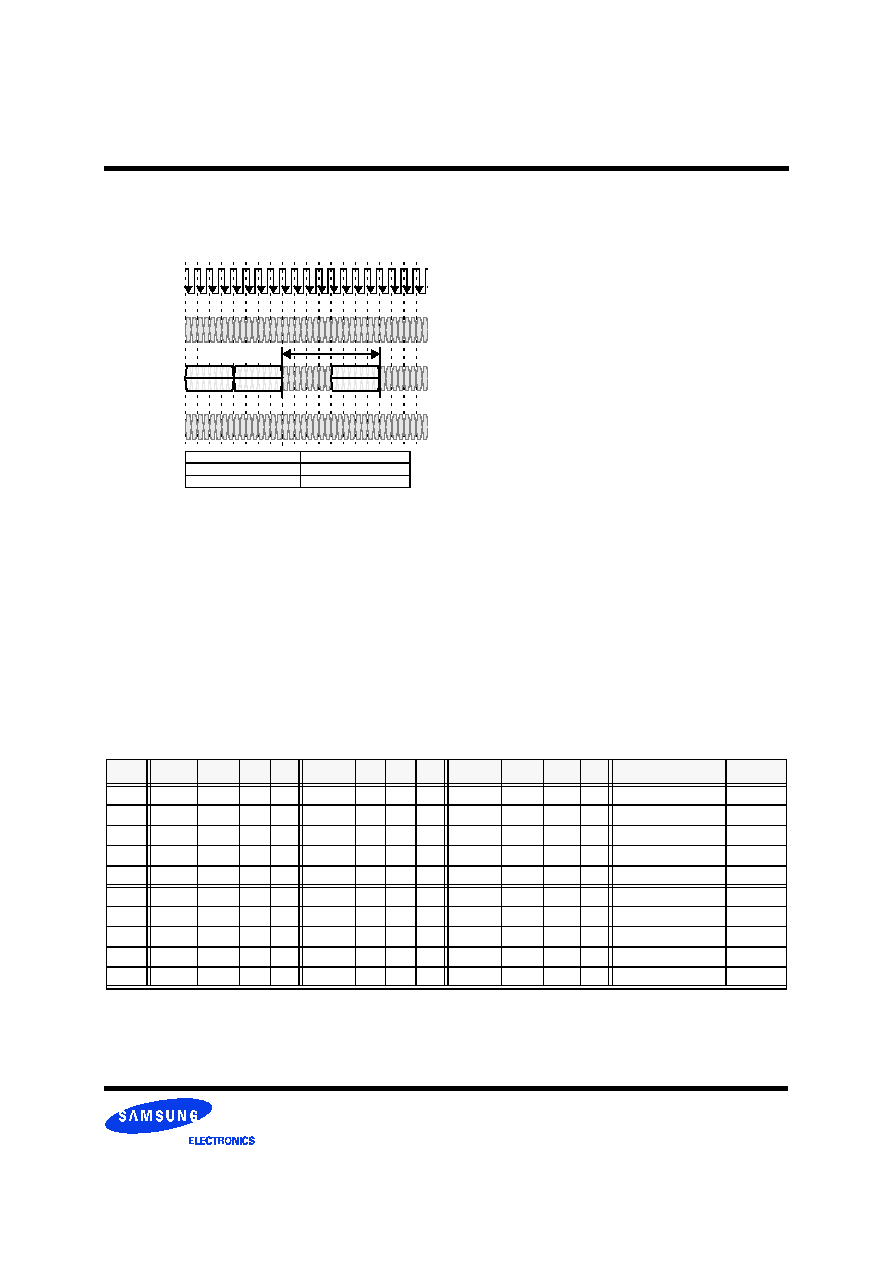
Page 14
Direct RDRAM
TM
K4R881869M
Rev. 0.9 Jan. 2000
Preliminary
COL-to-COL Packet Interaction
Figure 8 shows three arbitrary packets on the COL pins.
Packets
"
b
"
and
"
c
"
must be separated by an interval
t
CCDELAY
which depends upon the command and address
values in all three packets. Table 12 summarizes the
t
CCDELAY
values for all possible cases.
Cases CC1 through CC5 summarize the rules for every situ-
ation other than the case when COPb is a WR command and
COPc is a RD command. In CC3, when a RD command is
followed by a WR command, a gap of t
CAC
-t
CWD
must be
inserted between the two COL packets. See Figure 4 for
more explanation of why this gap is needed. For cases CC1,
CC2, CC4, and CC5, there is no restriction (t
CCDELAY
is
t
CC
).
In cases CC6 through CC10, COPb is a WR command and
COPc is a RD command. The t
CCDELAY
value needed
between these two packets depends upon the command and
address in the packet with COPa. In particular, in case CC6
when there is WR-WR-RD command sequence directed to
the same device, a gap will be needed between the packets
with COPb and COPc. The gap will need a COLC packet
with a NOCOP command directed to any device in order to
force an automatic retire to take place. Figure 18 (right)
provides a more detailed explanation of this case.
In case CC10, there is a RD-WR-RD sequence directed to
the same device. If a prior write to the same device is unre-
tired when COPa is issued, then a gap will be needed
between the packets with COPb and COPc as in case CC6.
The gap will need a COLC packet with a NOCOP command
directed to any device in order to force an automatic retire to
take place.
Cases CC7, CC8, and CC9 have no restriction (t
CCDELAY
is
t
CC
).
For the purposes of analyzing COL-to-ROW interactions,
the PREC, WRA, and RDA commands of the COLC packet
are equivalent to the NOCOP, WR, and RD commands.
These commands also cause a precharge operation PREC to
take place. This precharge may be converted to an equiva-
lent PRER command on the ROW pins using the rules
summarized in Figure 14.
Figure 8: COL-to-COL Packet Interaction- Timing
CTM/CFM
DQA8..0
DQB8..0
COL4
..COL0
ROW2
..ROW0
T
0
T
4
T
8
T
12
T
1
T
5
T
9
T
13
T
2
T
6
T
10
T
14
T
3
T
7
T
11
T
15
T
16
T
T
17
T
18
T
19
COPa a1
Transaction a: COPa
COPc c1
Transaction b: COPb
Transaction c: COPc
a1 = {Da,Ba,Ca1}
b1 = {Db,Bb,Cb1}
c1 = {Dc,Bc,Cc1}
t
CCDELAY
COPb b1
Table 12: COL-to-COL Packet Interaction - Rules
Case #
COPa
Da
Ba
Ca1
COPb
Db
Bb
Cb1
COPc
Dc
Bc
Cc1
t
CCDELAY
Example
CC1
xxxx
xxxxx
x..x
x..x
NOCOP
Db
Bb
Cb1
xxxx
xxxxx
x..x
x..x
t
CC
CC2
xxxx
xxxxx
x..x
x..x
RD,WR
Db
Bb
Cb1
NOCOP
xxxxx
x..x
x..x
t
CC
CC3
xxxx
xxxxx
x..x
x..x
RD
Db
Bb
Cb1
WR
xxxxx
x..x
x..x
t
CC
+t
CAC
-t
CWD
Figure 4
CC4
xxxx
xxxxx
x..x
x..x
RD
Db
Bb
Cb1
RD
xxxxx
x..x
x..x
t
CC
Figure 15
CC5
xxxx
xxxxx
x..x
x..x
WR
Db
Bb
Cb1
WR
xxxxx
x..x
x..x
t
CC
Figure 16
CC6
WR
== Db
x
x..x
WR
Db
Bb
Cb1
RD
== Db
x..x
x..x
t
RTR
Figure 18
CC7
WR
== Db
x
x..x
WR
Db
Bb
Cb1
RD
/= Db
x..x
x..x
t
CC
CC8
WR
/= Db
x
x..x
WR
Db
Bb
Cb1
RD
== Db
x..x
x..x
t
CC
CC9
NOCOP
== Db
x
x..x
WR
Db
Bb
Cb1
RD
== Db
x..x
x..x
t
CC
CC10
RD
== Db
x
x..x
WR
Db
Bb
Cb1
RD
== Db
x..x
x..x
t
CC
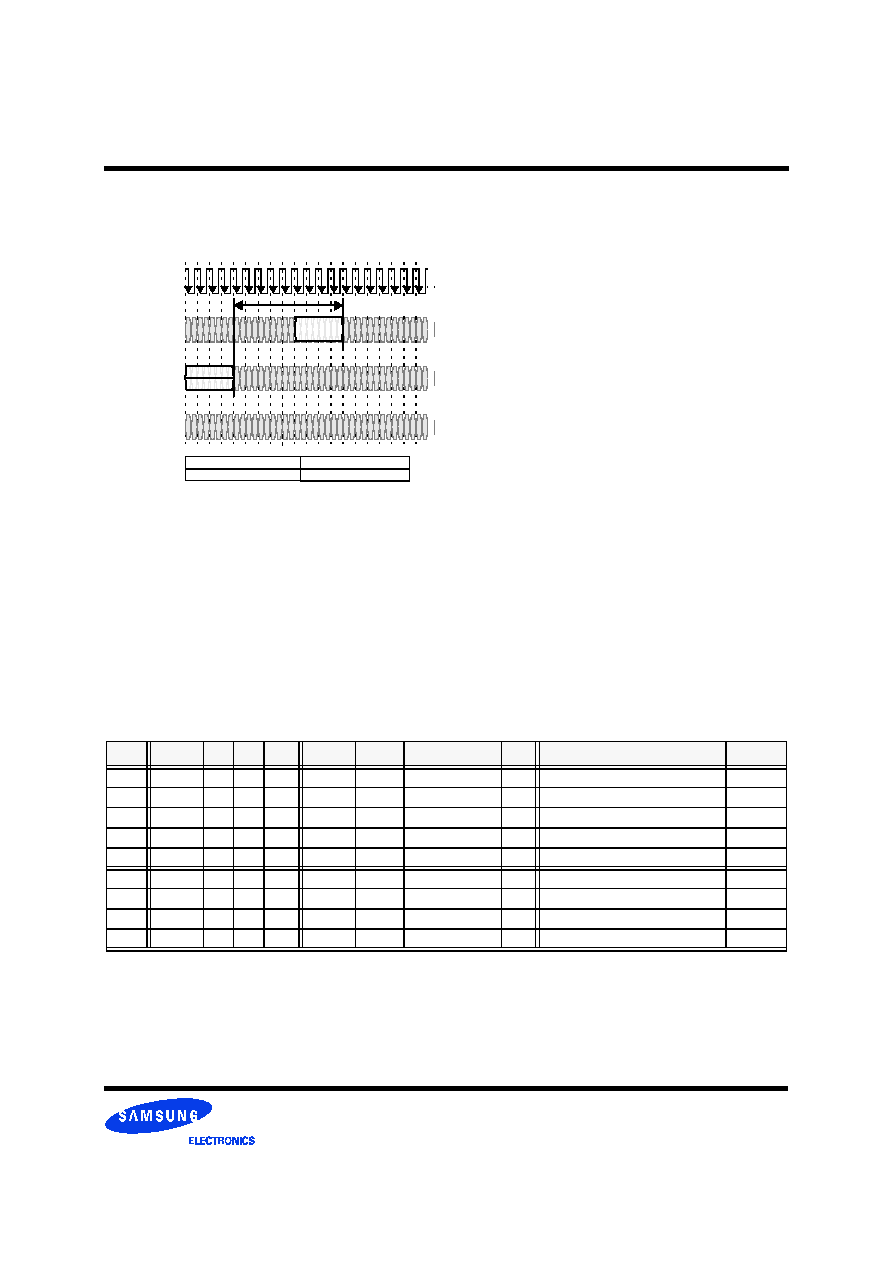
Page 15
Direct RDRAM
TM
K4R881869M
Rev. 0.9 Jan. 2000
Preliminary
COL-to-ROW Packet Interaction
Figure 9 shows arbitrary packets on the COL and ROW pins.
They must be separated by an interval t
CRDELAY
which
depends upon the command and address values in the
packets. Table 13 summarizes the t
CRDELAY
value for all
possible cases.
Cases CR1, CR2, CR3, and CR9 show no interaction
between the COL and ROW packets, either because one of
the commands is a NOP or because the packets are directed
to different devices or to non-adjacent banks.
Case CR4 is illegal because an already-activated bank is to
be re-activated without being precharged Case CR5 is illegal
because an adjacent bank can't be activated or precharged
until bank Ba is precharged first.
In case CR6, the COLC packet contains a RD command, and
the ROW packet contains a PRER command for the same
bank. The t
RDP
parameter specifies the required spacing.
Likewise, in case CR7, the COLC packet causes an auto-
matic retire to take place, and the ROW packet contains a
PRER command for the same bank. The t
RTP
parameter
specifies the required spacing.
Case CR8 is labeled
"
Hazardous
"
because a WR command
should always be followed by an automatic retire before a
precharge is scheduled. Figure 19 shows an example of what
can happen when the retire is not able to happen before the
precharge.
For the purposes of analyzing COL-to-ROW interactions,
the PREC, WRA, and RDA commands of the COLC packet
are equivalent to the NOCOP, WR, and RD commands.
These commands also cause a precharge operation to take
place. This precharge may converted to an equivalent PRER
command on the ROW pins using the rules summarized in
Figure 14.
A ROW packet may contain commands other than ACT or
PRER. The REFA and REFP commands are equivalent to
ACT and PRER for interaction analysis purposes. The inter-
action rules of the NAPR, PDNR, and RLXR commands are
discussed in a later section.
Figure 9: COL-to-ROW Packet Interaction- Timing
CTM/CFM
DQA8..0
DQB8..0
COL4
..COL0
ROW2
..ROW0
T
0
T
4
T
8
T
12
T
1
T
5
T
9
T
13
T
2
T
6
T
10
T
14
T
3
T
7
T
11
T
15
T
16
T
T
17
T
18
T
19
Transaction a: COPa
Transaction b: ROPb
a1= {Da,Ba,Ca1}
b0= {Db,Bb,Rb}
t
CRDELAY
ROPb b0
COPa a1
Table 13: COL-to-ROW Packet Interaction - Rules
Case #
COPa
Da
Ba
Ca1
ROPb
Db
Bb
Rb
t
CRDELAY
Example
CR1
NOCOP
Da
Ba
Ca1
x..x
xxxxx
xxxx
x..x
0
CR2
RD/WR
Da
Ba
Ca1
x..x
/= Da
xxxx
x..x
0
CR3
RD/WR
Da
Ba
Ca1
x..x
== Da
/= {Ba,Ba+1,Ba-1}
x..x
0
CR4
RD/WR
Da
Ba
Ca1
ACT
== Da
== {Ba}
x..x
Illegal
CR5
RD/WR
Da
Ba
Ca1
ACT
== Da
== {Ba+1,Ba-1}
x..x
Illegal
CR6
RD
Da
Ba
Ca1
PRER
== Da
== {Ba,Ba+1,Ba-1}
x..x
t
RDP
Figure 15
CR7
retire
a
Da
Ba
Ca1
PRER
== Da
== {Ba,Ba+1,Ba-1}
x..x
t
RTP
Figure 16
CR8
WR
b
Da
Ba
Ca1
PRER
== Da
== {Ba,Ba+1,Ba-1}
x..x
0
Figure 19
CR9
xxxx
Da
Ba
Ca1
NOROP
xxxxx
xxxx
x..x
0
a. This is any command which permits the write buffer of device Da to retire (see Table 8).
"
Ba
"
is the bank address in the write buffer.
b. This situation is hazardous because the write buffer will be left unretired while the targeted bank is precharged. See Figure 19.

Page 16
Direct RDRAM
TM
K4R881869M
Rev. 0.9 Jan. 2000
Preliminary
ROW-to-ROW Examples
Figure 10 shows examples of some of the the ROW-to-
ROW packet spacings from Table 10. A complete sequence
of activate and precharge commands is directed to a bank.
The RR8 and RR12 rules apply to this sequence. In addition
to satisfying the t
RAS
and t
RP
timing parameters, the separa-
tion between ACT commands to the same bank must also
satisfy the t
RC
timing parameter (RR4).
When a bank is activated, it is necessary for adjacent banks
to remain precharged. As a result, the adjacent banks will
also satisfy parallel timing constraints; in the example, the
RR11 and RR3 rules are analogous to the RR12 and RR4
rules.
Figure 11 shows examples of the ACT-to-ACT (RR1, RR2)
and ACT-to-PRER (RR5, RR6) command spacings from
Table 10. In general, the commands in ROW packets may be
spaced an interval t
PACKET
apart unless they are directed to
the same or adjacent banks or unless they are a similar
command type (both PRER or both ACT) directed to the
same device.
Figure 10: Row Packet Example
CTM/CFM
DQA8..0
DQB8..0
COL4
..COL0
ROW2
..ROW0
T
0
T
4
T
8
T
12
T
1
T
5
T
9
T
13
T
2
T
6
T
10
T
14
T
3
T
7
T
11
T
15
T
16
T
20
T
24
T
28
T
17
T
21
T
25
T
29
T
18
T
22
T
26
T
30
T
19
T
23
T
27
T
31
T
32
T
36
T
40
T
44
T
33
T
37
T
41
T
45
T
34
T
38
T
42
T
46
T
35
T
39
T
43
T
47
ACT a0
PRER a1
t
RAS
t
RC
a0 = {Da,Ba,Ra}
a1 = {Da,Ba+1}
b0 = {Da,Ba+1,Rb}
Same Device
Adjacent Bank
RR7
t
RP
Same Device
Adjacent Bank
RR11
ACT b0
b0 = {Da,Ba,Rb}
Same Device
Same Bank
RR12
b0 = {Da,Ba+1,Rb}
Same Device
Adjacent Bank
RR3
b0 = {Da,Ba,Rb}
Same Device
Same Bank
RR4
Figure 11: Row Packet Example
CTM/CFM
DQA8..0
DQB8..0
COL4
..COL0
ROW2
..ROW0
T
0
T
4
T
8
T
12
T
1
T
5
T
9
T
13
T
2
T
6
T
10
T
14
T
3
T
7
T
11
T
15
T
16
T
20
T
24
T
28
T
17
T
21
T
25
T
29
T
18
T
22
T
26
T
30
T
19
T
23
T
27
T
31
T
32
T
36
T
40
T
44
T
33
T
37
T
41
T
45
T
34
T
38
T
42
T
46
T
35
T
39
T
43
T
47
ACT a0
PRER b0
t
PACKET
ACT c0
t
RR
a0 = {Da,Ba,Ra}
b0 = {Db,Bb,Rb}
c0 = {Da,Bc,Rc}
Different Device
Any Bank
Same Device
Non-adjacent Bank
RR1
RR2
ACT a0
ACT a0
ACT b0
PRER c0
b0 = {Db,Bb,Rb}
c0 = {Da,Bc,Rc}
Different Device
Any Bank
Same Device
Non-adjacent Bank
RR5
RR6
ACT a0
t
PACKET
t
PACKET
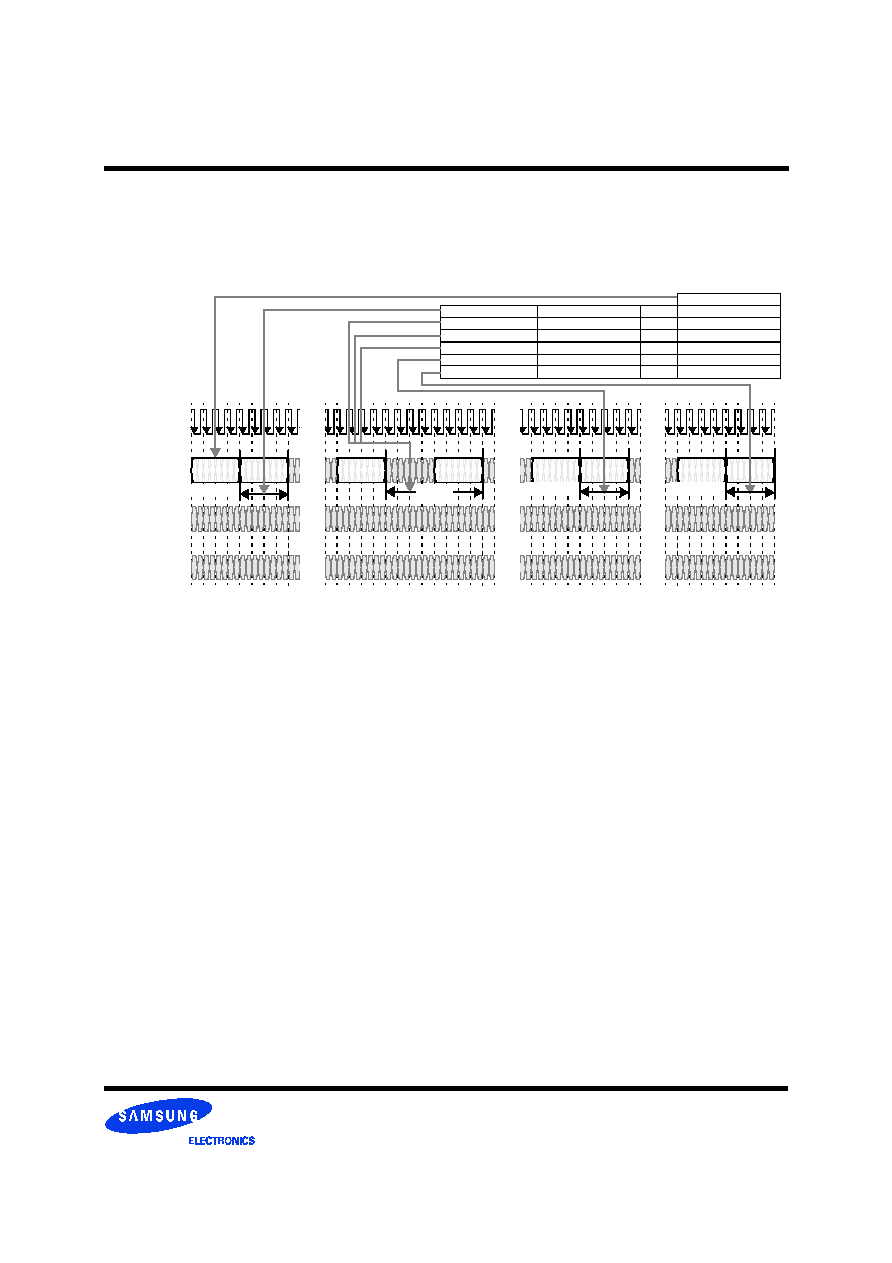
Page 17
Direct RDRAM
TM
K4R881869M
Rev. 0.9 Jan. 2000
Preliminary
Figure 12 shows examples of the PRER-to-PRER (RR13,
RR14) and PRER-to-ACT (RR9, RR10) command spacings
from Table 10. The RR15 and RR16 cases (PRER-to-PRER
to same or adjacent banks) are not shown, but are similar to
RR14. In general, the commands in ROW packets may be
spaced an interval t
PACKET
apart unless they are directed to
the same or adjacent banks or unless they are a similar
command type (both PRER or both ACT) directed to the
same device.
Row and Column Cycle Description
Activate: A row cycle begins with the activate (ACT) opera-
tion. The activation process is destructive; the act of sensing
the value of a bit in a bank's storage cell transfers the bit to
the sense amp, but leaves the original bit in the storage cell
with an incorrect value.
Restore: Because the activation process is destructive, a
hidden operation called restore is automatically performed.
The restore operation rewrites the bits in the sense amp back
into the storage cells of the activated row of the bank.
Read/Write: While the restore operation takes place, the
sense amp may be read (RD) and written (WR) using
column operations. If new data is written into the sense amp,
it is automatically forwarded to the storage cells of the bank
so the data in the activated row and the data in the sense amp
remain identical.
Precharge: When both the restore operation and the column
operations are completed, the sense amp and bank are
precharged (PRE). This leaves them in the proper state to
begin another activate operation.
Intervals: The activate operation requires the interval
t
RCD,MIN
to complete. The hidden restore operation requires
the interval t
RAS,MIN
- t
RCD,MIN
to complete. Column read
and write operations are also performed during the t
RAS,MIN
- t
RCD,MIN
interval (if more than about four column opera-
tions are performed, this interval must be increased). The
precharge operation requires the interval t
RP,MIN
to
complete.
Adjacent Banks: An RDRAM with a
"
s
"
designation
(512Kx32sx18) indicates it contains
"
split banks
"
. This
means the sense amps are shared between two adjacent
banks. The only exception is that sense amp 0, 15, 30, and
31 are not shared. When a row in a bank is activated, the two
adjacent sense amps are connected to (associated with) that
bank and are not available for use by the two adjacent banks.
These two adjacent banks must remain precharged while the
selected bank goes through its activate, restore, read/write,
and precharge operations.
For example (referring to the block diagram of Figure 2), if
bank 5 is accessed, sense amp 4/5 and sense amp 5/6 will
both be loaded with one of the 512 rows (with 1024 bytes
loaded into each sense amp from the 2Kbyte row - 512 bytes
to the DQA side and 512 bytes to the DQB side). While this
row from bank 5 is being accessed, no rows may be accessed
in banks 4 or 6 because of the sense amp sharing.
Figure 12: Row Packet Examples
CTM/CFM
DQA8..0
DQB8..0
COL4
..COL0
ROW2
..ROW0
T
0
T
4
T
8
T
12
T
1
T
5
T
9
T
13
T
2
T
6
T
10
T
14
T
3
T
7
T
11
T
15
T
16
T
20
T
24
T
28
T
17
T
21
T
25
T
29
T
18
T
22
T
26
T
30
T
19
T
23
T
27
T
31
T
32
T
36
T
40
T
44
T
33
T
37
T
41
T
45
T
34
T
38
T
42
T
46
T
35
T
39
T
43
T
47
PRER a0
ACT b0
t
PACKET
PRER c0
a0 = {Da,Ba,Ra}
b0 = {Db,Bb,Rb}
c0 = {Da,Bc,Rc}
Different Device
Any Bank
Same Device
Non-adjacent Bank
RR13
RR14
PRER a0
PRER a0
PRER b0
ACT c0
b0 = {Db,Bb,Rb}
c0 = {Da,Bc,Rc}
Different Device
Any Bank
Same Device
Non-adjacent Bank
RR9
RR10
PRER a0
c0 = {Da,Ba+1Rc}
Same Device
Same Bank
RR16
c0 = {Da,Ba,Rc}
Same Device
Adjacent Bank
RR15
t
PP
t
PACKET
t
PACKET

Page 18
Direct RDRAM
TM
K4R881869M
Rev. 0.9 Jan. 2000
Preliminary
Precharge Mechanisms
Figure 13 shows an example of precharge with the ROWR
packet mechanism. The PRER command must occur a time
t
RAS
after the ACT command, and a time t
RP
before the next
ACT command. This timing will serve as a baseline aginst
which the other precharge mechanisms can be compared.
Figure 14 (top) shows an example of precharge with a RDA
command. A bank is activated with an ROWA packet on the
ROW pins. Then, a series of four dualocts are read with RD
commands in COLC packets on the COL pins. The fourth of
these commands is a RDA, which causes the bank to auto-
matically precharge when the final read has finished. The
timing of this automatic precharge is equivalent to a PRER
command in an ROWR packet on the ROW pins that is
offset a time t
OFFP
from the COLC packet with the RDA
command. The RDA command should be treated as a RD
command in a COLC packet as well as a simultaneous (but
offset) PRER command in an ROWR packet when analyzing
interactions with other packets.
Figure 14 (middle) shows an example of precharge with a
WRA command. As in the RDA example, a bank is acti-
vated with an ROWA packet on the ROW pins. Then, two
dualocts are written with WR commands in COLC packets
on the COL pins. The second of these commands is a WRA,
which causes the bank to automatically precharge when the
final write has been retired. The timing of this automatic
precharge is equivalent to a PRER command in an ROWR
packet on the ROW pins that is offset a time t
OFFP
from the
COLC packet that causes the automatic retire. The WRA
command should be treated as a WR command in a COLC
packet as well as a simultaneous (but offset) PRER
command in an ROWR packet when analyzing interactions
with other packets. Note that the automatic retire is triggered
by a COLC packet a time t
RTR
after the COLC packet with
the WR command unless the second COLC contains a RD
command to the same device. This is described in more
detail in Figure 17.
Figure 14 (bottom) shows an example of precharge with a
PREX command in an COLX packet. A bank is activated
with an ROWA packet on the ROW pins. Then, a series of
four dualocts are read with RD commands in COLC packets
on the COL pins. The fourth of these COLC packets
includes an COLX packet with a PREX command. This
causes the bank to precharge with timing equivalent to a
PRER command in an ROWR packet on the ROW pins that
is offset a time t
OFFP
from the COLX packet with the PREX
command.
Figure 13: Precharge via PRER Command in ROWR Packet
CTM/CFM
DQA8..0
DQB8..0
COL4
..COL0
ROW2
..ROW0
T
0
T
4
T
8
T
12
T
1
T
5
T
9
T
13
T
2
T
6
T
10
T
14
T
3
T
7
T
11
T
15
T
16
T
20
T
24
T
28
T
17
T
21
T
25
T
29
T
18
T
22
T
26
T
30
T
19
T
23
T
27
T
31
T
32
T
36
T
40
T
44
T
33
T
37
T
41
T
45
T
34
T
38
T
42
T
46
T
35
T
39
T
43
T
47
ACT a0
PRER a5
t
RAS
t
RC
a0 = {Da,Ba,Ra}
a5 = {Da,Ba}
b0 = {Da,Ba,Rb}
t
RP
ACT b0
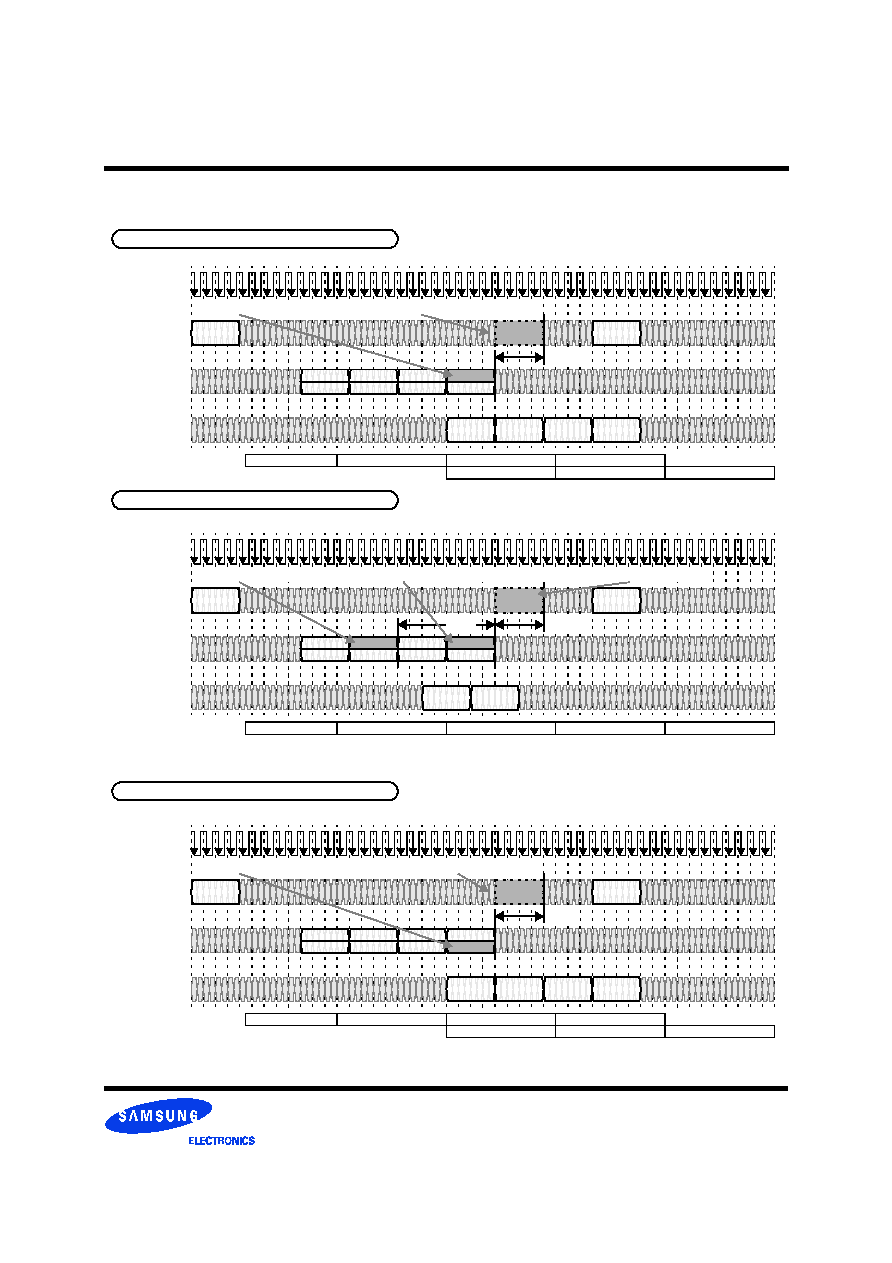
Page 19
Direct RDRAM
TM
K4R881869M
Rev. 0.9 Jan. 2000
Preliminary
Figure 14: Offsets for Alternate Precharge Mechanisms
CTM/CFM
DQA8..0
DQB8..0
COL4
..COL0
ROW2
..ROW0
T
0
T
4
T
8
T
12
T
1
T
5
T
9
T
13
T
2
T
6
T
10
T
14
T
3
T
7
T
11
T
15
T
16
T
20
T
24
T
28
T
17
T
21
T
25
T
29
T
18
T
22
T
26
T
30
T
19
T
23
T
27
T
31
T
32
T
36
T
40
T
44
T
33
T
37
T
41
T
45
T
34
T
38
T
42
T
46
T
35
T
39
T
43
T
47
CTM/CFM
DQA8..0
DQB8..0
COL4
..COL0
ROW2
..ROW0
T
0
T
4
T
8
T
12
T
1
T
5
T
9
T
13
T
2
T
6
T
10
T
14
T
3
T
7
T
11
T
15
T
16
T
20
T
24
T
28
T
17
T
21
T
25
T
29
T
18
T
22
T
26
T
30
T
19
T
23
T
27
T
31
T
32
T
36
T
40
T
44
T
33
T
37
T
41
T
45
T
34
T
38
T
42
T
46
T
35
T
39
T
43
T
47
CTM/CFM
DQA8..0
DQB8..0
COL4
..COL0
ROW2
..ROW0
T
0
T
4
T
8
T
12
T
1
T
5
T
9
T
13
T
2
T
6
T
10
T
14
T
3
T
7
T
11
T
15
T
16
T
20
T
24
T
28
T
17
T
21
T
25
T
29
T
18
T
22
T
26
T
30
T
19
T
23
T
27
T
31
T
32
T
36
T
40
T
44
T
33
T
37
T
41
T
45
T
34
T
38
T
42
T
46
T
35
T
39
T
43
T
47
RD a1
ACT a0
RD a2
Q (a2)
Q (a1)
ACT b0
MSK (a2)
MSK (a1)
retire (a1)
t
OFFP
WR a1
D (a2)
D (a1)
ACT b0
ACT a0
Transaction a: RD
a0 = {Da,Ba,Ra}
a5 = {Da,Ba}
COLC Packet: RDA Precharge Offset
COLC Packet: WDA Precharge Offset
Transaction a: WR
a0 = {Da,Ba,Ra}
a1 = {Da,Ba,Ca1}
a2 = {Da,Ba,Ca2}
a5 = {Da,Ba}
COLX Packet: PREX Precharge Offset
RD a3
Q (a4)
Q (a3)
RDA a4
PRER a5
The RDA precharge is equivalent to a PRER command here
t
OFFP
PRER a5
The WRA precharge (triggered by the automatic retire) is equivalent to a PRER command here
WRA a2
retire (a2)
t
RTR
a3 = {Da,Ba,Ca3}
a4 = {Da,Ba,Ca4}
a1 = {Da,Ba,Ca1}
a2 = {Da,Ba,Ca2}
RD a1
ACT a0
RD a2
Q (a2)
Q (a1)
ACT b0
t
OFFP
Transaction a: RD
a0 = {Da,Ba,Ra}
a5 = {Da,Ba}
RD a3
Q (a4)
Q (a3)
PRER a5
The PREX precharge command is equivalent to a PRER command here
a3 = {Da,Ba,Ca3}
a4 = {Da,Ba,Ca4}
a1 = {Da,Ba,Ca1}
a2 = {Da,Ba,Ca2}
RD a4
PREX a5
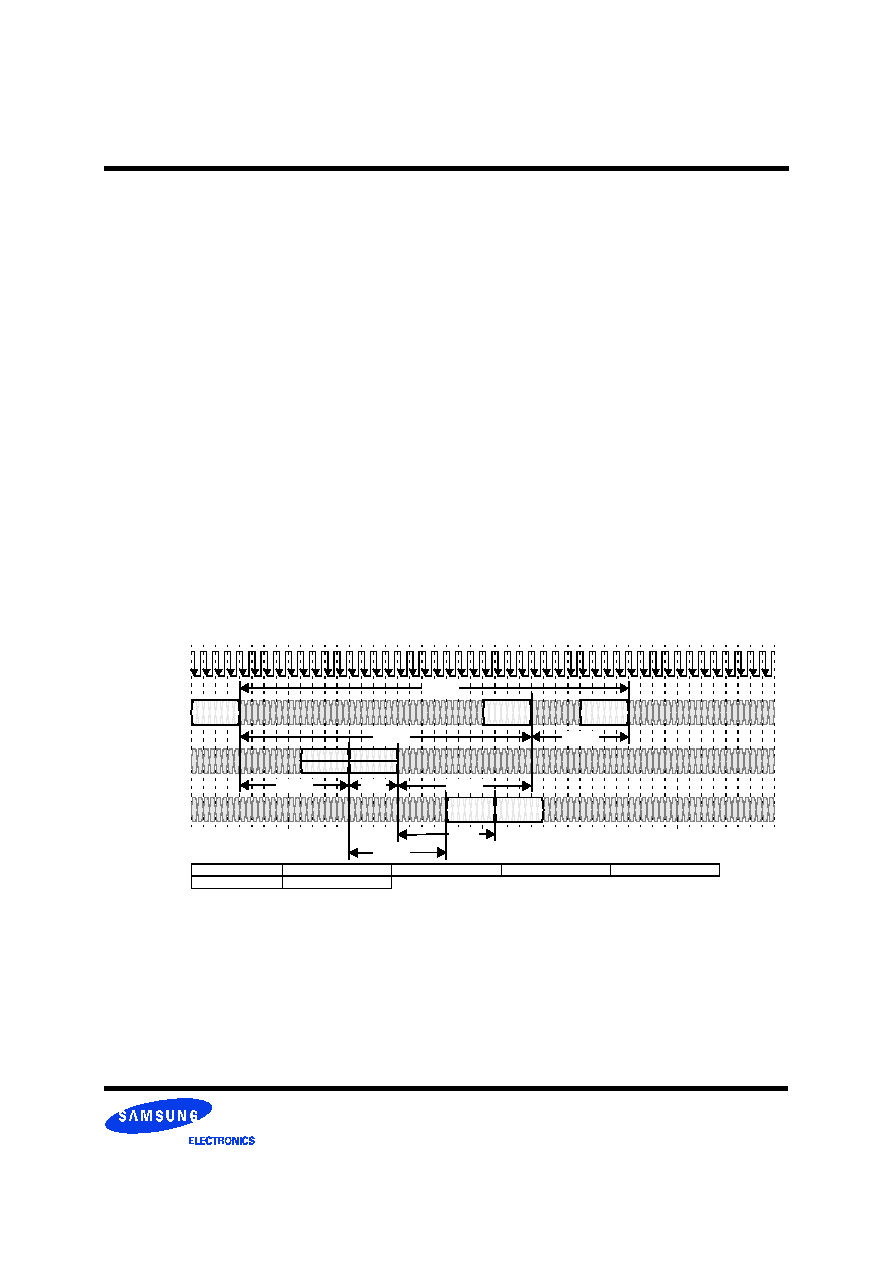
Page 20
Direct RDRAM
TM
K4R881869M
Rev. 0.9 Jan. 2000
Preliminary
Read Transaction - Example
Figure 15 shows an example of a read transaction. It begins
by activating a bank with an ACT a0 command in an ROWA
packet. A time t
RCD
later a RD a1 command is issued in a
COLC packet. Note that the ACT command includes the
device, bank, and row address (abbreviated as a0) while the
RD command includes device, bank, and column address
(abbreviated as a1). A time t
CAC
after the RD command the
read data dualoct Q(a1) is returned by the device. Note that
the packets on the ROW and COL pins use the end of the
packet as a timing reference point, while the packets on the
DQA/DQB pins use the beginning of the packet as a timing
reference point.
A time t
CC
after the first COLC packet on the COL pins a
second is issued. It contains a RD a2 command. The a2
address has the same device and bank address as the a1
address (and a0 address), but a different column address. A
time t
CAC
after the second RD command a second read data
dualoct Q(a2) is returned by the device.
Next, a PRER a3 command is issued in an ROWR packet on
the ROW pins. This causes the bank to precharge so that a
different row may be activated in a subsequent transaction or
so that an adjacent bank may be activated. The a3 address
includes the same device and bank address as the a0, a1, and
a2 addresses. The PRER command must occur a time t
RAS
or more after the original ACT command (the activation
operation in any DRAM is destructive, and the contents of
the selected row must be restored from the two associated
sense amps of the bank during the t
RAS
interval). The PRER
command must also occur a time t
RDP
or more after the last
RD command. Note that the t
RDP
value shown is greater
than the t
RDP,MIN
specification in Table 22. This transaction
example reads two dualocts, but there is actually enough
time to read three dualocts before t
RDP
becomes the limiting
parameter rather than t
RAS
. If four dualocts were read, the
packet with PRER would need to shift right (be delayed) by
one t
CYCLE
(note - this case is not shown).
Finally, an ACT b0 command is issued in an ROWR packet
on the ROW pins. The second ACT command must occur a
time t
RC
or more after the first ACT command and a time t
RP
or more after the PRER command. This ensures that the
bank and its associated sense amps are precharged. This
example assumes that the second transaction has the same
device and bank address as the first transaction, but a
different row address. Transaction b may not be started until
transaction a has finished. However, transactions to other
banks or other devices may be issued during transaction a.
Figure 15: Read Transaction Example
CTM/CFM
DQA8..0
DQB8..0
COL4
..COL0
ROW2
..ROW0
T
0
T
4
T
8
T
12
T
1
T
5
T
9
T
13
T
2
T
6
T
10
T
14
T
3
T
7
T
11
T
15
T
16
T
20
T
24
T
28
T
17
T
21
T
25
T
29
T
18
T
22
T
26
T
30
T
19
T
23
T
27
T
31
T
32
T
36
T
40
T
44
T
33
T
37
T
41
T
45
T
34
T
38
T
42
T
46
T
35
T
39
T
43
T
47
RD a1
ACT a0
PRER a3
RD a2
Q (a2)
t
RCD
t
CAC
t
CC
Q (a1)
ACT b0
t
RAS
t
RC
t
RP
Transaction a: RD
a0 = {Da,Ba,Ra}
a1 = {Da,Ba,Ca1}
a2 = {Da,Ba,Ca2}
a3 = {Da,Ba}
t
CAC
t
RDP
Transaction b: xx
b0 = {Da,Ba,Rb}
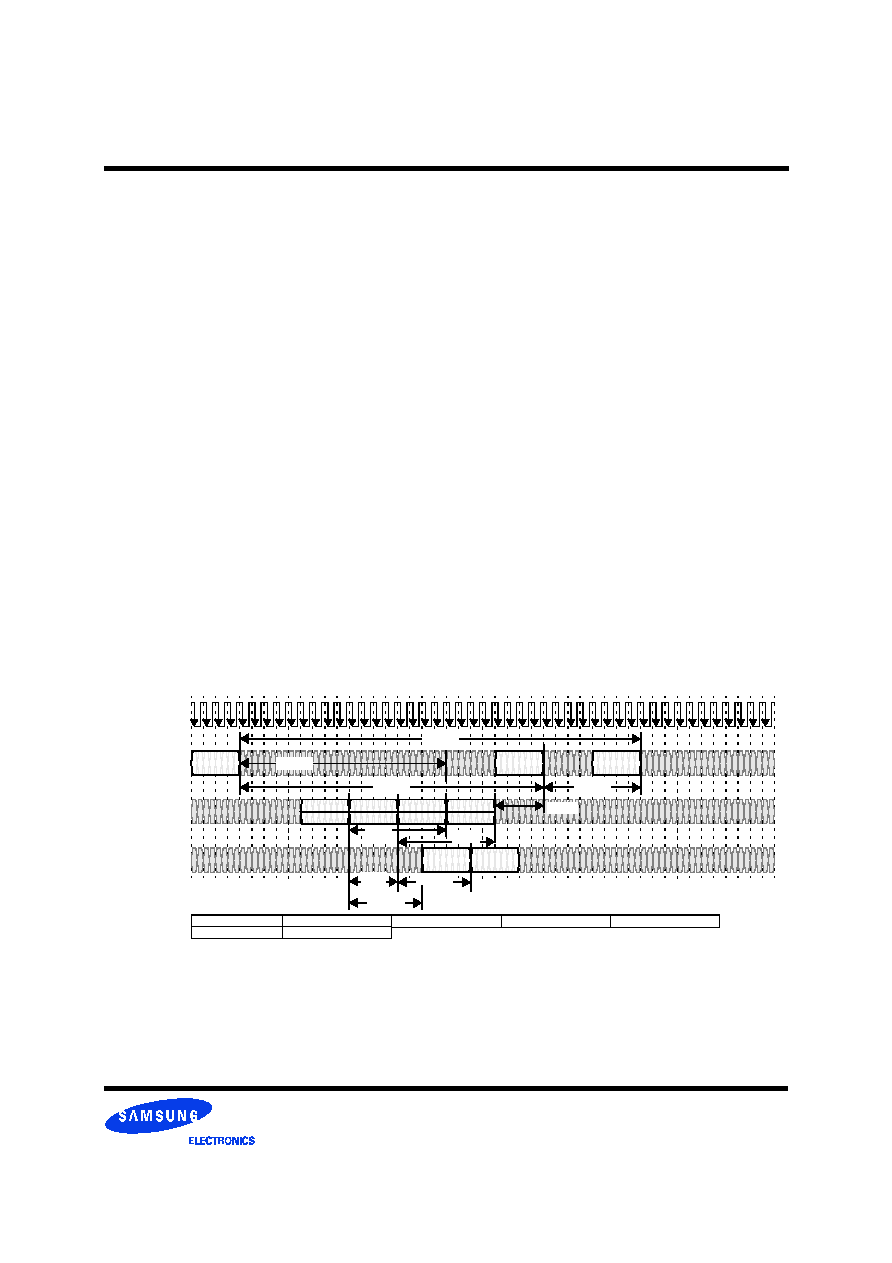
Page 21
Direct RDRAM
TM
K4R881869M
Rev. 0.9 Jan. 2000
Preliminary
Write Transaction - Example
Figure 16 shows an example of a write transaction. It begins
by activating a bank with an ACT a0 command in an ROWA
packet. A time t
RCD
-t
RTR
later a WR a1 command is issued
in a COLC packet (note that the t
RCD
interval is measured to
the end of the COLC packet with the first retire command).
Note that the ACT command includes the device, bank, and
row address (abbreviated as a0) while the WR command
includes device, bank, and column address (abbreviated as
a1). A time t
CWD
after the WR command the write data
dualoct D(a1) is issued. Note that the packets on the ROW
and COL pins use the end of the packet as a timing reference
point, while the packets on the DQA/DQB pins use the
beginning of the packet as a timing reference point.
A time t
CC
after the first COLC packet on the COL pins a
second COLC packet is issued. It contains a WR a2
command. The a2 address has the same device and bank
address as the a1 address (and a0 address), but a different
column address. A time t
CWD
after the second WR
command a second write data dualoct D(a2) is issued.
A time t
RTR
after each WR command an optional COLM
packet MSK (a1) is issued, and at the same time a COLC
packet is issued causing the write buffer to automatically
retire. See Figure 17 for more detail on the write/retire
mechanism. If a COLM packet is not used, all data bytes are
unconditionally written. If the COLC packet which causes
the write buffer to retire is delayed, then the COLM packet
(if used) must also be delayed.
Next, a PRER a3 command is issued in an ROWR packet on
the ROW pins. This causes the bank to precharge so that a
different row may be activated in a subsequent transaction or
so that an adjacent bank may be activated. The a3 address
includes the same device and bank address as the a0, a1, and
a2 addresses. The PRER command must occur a time t
RAS
or more after the original ACT command (the activation
operation in any DRAM is destructive, and the contents of
the selected row must be restored from the two associated
sense amps of the bank during the t
RAS
interval).
A PRER a3 command is issued in an ROWR packet on the
ROW pins. The PRER command must occur a time t
RTP
or
more after the last COLC which causes an automatic retire.
Finally, an ACT b0 command is issued in an ROWR packet
on the ROW pins. The second ACT command must occur a
time t
RC
or more after the first ACT command and a time t
RP
or more after the PRER command. This ensures that the
bank and its associated sense amps are precharged. This
example assumes that the second transaction has the same
device and bank address as the first transaction, but a
different row address. Transaction b may not be started until
transaction a has finished. However, transactions to other
banks or other devices may be issued during transaction a.
Figure 16: Write Transaction Example
CTM/CFM
DQA8..0
DQB8..0
COL4
..COL0
ROW2
..ROW0
T
0
T
4
T
8
T
12
T
1
T
5
T
9
T
13
T
2
T
6
T
10
T
14
T
3
T
7
T
11
T
15
T
16
T
20
T
24
T
28
T
17
T
21
T
25
T
29
T
18
T
22
T
26
T
30
T
19
T
23
T
27
T
31
T
32
T
36
T
40
T
44
T
33
T
37
T
41
T
45
T
34
T
38
T
42
T
46
T
35
T
39
T
43
T
47
MSK (a2)
retire (a2)
MSK (a1)
retire (a1)
WR a1
PRER a3
WR a2
D (a2)
t
RCD
D (a1)
ACT b0
t
RC
t
RP
ACT a0
t
CWD
Transaction a: WR
a0 = {Da,Ba,Ra}
a1 = {Da,Ba,Ca1}
a2 = {Da,Ba,Ca2}
a3 = {Da,Ba}
t
CC
t
CWD
t
RTR
t
RAS
t
RTR
t
RTP
Transaction b: xx
b0 = {Da,Ba,Rb}
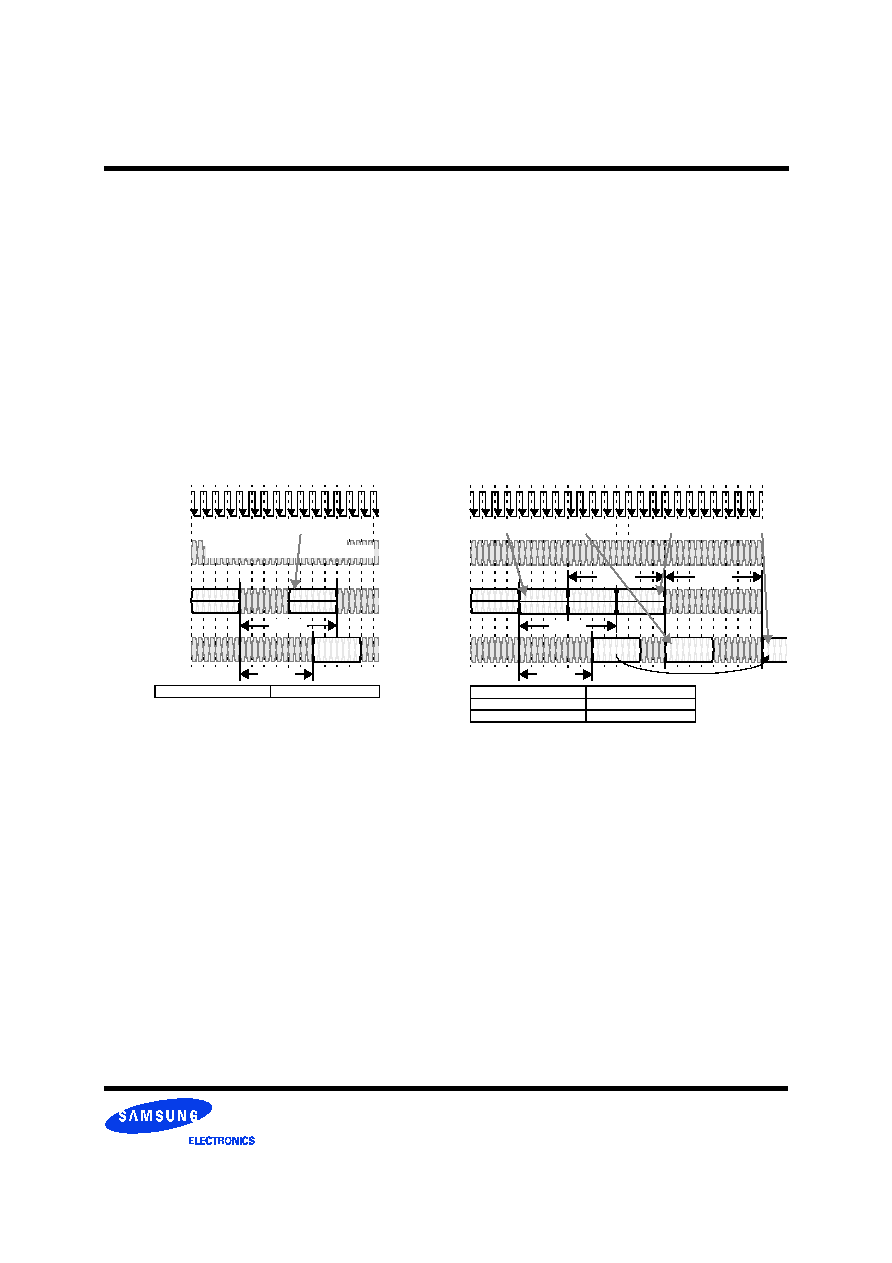
Page 22
Direct RDRAM
TM
K4R881869M
Rev. 0.9 Jan. 2000
Preliminary
Write/Retire - Examples
The process of writing a dualoct into a sense amp of an
RDRAM bank occurs in two steps. The first step consists of
transporting the write command, write address, and write
data into the write buffer. The second step happens when the
RDRAM automatically retires the write buffer (with an
optional bytemask) into the sense amp. This two-step write
process reduces the natural turn-around delay due to the
internal bidirectional data pins.
Figure 17 (left) shows an example of this two step process.
The first COLC packet contains the WR command and an
address specifying device, bank and column. The write data
dualoct follows a time t
CWD
later. This information is loaded
into the write buffer of the specified device. The COLC
packet which follows a time t
RTR
later will retire the write
buffer. The retire will happen automatically unless (1) a
COLC packet is not framed (no COLC packet is present and
the S bit is zero), or (2) the COLC packet contains a RD
command to the same device. If the retire does not take place
at time t
RTR
after the original WR command, then the device
continues to frame COLC packets, looking for the first that
is not a RD directed to itself. A bytemask MSK(a1) may be
supplied in a COLM packet aligned with the COLC that
retires the write buffer at time t
RTR
after the WR command.
The memory controller must be aware of this two-step
write/retire process. Controller performance can be
improved, but only if the controller design accounts for
several side effects.
Figure 17 (right) shows the first of these side effects. The
first COLC packet has a WR command which loads the
address and data into the write buffer. The third COLC
causes an automatic retire of the write buffer to the sense
amp. The second and fourth COLC packets (which bracket
the retire packet) contain RD commands with the same
device, bank and column address as the original WR
command. In other words, the same dualoct address that is
written is read both before and after it is actually retired. The
first RD returns the old dualoct value from the sense amp
before it is overwritten. The second RD returns the new
dualoct value that was just written.
Figure 18 (left) shows the result of performing a RD
command to the same device in the same COLC packet slot
that would normally be used for the retire operation. The
read may be to any bank and column address; all that matters
is that it is to the same device as the WR command. The
retire operation and MSK(a1) will be delayed by a time
t
PACKET
as a result. If the RD command used the same bank
and column address as the WR command, the old data from
the sense amp would be returned. If many RD commands to
the same device were issued instead of the single one that is
shown, then the retire operation would be held off an arbi-
trarily long time. However, once a RD to another device or a
WR or NOCOP to any device is issued, the retire will take
place. Figure 18 (right) illustrates a situation in which the
controller wants to issue a WR-WR-RD COLC packet
sequence, with all commands addressed to the same device,
but addressed to any combination of banks and columns.
Figure 17: Normal Retire (left) and Retire/Read Ordering (right)
CTM/CFM
DQA8..0
DQB8..0
COL4
..COL0
ROW2
..ROW0
T
0
T
4
T
8
T
12
T
1
T
5
T
9
T
13
T
2
T
6
T
10
T
14
T
3
T
7
T
11
T
15
T
16
T
20
T
17
T
21
T
18
T
22
T
19
T
23
Transaction a: WR
a1= {Da,Ba,Ca1}
D (a1)
WR a1
CTM/CFM
DQA8..0
DQB8..0
COL4
..COL0
ROW2
..ROW0
T
0
T
4
T
8
T
12
T
1
T
5
T
9
T
13
T
2
T
6
T
10
T
14
T
3
T
7
T
11
T
15
T
16
T
20
T
17
T
21
T
18
T
22
T
19
T
23
Transaction a: WR
Transaction b: RD
a1= {Da,Ba,Ca1}
b1= {Da,Ba,Ca1}
retire (a1)
MSK (a1)
t
RTR
t
CWD
D (a1)
WR a1
retire (a1)
MSK (a1)
t
RTR
RD b1
RD c1
Q (b1)
t
CWD
Transaction c: RD
c1= {Da,Ba,Ca1}
t
CAC
This RD gets the old data
This RD gets the new data
Retire is automatic here unless:
t
CAC
(1) No COLC packet (S=0) or
(2) COLC packet is RD to device Da
Q (c1)
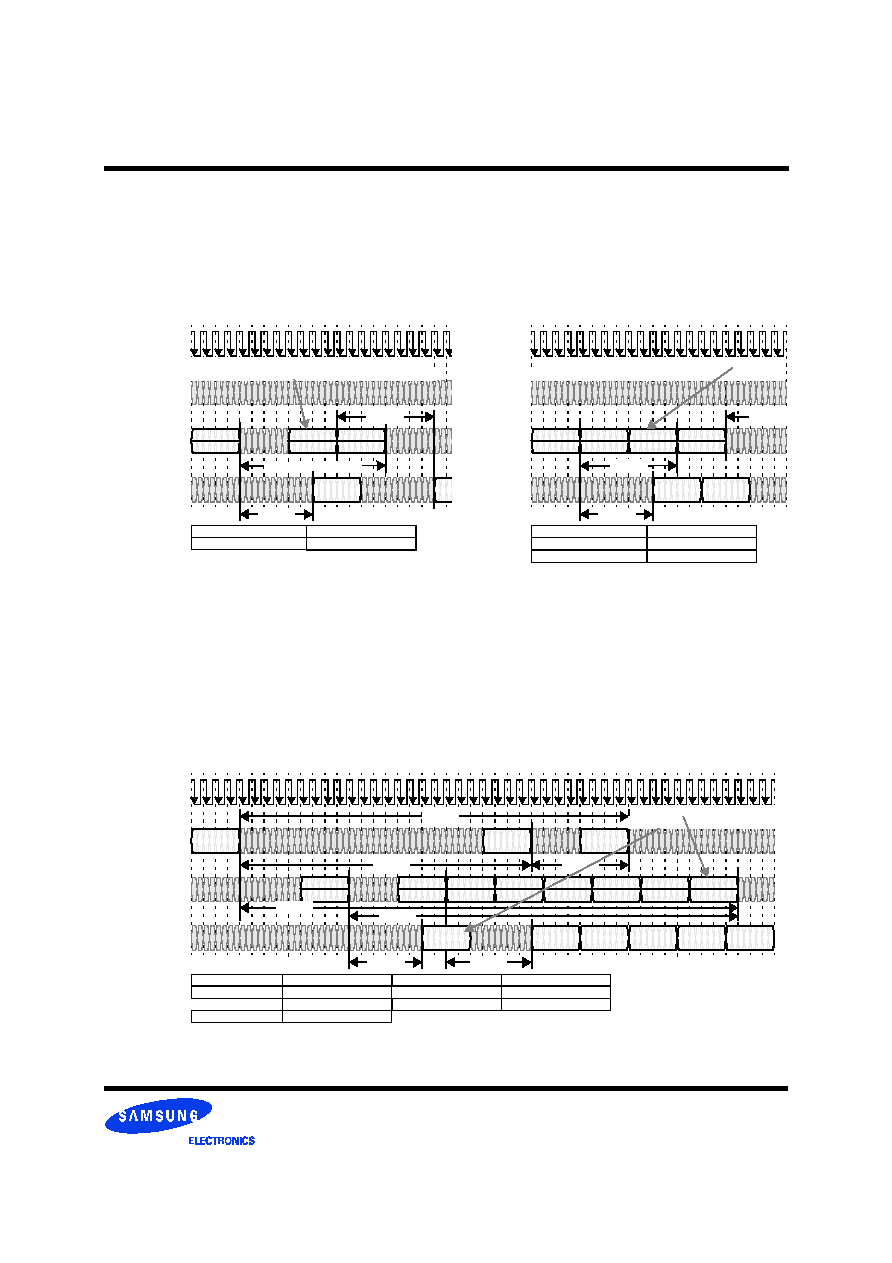
Page 23
Direct RDRAM
TM
K4R881869M
Rev. 0.9 Jan. 2000
Preliminary
Write/Retire Examples - continued
The RD will prevent a retire of the first WR from automati-
cally happening. But the first dualoct D(a1) in the write
buffer will be overwritten by the second WR dualoct D(b1)
if the RD command is issued in the third COLC packet.
Therefore, it is required in this situation that the controller
issue a NOCOP command in the third COLC packet,
delaying the RD command by a time of t
PACKET
. This situa-
tion is explicitly shown in Table 12 for the cases in which
t
CCDELAY
is equal to t
RTR
.
Figure 19 shows a possible result when a retire is held off for
a long time (an extended version of Figure 18-left). After a
WR command, a series of six RD commands are issued to
the same device (but to any combination of bank and column
addresses). In the meantime, the bank Ba to which the WR
command was originally directed is precharged, and a
different row Rc is activated. When the retire is automati-
cally performed, it is made to this new row, since the write
buffer only contains the bank and column address, not the
row address. The controller can insure that this doesn't
happen by never precharging a bank with an unretired write
buffer. Note that in a system with more than one RDRAM,
there will never be more than two RDRAMs with unretired
write buffers. This is because a WR command issued to one
device automatically retires the write buffers of all other
devices written a time t
RTR
before or earlier.
Figure 18: Retire Held Off by Read (left) and Controller Forces WWR Gap (right)
CTM/CFM
DQA8..0
DQB8..0
COL4
..COL0
ROW2
..ROW0
T
0
T
4
T
8
T
12
T
1
T
5
T
9
T
13
T
2
T
6
T
10
T
14
T
3
T
7
T
11
T
15
T
16
T
20
T
17
T
21
T
18
T
22
T
19
T
23
Transaction a: WR
Transaction b: RD
a1= {Da,Ba,Ca1}
b1= {Da,Bb,Cb1}
Transaction a: WR
Transaction b: WR
a1= {Da,Ba,Ca1}
b1= {Da,Bb,Cb1}
D (a1)
WR a1
retire (a1)
MSK (a1)
RD b1
Q (b1)
t
CWD
t
CAC
CTM/CFM
DQA8..0
DQB8..0
COL4
..COL0
ROW2
..ROW0
T
0
T
4
T
8
T
12
T
1
T
5
T
9
T
13
T
2
T
6
T
10
T
14
T
3
T
7
T
11
T
15
T
16
T
20
T
17
T
18
T
19
D (a1)
WR a1
RD c1
t
RTR
retire (a1)
MSK (a1)
t
CWD
t
CAC
WR b1
D (b1)
Transaction c: RD
c1= {Da,Bc,Cc1}
The controller must insert a NOCOP to retire (a1)
to make room for the data (b1) in the write buffer
The retire operation for a write can be
held off by a read to the same device
t
RTR
+ t
PACKET
Figure 19: Retire Held Off by Reads to Same Device, Write Buffer Retired to New Row
CTM/CFM
DQA8..0
DQB8..0
COL4
..COL0
ROW2
..ROW0
T
0
T
4
T
8
T
12
T
1
T
5
T
9
T
13
T
2
T
6
T
10
T
14
T
3
T
7
T
11
T
15
T
16
T
20
T
24
T
28
T
17
T
21
T
25
T
29
T
18
T
22
T
26
T
30
T
19
T
23
T
27
T
31
T
32
T
36
T
40
T
44
T
33
T
37
T
41
T
45
T
34
T
38
T
42
T
46
T
35
T
39
T
43
T
47
MSK (a1)
retire (a1)
RD b1
WR a1
PRER a2
t
RCD
ACT c0
t
RAS
t
RC
t
RP
ACT a0
t
CWD
t
RTR
Transaction a: WR
a0 = {Da,Ba,Ra}
a1 = {Da,Ba,Ca1}
a2 = {Da,Ba}
RD b2
RD b3
RD b4
RD b5
RD b6
Transaction b: RD
b1 = {Da,Bb,Cb1}
b2 = {Da,Bb,Cb2}
b3= {Da,Bb,Cb3}
b4 = {Da,Bb,Cb4}
b5 = {Da,Bb,Cb5}
b6 = {Da,Bb,Cb6}
Q (b1)
t
CAC
Q (b2)
Q (b3)
Q (b4)
Q (b5)
Transaction c: WR
c0 = {Da,Ba,Rc}
D (a1)
The retire operation puts the
write data in the new row
WARNING
This sequence is hazardous
and must be used with caution
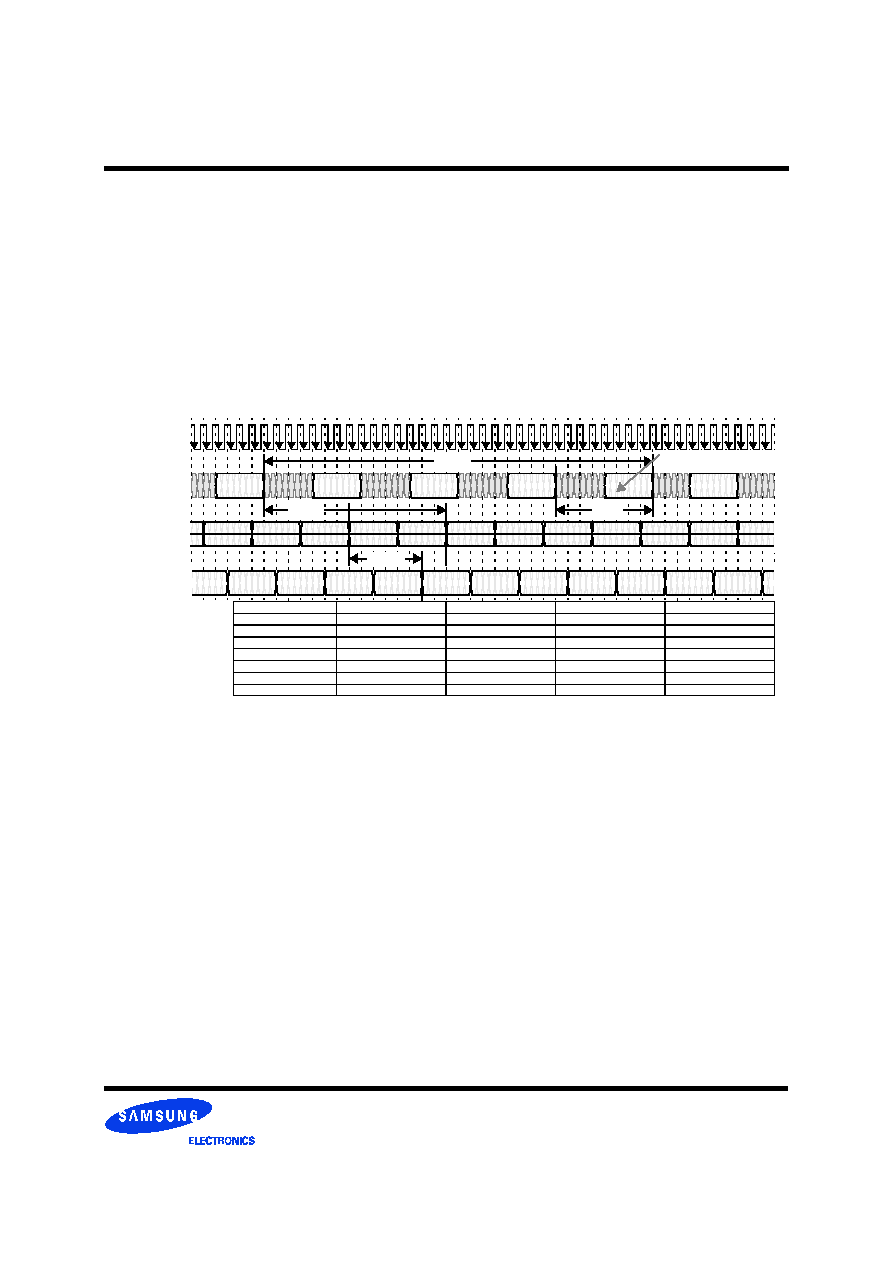
Page 24
Direct RDRAM
TM
K4R881869M
Rev. 0.9 Jan. 2000
Preliminary
Interleaved Write - Example
Figure 20 shows an example of an interleaved write transac-
tion. Transactions similar to the one presented in Figure 16
are directed to non-adjacent banks of a single RDRAM. This
allows a new transaction to be issued once every t
RR
interval
rather than once every t
RC
interval (four times more often).
The DQ data pin efficiency is 100% with this sequence.
With two dualocts of data written per transaction, the COL,
DQA, and DQB pins are fully utilized. Banks are precharged
using the WRA autoprecharge option rather than the PRER
command in an ROWR packet on the ROW pins.
In this example, the first transaction is directed to device Da
and bank Ba. The next three transactions are directed to the
same device Da, but need to use different, non-adjacent
banks Bb, Bc, Bd so there is no bank conflict. The fifth
transaction could be redirected back to bank Ba without
interference, since the first transaction would have
completed by then (t
RC
has elapsed). Each transaction may
use any value of row address (Ra, Rb, ..) and column address
(Ca1, Ca2, Cb1, Cb2, ...).
Interleaved Read - Example
Figure 21 shows an example of interleaved read transac-
tions. Transactions similar to the one presented in Figure 15
are directed to non-adjacent banks of a single RDRAM. The
address sequence is identical to the one used in the previous
write example. The DQ data pins efficiency is also 100%.
The only difference with the write example (aside from the
use of the RD command rather than the WR command) is
the use of the PREX command in a COLX packet to
precharge the banks rather than the RDA command. This is
done because the PREX is available for a readtransaction but
is not available for a masked write transaction.
Interleaved RRWW - Example
Figure 22 shows a steady-state sequence of 2-dualoct
RD/RD/WR/WR.. transactions directed to non-adjacent
banks of a single RDRAM. This is similar to the interleaved
write and read examples in Figure 20 and Figure 21 except
that bubble cycles need to be inserted by the controller at
read/write boundaries. The DQ data pin efficiency for the
example in Figure 22 is 32/42 or 76%. If there were more
RDRAMs on the Channel, the DQ pin efficiency would
approach 32/34 or 94% for the two-dualoct RRWW
sequence (this case is not shown).
In Figure 22, the first bubble type t
CBUB1
is inserted by the
controller between a RD and WR command on the COL
pins. This bubble accounts for the round-trip propagation
delay that is seen by read data, and is explained in detail in
Figure 4. This bubble appears on the DQA and DQB pins as
t
DBUB1
between a write data dualoct D and read data dualoct
Q. This bubble also appears on the ROW pins as t
RBUB1
.
Figure 20: Interleaved Write Transaction with Two Dualoct Data Length
CTM/CFM
DQA8..0
DQB8..0
COL4
..COL0
ROW2
..ROW0
T
0
T
4
T
8
T
12
T
1
T
5
T
9
T
13
T
2
T
6
T
10
T
14
T
3
T
7
T
11
T
15
T
16
T
20
T
24
T
28
T
17
T
21
T
25
T
29
T
18
T
22
T
26
T
30
T
19
T
23
T
27
T
31
T
32
T
36
T
40
T
44
T
33
T
37
T
41
T
45
T
34
T
38
T
42
T
46
T
35
T
39
T
43
T
47
ACT a0
MSK (b2)
WRA c2
MSK (b1)
WR c1
WR b1
MSK (a1)
WRA b2
MSK (a2)
D (b2)
D (b1)
ACT b0
ACT c0
ACT d0
ACT e0
D (a2)
D (a1)
WR d1
MSK (c1)
D(c1)
ACT f0
WR d2
MSK (c2)
WR e1
MSK (d1)
D (c2)
D (d1)
WR e2
MSK (d2)
D (z2)
D (z1)
D (x2)
D (y1)
D (y2)
MSK (z2)
WRA a2
MSK (z1)
WR a1
WR z1
MSK (y1)
WRA z2
MSK (y2)
Q (d1)
t
RCD
t
CWD
t
RC
Transaction e can use the
same bank as transaction a
t
RR
f3 = {Da,Ba+2}
Transaction f: WR
f0 = {Da,Ba+2,Rf}
f1 = {Da,Ba+2,Cf1}
f2= {Da,Ba+2,Cf2}
e3 = {Da,Ba}
Transaction e: WR
e0 = {Da,Ba,Re}
e1 = {Da,Ba,Ce1}
e2= {Da,Ba,Ce2}
d3 = {Da,Ba+6}
Transaction d: WR
d0 = {Da,Ba+6,Rd}
d1 = {Da,Ba+6,Cd1}
d2= {Da,Ba+6,Cd2}
c3 = {Da,Ba+4}
Transaction c: WR
c0 = {Da,Ba+4,Rc}
c1 = {Da,Ba+4,Cc1}
c2= {Da,Ba+4,Cc2}
b3 = {Da,Ba+2}
Transaction b: WR
b0 = {Da,Ba+2,Rb}
b1 = {Da,Ba+2,Cb1}
b2= {Da,Ba+2,Cb2}
a3 = {Da,Ba}
Transaction a: WR
a0 = {Da,Ba,Ra}
a1 = {Da,Ba,Ca1}
a2= {Da,Ba,Ca2}
z3 = {Da,Ba+6}
Transaction z: WR
z0 = {Da,Ba+6,Rz}
z1 = {Da,Ba+6,Cz1}
z2= {Da,Ba+6,Cz2}
y3 = {Da,Ba+4}
Transaction y: WR
y0 = {Da,Ba+4,Ry}
y1 = {Da,Ba+4,Cy1}
y2= {Da,Ba+4,Cy2}

Page 25
Direct RDRAM
TM
K4R881869M
Rev. 0.9 Jan. 2000
Preliminary
The second bubble type t
CBUB2
is inserted (as a NOCOP
command) by the controller between a WR and RD
command on the COL pins when there is a WR-WR-RD
sequence to the same device. This bubble enables write data
to be retired from the write buffer without being lost, and is
explained in detail in Figure 18. There would be no bubble if
address c0 and address d0 were directed to different devices.
This bubble appears on the DQA and DQB pins as t
DBUB2
between a write data dualoct D and read data dualoct Q. This
bubble also appears on the ROW pins as t
RBUB2
.
Control Register Transactions
The RDRAM has two CMOS input pins SCK and CMD and
two CMOS input/output pins SIO0 and SIO1. These provide
serial access to a set of control registers in the RDRAM.
These control registers provide configuration information to
the controller during the initialization process. They also
Figure 21: Interleaved Read Transaction with Two Dualoct Data Length
CTM/CFM
DQA8..0
DQB8..0
COL4
..COL0
ROW2
..ROW0
T
0
T
4
T
8
T
12
T
1
T
5
T
9
T
13
T
2
T
6
T
10
T
14
T
3
T
7
T
11
T
15
T
16
T
20
T
24
T
28
T
17
T
21
T
25
T
29
T
18
T
22
T
26
T
30
T
19
T
23
T
27
T
31
T
32
T
36
T
40
T
44
T
33
T
37
T
41
T
45
T
34
T
38
T
42
T
46
T
35
T
39
T
43
T
47
ACT a0
PREX b3
RD c2
RD c1
RD b1
RD b2
PREX a3
ACT b0
ACT c0
ACT d0
ACT e0
RD a1
RD a2
PREX z3
RD d1
ACT f0
RDd2
PREX c3
RD e1
RD e2
PREX d3
RD z1
RD z2
PREX y3
Q (b2)
Q (b1)
Q (a2)
Q (a1)
Q (c1)
Q (c2)
Q (d1)
Q (z2)
Q (z1)
Q (x2)
Q (y1)
Q (y2)
t
RCD
t
CAC
Transaction e can use the
same bank as transaction a
t
RC
t
RR
f3 = {Da,Ba+2}
Transaction f: RD
f0 = {Da,Ba+2,Rf}
f1 = {Da,Ba+2,Cf1}
f2= {Da,Ba+2,Cf2}
e3 = {Da,Ba}
Transaction e: RD
e0 = {Da,Ba,Re}
e1 = {Da,Ba,Ce1}
e2= {Da,Ba,Ce2}
d3 = {Da,Ba+6}
Transaction d: RD
d0 = {Da,Ba+6,Rd}
d1 = {Da,Ba+6,Cd1}
d2= {Da,Ba+6,Cd2}
c3 = {Da,Ba+4}
Transaction c: RD
c0 = {Da,Ba+4,Rc}
c1 = {Da,Ba+4,Cc1}
c2= {Da,Ba+4,Cc2}
b3 = {Da,Ba+2}
Transaction b: RD
b0 = {Da,Ba+2,Rb}
b1 = {Da,Ba+2,Cb1}
b2= {Da,Ba+2,Cb2}
a3 = {Da,Ba}
Transaction a: RD
a0 = {Da,Ba,Ra}
a1 = {Da,Ba,Ca1}
a2= {Da,Ba,Ca2}
z3 = {Da,Ba+6}
Transaction z: RD
z0 = {Da,Ba+6,Rz}
z1 = {Da,Ba+6,Cz1}
z2= {Da,Ba+6,Cz2}
y3 = {Da,Ba+4}
Transaction y: RD
y0 = {Da,Ba+4,Ry}
y1 = {Da,Ba+4,Cy1}
y2= {Da,Ba+4,Cy2}
Figure 22: Interleaved RRWW Sequence with Two Dualoct Data Length
CTM/CFM
DQA8..0
DQB8..0
COL4
..COL0
ROW2
..ROW0
T
0
T
4
T
8
T
12
T
1
T
5
T
9
T
13
T
2
T
6
T
10
T
14
T
3
T
7
T
11
T
15
T
16
T
20
T
24
T
28
T
17
T
21
T
25
T
29
T
18
T
22
T
26
T
30
T
19
T
23
T
27
T
31
T
32
T
36
T
40
T
44
T
33
T
37
T
41
T
45
T
34
T
38
T
42
T
46
T
35
T
39
T
43
T
47
ACT a0
MSK (b2)
WRA c2
MSK (b1)
WR c1
WR b1
MSK (y2)
WRA b2
PREX a3
D (b2)
D (b1)
ACT b0
ACT c0
ACT d0
ACT e0
RD a1
RD a2
PREX z3
Q (a2)
Q (a1)
MSK (c1)
D (c1)
NOCOP
MSK (c2)
RDd0
D (c2)
t
RBUB1
RDf1
Q (z2)
Q (z1)
D (y2)
RD z1
RD z2
t
CBUB1
t
DBUB1
t
DBUB1
t
DBUB2
t
CBUB2
t
RBUB2
t
CBUB2
NOCOP
Transaction e can use the
same bank as transaction a
f3 = {Da,Ba+2}
Transaction f: WR
f0 = {Da,Ba+2,Rf}
f1 = {Da,Ba+2,Cf1}
f2= {Da,Ba+2,Cf2}
e3 = {Da,Ba}
Transaction e: RD
e0 = {Da,Ba,Re}
e1 = {Da,Ba,Ce1}
e2= {Da,Ba,Ce2}
d3 = {Da,Ba+6}
Transaction d: RD
d0 = {Da,Ba+6,Rd}
d1 = {Da,Ba+6,Cd1}
d2= {Da,Ba+6,Cd2}
c3 = {Da,Ba+4}
Transaction c: WR
c0 = {Da,Ba+4,Rc}
c1 = {Da,Ba+4,Cc1}
c2= {Da,Ba+4,Cc2}
b3 = {Da,Ba+2}
Transaction b: WR
b0 = {Da,Ba+2,Rb}
b1 = {Da,Ba+2,Cb1}
b2= {Da,Ba+2,Cb2}
a3 = {Da,Ba}
Transaction a: RD
a0 = {Da,Ba,Ra}
a1 = {Da,Ba,Ca1}
a2= {Da,Ba,Ca2}
z3 = {Da,Ba+6}
Transaction z: RD
z0 = {Da,Ba+6,Rz}
z1 = {Da,Ba+6,Cz1}
z2= {Da,Ba+6,Cz2}
y3 = {Da,Ba+4}
Transaction y: WR
y0 = {Da,Ba+4,Ry}
y1 = {Da,Ba+4,Cy1}
y2= {Da,Ba+4,Cy2}

Page 26
Direct RDRAM
TM
K4R881869M
Rev. 0.9 Jan. 2000
Preliminary
allow an application to select the appropriate operating mode
of the RDRAM.
SCK (serial clock) and CMD (command) are driven by the
controller to all RDRAMs in parallel. SIO0 and SIO1 are
connected (in a daisy chain fashion) from one RDRAM to
the next. In normal operation, the data on SIO0 is repeated
on SIO1, which connects to SIO0 of the next RDRAM (the
data is repeated from SIO1 to SIO0 for a read data packet).
The controller connects to SIO0 of the first RDRAM.
Write and read transactions are each composed of four
packets, as shown in Figure 23 and Figure 24. Each packet
consists of 16 bits, as summarized in Table 14 and Table 15.
The packet bits are sampled on the falling edge of SCK. A
transaction begins with a SRQ (Serial Request) packet. This
packet is framed with a 11110000 pattern on the CMD input
(note that the CMD bits are sampled on both the falling edge
and the rising edge of SCK). The SRQ packet contains the
SOP3..SOP0 (Serial Opcode) field, which selects the trans-
action type. The SDEV5..SDEV0 (Serial Device address)
selects one of the 32 RDRAMs. If SBC (Serial Broadcast) is
set, then all RDRAMs are selected. The SA (Serial Address)
packet contains a 12 bit address for selecting a control
register.
A write transaction has a SD (Serial Data) packet next. This
contains 16 bits of data that is written into the selected
control register. A SINT (Serial Interval) packet is last,
providing some delay for any side-effects to take place. A
read transaction has a SINT packet, then a SD packet. This
provides delay for the selected RDRAM to access the
control register. The SD read data packet travels in the oppo-
site direction (towards the controller) from the other packet
types. The SCK cycle time will accomodate the total delay.
Figure 23: Serial Write (SWR) Transaction to Control Register
SRQ - SWR command
1111
00000000...00000000
SRQ - SWR command
0000
SA
SA
SD
SD
SINT
SINT
00000000...00000000
00000000...00000000
00000000...00000000
SCK
CMD
SIO0
SIO1
T
4
T
36
T
20
T
52
T
68
Each packet is repeated
from SIO0 to SIO1
1
1
1
1
0
0
0
0
1111
next transaction
Figure 24: Serial Read (SRD) Transaction Control Register
SRQ - SRD command
1111
00000000...00000000
SRQ - SRD command
0000
SA
SA
SINT
SINT
SD
SD
00000000...00000000
00000000...00000000
00000000...00000000
SCK
CMD
SIO0
SIO1
T
4
T
36
T
20
T
52
T
68
First 3 packets are repeated
from SIO0 to SIO1
non-addressed RDRAMs pass
0/SD15..SD0/0 from SIO1 to SIO0
1
1
1
1
0
0
0
0
1111
next transaction
0
0
controller drives
0 on SIO0
0
0
addressed RDRAM drives
0/SD15..SD0/0 on SIO0
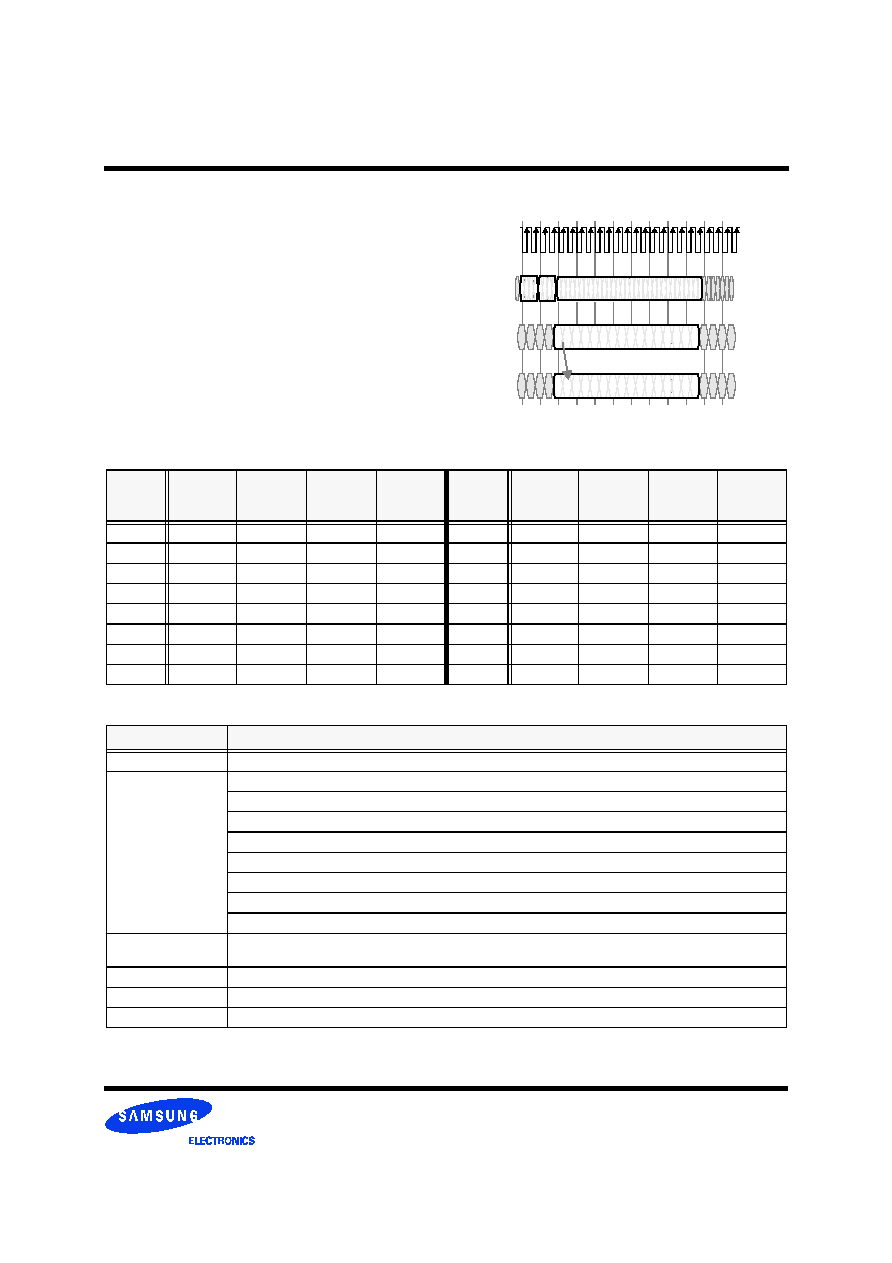
Page 27
Direct RDRAM
TM
K4R881869M
Rev. 0.9 Jan. 2000
Preliminary
Control Register Packets
Table 14 summarizes the formats of the four packet types for
control register transactions. Table 15 summarizes the fields
that are used within the packets.
Figure 25 shows the transaction format for the SETR,
CLRR, and SETF commands. These transactions consist of a
single SRQ packet, rather than four packets like the SWR
and SRD commands. The same framing sequence on the
CMD input is used, however. These commands are used
during initialization prior to any control register read or
write transactions.
Figure 25: SETR, CLRR,SETF Transaction
SCK
CMD
SIO0
T
20
SRQ packet - SETR/CLRR/SETF
1111
00000000...00000000
SRQ packet - SETR/CLRR/SETF
0000
SIO1
T
4
The packet is repeated
from SIO0 to SIO1
1
1
1
1
0
0
0
0
Table 14: Control Register Packet Formats
SCK
Cycle
SIO0 or
SIO1
for SRQ
SIO0 or
SIO1
for SA
SIO0 or
SIO1
for SINT
SIO0 or
SIO1
for SD
SCK
Cycle
SIO0 or
SIO1
for SRQ
SIO0 or
SIO1
for SA
SIO0 or
SIO1
for SINT
SIO0 or
SIO1
for SD
0
rsrv
rsrv
0
SD15
8
SOP1
SA7
0
SD7
1
rsrv
rsrv
0
SD14
9
SOP0
SA6
0
SD6
2
rsrv
rsrv
0
SD13
10
SBC
SA5
0
SD5
3
rsrv
rsrv
0
SD12
11
SDEV4
SA4
0
SD4
4
rsrv
SA11
0
SD11
12
SDEV3
SA3
0
SD3
5
SDEV5
SA10
0
SD10
13
SDEV2
SA2
0
SD2
6
SOP3
SA9
0
SD9
14
SDEV1
SA1
0
SD1
7
SOP2
SA8
0
SD8
15
SDEV0
SA0
0
SD0
Table 15: Field Description for Control Register Packets
Field
Description
rsrv
Reserved. Should be driven as
"
0
"
by controller.
SOP3..SOP0
0000 - SRD. Serial read of control register {SA11..SA0} of RDRAM {SDEV5..SDEV0}.
0001 - SWR. Serial write of control register {SA11..SA0} of RDRAM {SDEV5..SDEV0}.
0010 - SETR. Set Reset bit, all control registers assume their reset values.
a
16 t
SCYCLE
delay until CLRR command.
0100 - SETF. Set fast (normal) clock mode. 4 t
SCYCLE
delay until next command.
1011 - CLRR. Clear Reset bit, all control registers retain their reset values.
a
4 t
SCYCLE
delay until next command.
1111 - NOP. No serial operation.
0011, 0101-1010, 1100-1110 - RSRV. Reserved encodings.
SDEV5..SDEV0
Serial device. Compared to SDEVID5..SDEVID0 field of INIT control register field to select the RDRAM to which the transac-
tion is directed.
SBC
Serial broadcast. When set, RDRAMs ignore {SDEV5..SDEV0} for RDRAM selection.
SA11..SA0
Serial address. Selects which control register of the selected RDRAM is read or written.
SD15..SD0
Serial data. The 16 bits of data written to or read from the selected control register of the selected RDRAM.
a. The SETR and CLRR commands must always be applied in two successive transactions to RDRAMs; i.e. they may not be used in isolation. This is called
"
SETR/CLRR Reset
"
.
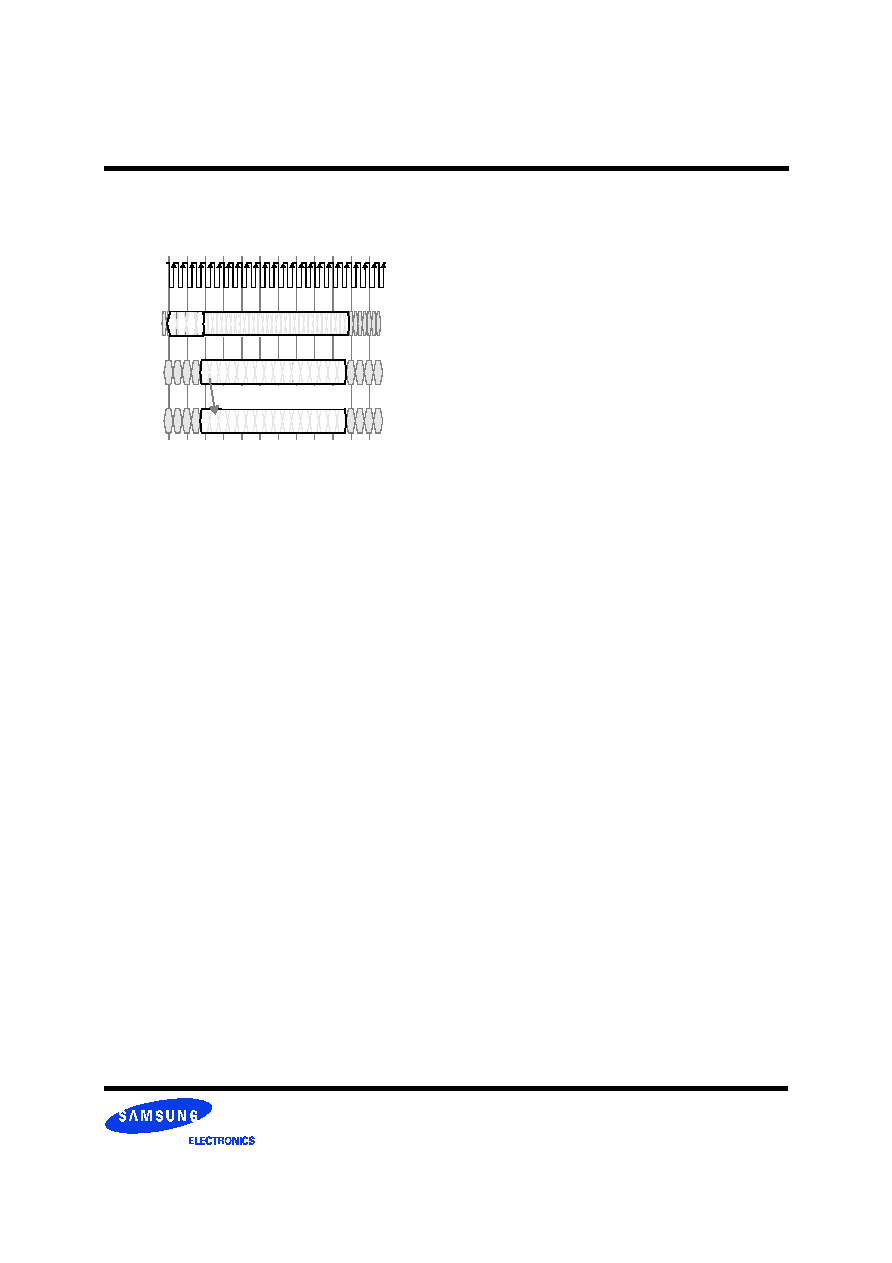
Page 28
Direct RDRAM
TM
K4R881869M
Rev. 0.9 Jan. 2000
Preliminary
Initialization
Initialization refers to the process that a controller must go
through after power is applied to the system or the system is
reset. The controller prepares the RDRAM sub-system for
normal Channel operation by (primarily) using a sequence of
control register transactions on the serial CMOS pins. The
following steps outline the sequence seen by the various
memory subsystem components (including the RDRAM
components) during initialization. This sequence is available
in the form of reference code.
1.0 Start Clocks - This step calculates the proper clock
frequencies for PClk (controller logic), SynClk (RAC
block), RefClk (DRCG component), CTM (RDRAM
component), and SCK (SIO block).
2.0 RAC Initialization - This step causes the INIT block to
generate a sequence of pulses which resets the RAC,
performs RAC maintainance operations, and measures
timing intervals in order to ensure clock stability.
3.0 RDRAM Initialization - This stage performs most of
the steps needed to initialize the RDRAMs. The rest are
performed in stages 5.0, 6.0, and 7.0. All of the steps in 3.0
are carried out through the SIO block interface.
o
3.1/3.2 SIO Reset - After a delay of t
PAUSE
from step
1.0, this reset operation is performed berore any SIO
control register read or write transactions. It clears six
registers (TEST34, CCA, CCB, SKIP, TEST78, and
TEST79) and places the INIT register into a special
state (all bits cleared except SKP and SDEVID fields
are set to ones).
o
3.3 Write TEST77 Register - The TEST77 register
must be explicitly written with zeros before any other
registers are read or written.
o
3.4 Write TCYCLE Register - The TCYCLE register
is written with the cycle time tCYCLE of the CTM
clock (for Channel and RDRAMs) in units of 64ps. The
tCYCLE value is determined in stage 1.0.
o
3.5 Write SDEVID Register - The SDEVID (serial
device identification) register of each RDRAM is
written with a unique address value so that directed SIO
read and write transactions can be performed. This
address value increases from 0 to 31 according to the
distance an RDRAM is from the ASIC component on
the SIO bus (the closest RDRAM is address 0).
o
3.6 Write DEVID Register - The DEVID (device iden-
tification) register of each RDRAM is written with a
unique address value so that directed memory read and
write transactions can be performed. This address value
increases from 0 to 31. The DEVID value is not neces-
sarily the same as the SDEVID value. RDRAMs are
sorted into regions of the same core configuration
(number of bank, row, and column address bits and core
type).
o
3.7 Write PDNX,PDNXA Registers - The PDNX and
PDNXA registers are written with values that are used
to measure the timing intervals connected with an exit
from the PDN (powerdown) power state.
o
3.8 Write NAPX Register - The NAPX register is
written with values that are used to measure the timing
intervals connected with an exit from the NAP power
state.
o
3.9 Write TPARM Register - The TPARM register is
written with values which determine the time interval
between a COL packet with a memory read command
and the Q packet with the read data on the Channel. The
values written set each RDRAM to the minimum value
permitted for the system. This will be adjusted later in
stage 6.0.
o
3.10 Write TCDLY1 Register - The TCDLY1 register
is written with values which determine the time interval
between a COL packet with a memory read command
and the Q packet with the read data on the Channel. The
values written set each RDRAM to the minimum value
permitted for the system. This will be adjusted later in
stage 6.0.
o
3.11 Write TFRM Register - The TFRM register is
written with a value that is related to the t
RCD
parameter
for the system. The t
RCD
parameter is the time interval
Figure 26: SIO Reset Sequence
SCK
CMD
SIO0
T
16
0000000000000000
0000000000000000
00001100
SIO1
T
0
The packet is repeated
from SIO0 to SIO1
1
1
1
1
0
0
0
0
00000000...00000000

Page 29
Direct RDRAM
TM
K4R881869M
Rev. 0.9 Jan. 2000
Preliminary
between a ROW packet with an activate command and
the COL packet with a read or write command.
o
3.12 SETR/CLRR - Each RDRAM is given a SETR
command and a CLRR command through the SIO
block. This sequence performs a second reset operation
on the RDRAMs.
o
3.13 Write CCA and CCB Registers - These registers
are written with a value halfway between their
minimum and maximum values. This shortens the time
needed for the RDRAMs to reach their steady-state
current control values in stage 5.0.
o
3.14 Powerdown Exit - The RDRAMs are in the PDN
power state at this point. A broadcast PDNExit
command is performed by the SIO block to place the
RDRAMs in the RLX (relax) power state in which they
are ready to receive ROW packets.
o
3.15 SETF - Each RDRAM is given a SETF command
through the SIO block. One of the operations performed
by this step is to generate a value for the AS (autoskip)
bit in the SKIP register and fix the RDRAM to a partic-
ular read domain.
4.0 Controller Configuration- This stage initializes the
controller block. Each step of this stage will set a field of the
ConfigRMC[63:0] bus to the appropriate value. Other
controller implementations will have similar initialization
requirements, and this stage may be used as a guide.
o
4.1 Initial Read Data Offset- The ConfigRMC bus is
written with a value which determines the time interval
between a COL packet with a memory read command
and the Q packet with the read data on the Channel. The
value written sets RMC.d1 to the minimum value
permitted for the system. This will be adjusted later in
stage 6.0.
o
4.2 Configure Row/Column Timing - This step deter-
mines the values of the t
RAS,MIN
, t
RP,MIN
, t
RC,MIN
,
t
RCD,MIN
, t
RR,MIN
, and t
PP,MIN
RDRAM timing param-
eters that are present in the system. The ConfigRMC
busis written with values that will be compatible with
all RDRAM devices that are present.
o
4.3 Set Refresh Interval - This step determines the
values of the t
REF,MAX
RDRAM timing parameter that
are present in the system. The ConfigRMC bus is
written with a value that will be compatible with all
RDRAM devices that are present.
o
4.4 Set Current Control Interval - This step deter-
mines the values of the t
CCTRL,MAX
RDRAM timing
parameter that are present in the system. The Confi-
gRMC bus is written with a value that will be compat-
ible with all RDRAM devices that are present.
o
4.5 Set Slew Rate Control Interval - This step deter-
mines the values of the t
TEMP,MAX
RDRAM timing
parameter that are present in the system. The Confi-
gRMC bus is written with a value that will be compat-
ible with all RDRAM devices that are present.
o
4.6 Set Bank/Row/Col Address Bits - This step deter-
mines the number of RDRAM bank, row, and column
address bits that are present in the system. It also deter-
mines the RDRAM core types (independent, doubled,
or split) that are present. The ConfigRMC bus is written
with a value that will be compatible with all RDRAM
devices that are present.
5.0 RDRAM Current Control - This step causes the INIT
block to generate a sequence of pulses which performs
RDRAM maintainance operations.
6.0 RDRAM Core, Read Domain Initialization- This
stage completes the RDRAM initialization
o
6.1 RDRAM Core Initialization - A sequence of 192
memory refresh transactions is performed in order to
place the cores of all RDRAMs into the proper oper-
ating state.
o
6.2 RDRAM Read Domain Initialization - A memory
write and memory read transaction is performed to each
RDRAM to determine which read domain each
RDRAM occupies. The programmed delay of each
RDRAM is then adjusted so the total RDRAM read
delay (propagation delay plus programmed delay) is
constant. The TPARM and TCDLY1 registers of each
RDRAM are rewritten with the appropriate read delay
values. The ConfigRMC bus is also rewritten with an
updated value.
7.0 Other RDRAM Register Fields - This stage rewrites
the INIT register with the final values of the LSR, NSR, and
PSR fields.
In essence, the controller must read all the read-only config-
uration registers of all RDRAMs (or it must read the SPD
device present on each RIMM), it must process this informa-
tion, and then it must write all the read-write registers to
place the RDRAMs into the proper operating mode.
Initialization Note [1]: During the initialization process, it is
necessary for the controller to perform 128 current control
operations (3xCAL, 1xCAL/SAM) and one temperature
calibrate operation (TCEN/TCAL) after reset or after power-
down (PDN) exit.
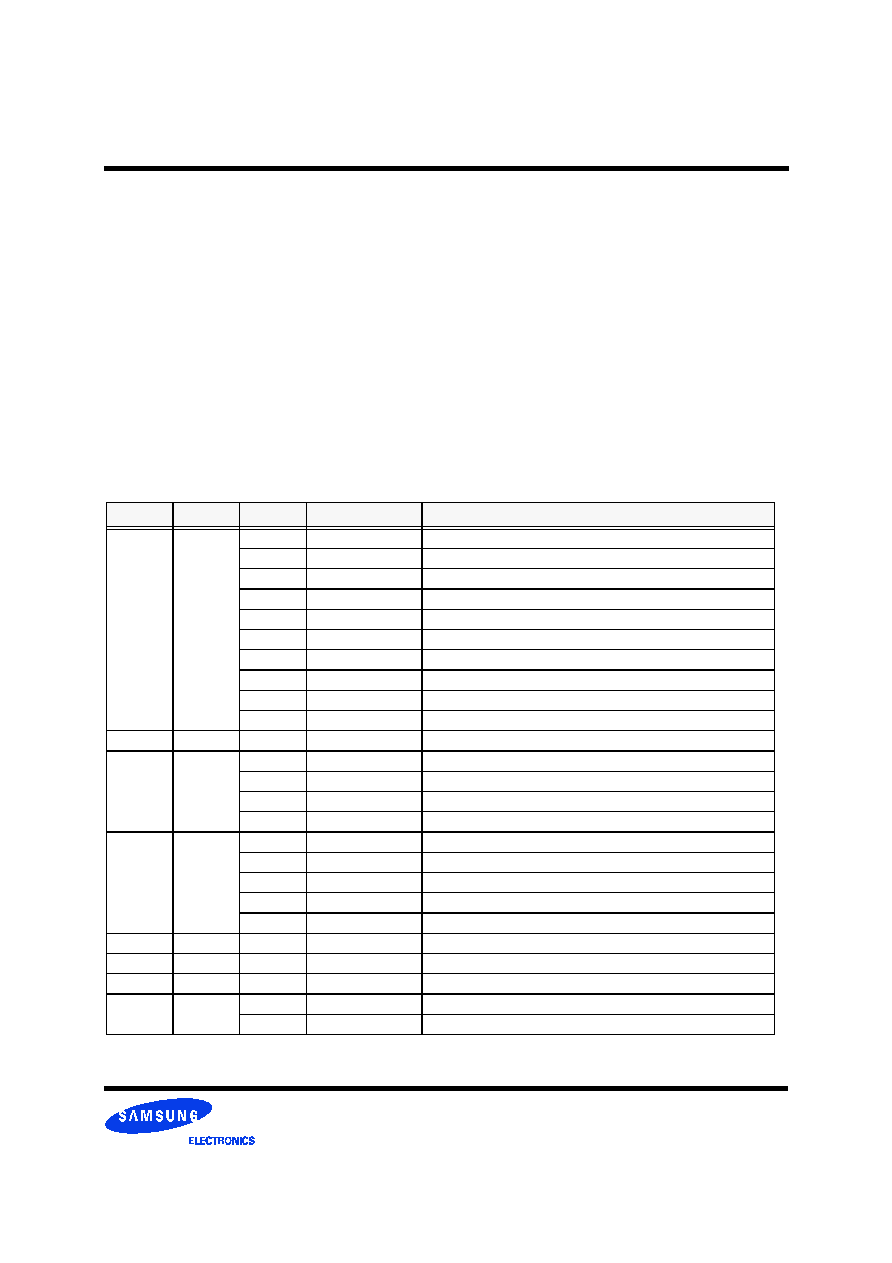
Page 30
Direct RDRAM
TM
K4R881869M
Rev. 0.9 Jan. 2000
Preliminary
Initialization Note [2]: Does not apply to this RDRAM type;
this note had been generated for earlier 72M devices, but
does not apply to this device.
Initialization Note [3]: After the step of equalizing the total
read delay of each RDRAM has been completed (i.e. after
the TCDLY0 and TCDLY1 fields have been written for the
final time), a single final memory read transaction should be
made to each RDRAM in order to ensure that the output
pipeline stages have been cleared.
Initialization Note [4]: The SETF command (in the serial
SRQ packet) should only be issued once during the Initial-
ization process, as should the SETR and CLRR commands.
Initialization Note [5]: The CLRR command (in the serial
SRQ packet) leaves some of the contents of the memory
core in an indeterminate state.
Control Register Summary
Table 16 summarizes the RDRAM control registers. Detail
is provided for each control register in Figure 27 through
Figure 43. Read-only bits which are shaded gray are unused
and return zero. Read-write bits which are shaded gray are
reserved and should always be written with zero. The RIMM
SPD Application Note describes additional read-only
configuration registers which are present on Direct RIMMs.
The state of the register fields are potentially affected by the
IO Reset operation or the SETR/CLRR operation. This is
indicated in the text accompanying each register diagram.
Table 16: Control Register Summary
SA11..SA0
Register
Field
read-write/ read-only
Description
021
16
INIT
SDEVID
read-write, 6 bits
Serial device ID. Device address for control register read/write.
PSX
read-write, 1 bit
Power select exit. PDN/NAP exit with device addr on DQA5..0.
SRP
read-write, 1 bit
SIO repeater. Used to initialize RDRAM.
NSR
read-write, 1 bit
NAP self-refresh. Enables self-refresh in NAP mode.
PSR
read-write, 1 bit
PDN self-refresh. Enables self-refresh in PDN mode.
LSR
read-write, 1 bit
Low power self-refresh. Enables low power self-refresh.
TEN
read-write, 1 bit
Temperature sensing enable.
TSQ
read-write, 1 bit
Temperature sensing output.
DIS
read-write, 1 bit
RDRAM disable.
IDM
read-write, 1 bit
Interleaved Device Mode enable
022
16
TEST34
TEST34
read-write, 16 bits
Test register. Do not read or write after SIO reset.
023
16
CNFGA
REFBIT
read-only, 3 bit
Refresh bank bits. Used for multi-bank refresh.
DBL
read-only, 1 bit
Double. Specifies doubled-bank architecture
MVER
read-only, 6 bit
Manufacturer version. Manufacturer identification number.
PVER
read-only, 6 bit
Protocol version. Specifies version of Direct protocol supported.
024
16
CNFGB
BYT
read-only, 1 bit
Byte. Specifies an 8-bit or 9-bit byte size.
DEVTYP
read-only, 3 bit
Device type. Device can be RDRAM or some other device category.
SPT
read-only, 1 bit
Split-core. Each core half is an individual dependent core.
CORG
read-only, 6 bit
Core organization. Bank, row, column address field sizes.
SVER
read-only, 6 bit
Stepping version. Mask version number.
040
16
DEVID
DEVID
read-write, 5 bits
Device ID. Device address for memory read/write.
041
16
REFB
REFB
read-write, 4 bits
Refresh bank. Next bank to be refreshed by self-refresh.
042
16
REFR
REFR
read-write, 9 bits
Refresh row. Next row to be refreshed by REFA, self-refresh.
043
16
CCA
CCA
read-write, 7 bits
Current control A. Controls I
OL
output current for DQA.
ASYMA
read-write, 2 bits
Asymmetry control. Controls asymmetry of V
OL
/V
OH
swing for DQA.
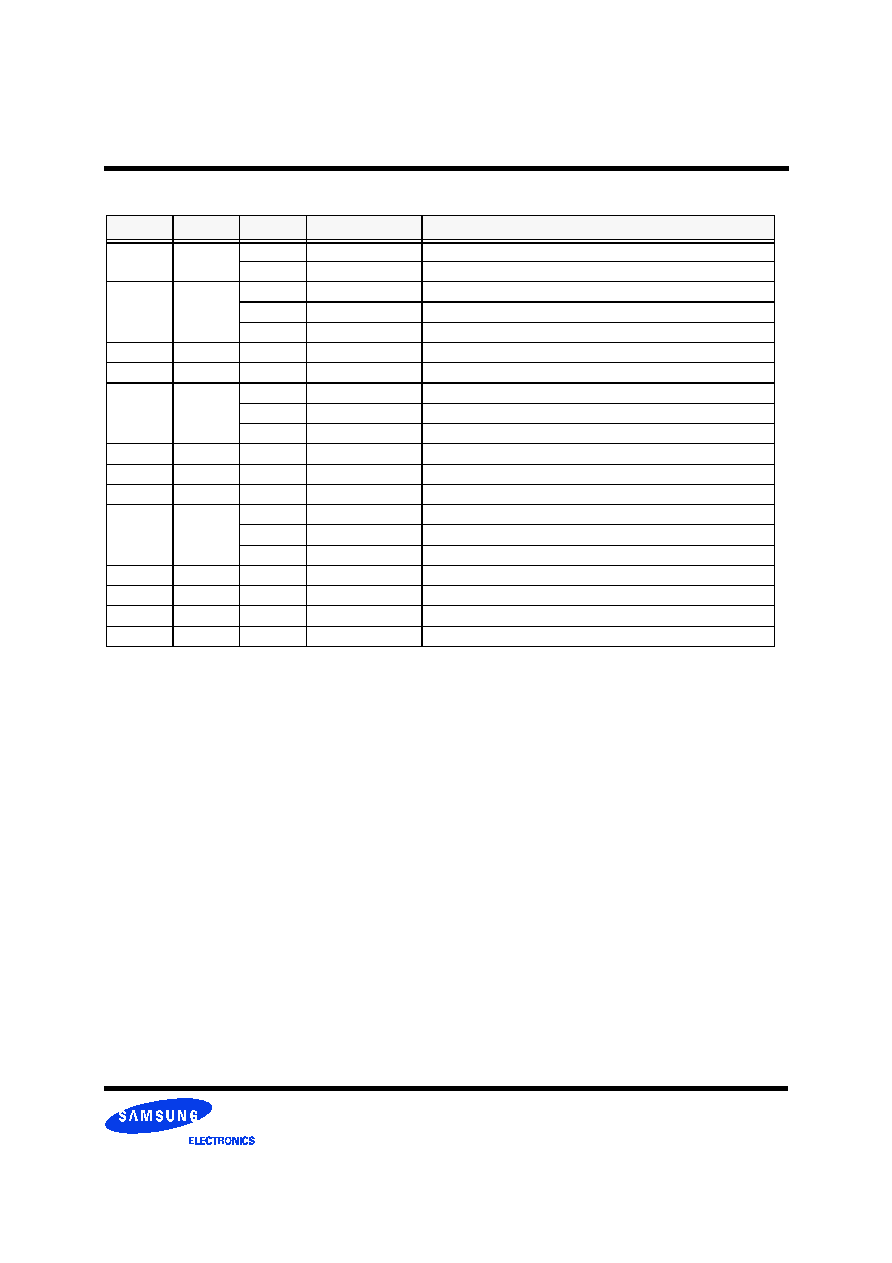
Page 31
Direct RDRAM
TM
K4R881869M
Rev. 0.9 Jan. 2000
Preliminary
044
16
CCB
CCB
read-write, 7 bits
Current control B. Controls I
OL
output current for DQB.
ASYMB
read-write, 2 bits
Asymmetry control. Controls asymmetry of V
OL
/V
OH
swing for DQB.
045
16
NAPX
NAPXA
read-write, 5 bits
NAP exit. Specifies length of NAP exit phase A.
NAPX
read-write, 5 bits
NAP exit. Specifies length of NAP exit phase A + phase B.
DQS
read-write, 1 bits
DQ select. Selects CMD framing for NAP/PDN exit.
046
16
PDNXA
PDNXA
read-write, 13 bits
PDN exit. Specifies length of PDN exit phase A.
047
16
PDNX
PDNX
read-write, 13 bits
PDN exit. Specifies length of PDN exit phase A + phase B.
048
16
TPARM
TCAS
read-write, 2 bits
t
CAS-C
core parameter. Determines t
OFFP
datasheet parameter.
TCLS
read-write, 2 bits
t
CLS-C
core parameter. Determines t
CAC
and t
OFFP
parameters.
TCDLY0
read-write, 3 bits
t
CDLY0-C
core parameter. Programmable delay for read data.
049
16
TFRM
TFRM
read-write, 4 bits
t
FRM-C
core parameter. Determines ROW-COL packet framing interval.
04a
16
TCDLY1
TCDLY1
read-write, 3 bits
t
CDLY1-C
core parameter. Programmable delay for read data.
04c
16
TCYCLE
TCYCLE
read-write, 14 bits
t
CYCLE
datasheet parameter. Specifies cycle time in 64ps units.
04b
16
SKIP
AS
read-only, 1 bit
Autoskip value established by the SETF command.
MSE
read-write, 1 bit
Manual skip enable. Allows the MS value to override the AS value.
MS
read-write, 1 bit
Manual skip value.
04d
16-
TEST77
TEST77
read-write, 16 bits
Test register. Write with zero after SIO reset.
04e
16-
TEST78
TEST78
read-write, 16 bits
Test register. Do not read or write after SIO reset.
04f
16-
TEST79
TEST79
read-write, 16 bits
Test register. Do not read or write after SIO reset.
080
16
- 0ff
16
reserved
reserved
vendor-specific
Vendor-specific test registers. Do not read or write after SIO reset.
Table 16: Control Register Summary
SA11..SA0
Register
Field
read-write/ read-only
Description

Page 32
Direct RDRAM
TM
K4R881869M
Rev. 0.9 Jan. 2000
Preliminary
. .
Figure 27: INIT Register
Figure 28: CNFGA Register
15 14 13 12 11 10
9
8
7
6
5
4
3
2
1
0
Control Register: INIT
Read/write register.
Reset values are undefined except as affected by SIO Reset as noted
below. SETR/CLRR Reset does not affect this register.
SDEVID5..0 - Serial Device Identification. Compared to SDEV5..0
serial address field of serial request packet for register read/write transac-
tions. This determines which RDRAM is selected for the register read or
write operation. SDEVID resets to 3f
16
.
SDEVID4..SDEVID0
0
SRP PSX
NSR
PSR
LSR
0
PSX - Power Exit Select. PDN and NAP are exited with (=0) or without (=1) a device address on the
DQA5..0 pins. PDEV5 (on DQA5) selectes broadcast (1) or directed (0) exit. For a directed exit,
PDEV4..0 (on DQA4..0) is compared to DEVID4..0 to select a device.
SRP - SIO Repeater. Controls value on SIO1; SIO1=SIO0 if SRP=1, SIO1=1 if SRP=0. SRP resets
to 1.
NAP Self-Refresh. NSR=1 enables self-refresh in NAP mode. NSR can't be set while in NAP
mode. NSR resets to 0.
PDN Self-Refresh. PSR=1 enables self-refresh in PDN mode. PSR can't be set while in PDN mode.
PSR resets to 0.
Low Power Self-Refresh. LSR=1 enables longer self-refresh interval. The self-refresh supply
current is reduced. LSR resets to 0.
Temperature Sensing Enable. TEN=1 enables temperature sensing circuitry, permitting the TSQ bit
to be read to determine if a thermal trip point has been exceeded. TEN resets to 0.
Temperature Sensing Output. TSQ=1 when a temperature trip point has been exceeded, TSQ=0
when it has not. TSQ is available during a current control operation (see Figure 51).
RDRAM Disable. DIS=1 causes RDRAM to ignore NAP/PDN exit sequence, DIS=0 permits
normal operation. This mechanism disables an RDRAM. DIS resets to 0.
Interleaved Device Mode. IDM=1 causes 8 RDRAMs interleave read/write data, IDM=0 permits
normal operation . IDM resets to 0.
Address: 021
16
TEN
TSQ
DIS
SDE
VID
5
IDM
15 14 13 12 11 10
9
8
7
6
5
4
3
2
1
0
Control Register: CNFGA
Address: 023
16
0
0
0
0
0
0
0
0
0
0
0
0
0
0
0
0
Read-only register.
REFBIT2..0 - Refresh Bank Bits. Specifies the number of
bank address bits used by REFA and REFP commands.
Permits multi-bank refresh in future RDRAMs.
DBL - Doubled-Bank. DBL=1 means the device uses a
doubled-bank architecture with adjacent-bank dependency.
DBL=0 means no dependency.
MVER5..0 - Manufacturer Version. Specifies the manufac-
turer identification number.
PVER5..0 - Protocol Version. Specifies the Direct Protocol
version used by this device:
0 - Reserved
1 - Version 1 protocol.
2 - Version 1 plus Interleaved Device Mode .
3 to 63 - Reserved.
REFBIT2..0
= 101
PVER5..0
= 000001
DBL
1
MVER5..0
= 010000
Note: In RDRAMs with protocol version 1 PVER[5:0] = 000001, the
range of the PDNX field (PDNX[2:0] in the PDNX register) may not
be large enough to specify the location of the restricted interval in
Figure 47. In this case, the effective t
S4
parameter must increase and
no row or column packets may overlap the restricted interval. See
Figure 47 and Table 19.
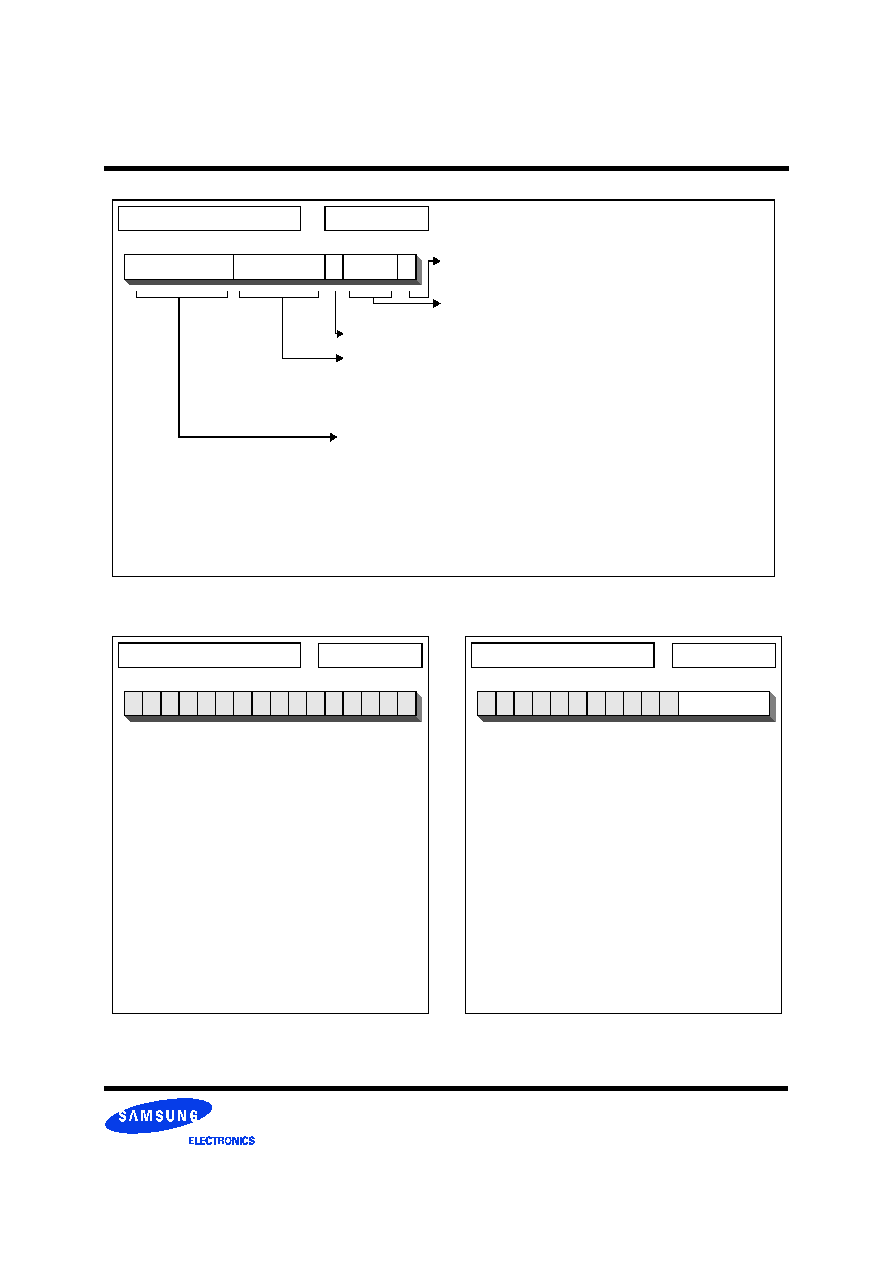
Page 33
Direct RDRAM
TM
K4R881869M
Rev. 0.9 Jan. 2000
Preliminary
. .
Figure 29: CNFGB Register
15 14 13 12 11 10
9
8
7
6
5
4
3
2
1
0
Control Register: CNFGB
Address: 024
16
0
0
0
0
0
0
0
0
0
0
0
0
0
0
0
0
Read-only register.
BYT - Byte width. B=1 means the device reads and
writes 9-bit memory bytes. B=0 means 8 bits.
DEVTYP2..0 - Device type. DEVTYP = 000 means
that this device is an RDRAM.
DEVTYP2..0
= 000
BYT
B
SVER5..0
= 000000
CORG4..0
= 01000
SPT
1
SPT - Split-core. SPT=1 means the core is split, SPT=0 means it is not.
CORG4..0 - Core organization. This field specifies the number of bank (5
bits), row (9 bits), and column (7 bits) address bits.
SVER5..0 - Stepping version. Specifies the mask version number of this
device.
Figure 30: TEST Register
15 14 13 12 11 10
9
8
7
6
5
4
3
2
1
0
Read/write register.
Reset value of TEST34 is zero (from SIO Reset)
This register are used for testing purposes. It must not
be read or written after SIO Reset.
Control Register: TEST34
Address: 022
16
0
0
0
0
0
0
0
0
0
0
0
0
0
0
0
0
Figure 31: DEVID Register
15 14 13 12 11 10
9
8
7
6
5
4
3
2
1
0
Read/write register.
Reset value is undefined.
Device Identification register.
DEVID4..DEVID0 is compared to DR4..DR0,
DC4..DC0, and DX4..DX0 fields for all memory read
or write transactions. This determines which RDRAM
is selected for the memory read or write transaction.
Control Register: DEVID
Address: 040
16
0
DEVID4..DEVID0
0
0
0
0
0
0
0
0
0
0

Page 34
Direct RDRAM
TM
K4R881869M
Rev. 0.9 Jan. 2000
Preliminary
Figure 32: REFB Register
Figure 33: CCA Register
15 14 13 12 11 10
9
8
7
6
5
4
3
2
1
0
Read/write register.
Reset value is zero (from SETR/CLRR).
Refresh Bank register.
REFB4..REFB0 is the bank that will be refreshed next
during self-refresh. REFB4..0 is incremented after each
self-refresh activate and precharge operation pair.
Control Register: REFB
Address: 041
16
0
0
0
0
0
0
0
0
0
0
0
0
REFB4..REFB0
15 14 13 12 11 10
9
8
7
6
5
4
3
2
1
0
Read/write register.
Reset value is zero (SETR/CLRR or SIO Reset).
CCA6..CCA0 - Current Control A. Controls the I
OL
output current for the DQA8..DQA0 pins.
ASYMB0 control the asymmetry of the V
OL
/V
OH
voltage swing about the V
REF
reference voltage for the
DQA8..0 pins.
Control Register: CCA
Address: 043
16
0
0
0
0
0
0
0
0
CCA6..CCA0
.0
ASYMA
0
Figure 34: REFR Register
Figure 35: CCB Register
15 14 13 12 11 10
9
8
7
6
5
4
3
2
1
0
Read/write register.
Reset value is zero (from SETR/CLRR).
Refresh Row register.
REFR8..REFR0 is the row that will be refreshed next
by the REFA command or by self-refresh. REFR8..0 is
incremented when BR4..0=11111 for the REFA
command. REFR8..0 is incremented when
REFB4..0=11111 for self-refresh.
Control Register: REFR
Address: 042
16
0
0
0
0
0
0
0
REFR8..REFR0
15 14 13 12 11 10
9
8
7
6
5
4
3
2
1
0
Read/write register.
Reset value is zero (SETR/CLRR or SIO Reset).
CCB6..CCB0 - Current Control B. Controls the I
OL
output current for the DQB8..DQB0 pins.
ASYMB0 control the asymmetry of the V
OL
/V
OH
voltage swing about the V
REF
reference voltage for the
DQB8..0 pins.
Control Register: CCB
Address: 044
16
0
0
0
0
0
0
0
0
CCB6..CCB0
..0
ASYMB
0
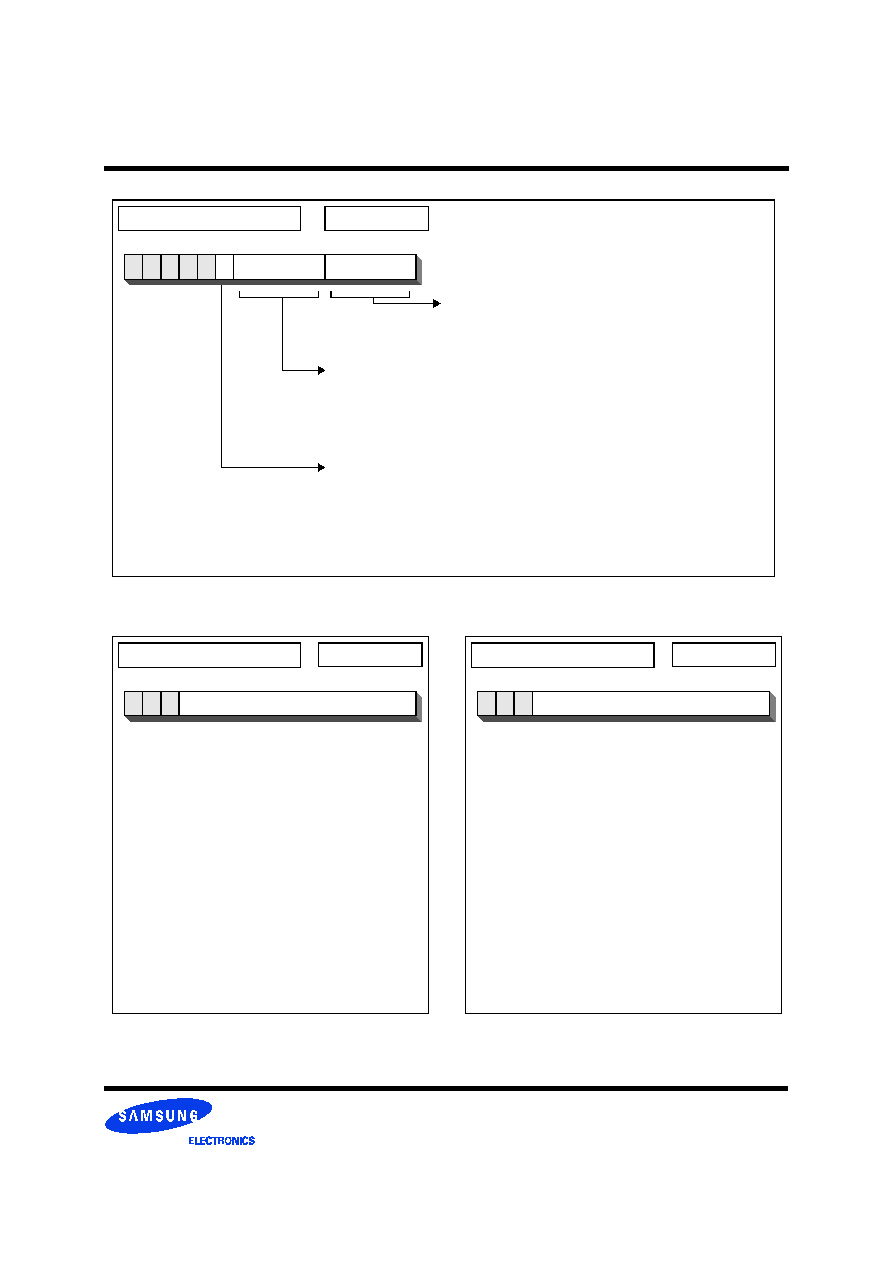
Page 35
Direct RDRAM
TM
K4R881869M
Rev. 0.9 Jan. 2000
Preliminary
.
Figure 36: NAPX Register
15 14 13 12 11 10
9
8
7
6
5
4
3
2
1
0
Control Register: NAPX
Address: 045
16
Read/write register.
Reset value is undefined
Note - t
SCYCLE
is t
CYCLE1
(SCK cycle time).
NAPXA4..0 - Nap Exit Phase A. This field specifies
the number of SCK cycles during the first phase for
exiting NAP mode. It must satisfy:
NAPXA∑t
SCYCLE
t
NAPXA,MAX
Do not set this field to zero.
0
0
0
0
0
0
DQS
NAPXA4..0
NAPX4..0
NAPX4..0 - Nap Exit Phase A plus B. This field specifies the number of SCK
cycles during the first plus second phases for exiting NAP mode. It must satisfy:
NAPX∑t
SCYCLE
NAPXA∑t
SCYCLE
+t
NAPXB,MAX
Do not set this field to zero.
DQS - DQ Select. This field specifies the number of SCK cycles (0 => 0.5
cycles, 1 => 1.5 cycles) between the CMD pin framing sequence and the device
selection on DQ5..0. See Figure 48 - This field must be written with a
"
1
"
for
this RDRAM.
Figure 37: PDNXA Register
15 14 13 12 11 10
9
8
7
6
5
4
3
2
1
0
Read/write register.
Reset value is undefined
PDNXA4..0 - PDN Exit Phase A. This field specifies
the number of (64∑SCK cycle) units during the first
phase for exiting PDN mode. It must satisfy:
PDNXA∑64∑t
SCYCLE
t
PDNXA,MAX
Do not set this field to zero.
Note - only PDNXA5..0 are implemented.
Note - t
SCYCLE
is t
CYCLE1
(SCK cycle time).
Control Register: PDNXA
Address: 046
16
0
0
0
PDNXA12..0
Figure 38: PDNX Register
15 14 13 12 11 10
9
8
7
6
5
4
3
2
1
0
Read/write register.
Reset value is undefined
PDNX4..0 - PDN Exit Phase A plus B. This field spec-
ifies the number of (256∑SCK cycle) units during the
first plus second phases for exiting PDN mode. It
should satisfy:
PDNX∑256∑t
SCYCLE
PDNXA∑64∑t
SCYCLE
+
t
PDNXB,MAX
If this equation can't be satisfied, then the maximum
PDNX value should be written, and the t
S4
/t
H4
timing
window will be modified (see Figure 49).
Do not set this field to zero.
Note - only PDNX2..0 are implemented.
Note - t
SCYCLE
is t
CYCLE1
(SCK cycle time).
Control Register: PDNX
Address: 047
16
0
0
0
PDNX12..0

Page 36
Direct RDRAM
TM
K4R881869M
Rev. 0.9 Jan. 2000
Preliminary
.
Figure 39: TPARM Register
15 14 13 12 11 10
9
8
7
6
5
4
3
2
1
0
Read/write register.
Reset value is undefined.
TCAS1..0 - Specifies the t
CAS-C
core parameter in
t
CYCLE
units. This should be
"
10
"
(2∑t
CYCLE
).
TCLS1..0 - Specifies the t
CLS-C
core parameter in
t
CYCLE
units. Should be
"
10
"
(2∑t
CYCLE
).
TCDLY0 - Specifies the t
CDLY0-C
core parameter in
t
CYCLE
units. This adds a programmable delay to Q
(read data) packets, permitting round trip read delay to
all devices to be equalized. This field may be written
with the values
"
011
"
(3∑t
CYCLE
) through
"
101
"
(5∑t
CYCLE
).
Control Register: TPARM
Address: 048
16
0
0
0
0
0
0
0
0
0
0
0
0
TCAS
TCLS
The equations relating the core parameters to the
datasheet parameters follow:
t
CAS-C
= 2∑t
CYCLE
t
CLS-C
= 2∑t
CYCLE
t
CPS-C
= 1∑t
CYCLE
Not programmable
t
OFFP
= t
CPS-C
+ t
CAS-C
+ t
CLS-C
- 1∑t
CYCLE
= 4∑t
CYCLE
t
RCD
= t
RCD-C
+ 1∑t
CYCLE
- t
CLS-C
= t
RCD-C
- 1∑t
CYCLE
t
CAC
= 3∑t
CYCLE
+ t
CLS-C
+ t
CDLY0-C
+ t
CDLY1-C
(see table below for programming ranges)
TCDLY0
011
011
101
100
TCDLY0
011
3∑t
CYCLE
3∑t
CYCLE
5∑t
CYCLE
4∑t
CYCLE
t
CDLY0-C
3∑t
CYCLE
010
001
010
010
TCDLY1
000
2
∑
t
CYCLE
1
∑
t
CYCLE
2
∑
t
CYCLE
2
∑
t
CYCLE
t
CDLY1-C
0
∑
t
CYCLE
10
∑
t
CYCLE
9
∑
t
CYCLE
12
∑
t
CYCLE
11
∑
t
CYCLE
t
CAC
8
∑
t
CYCLE
Figure 40: TFRM Register
15 14 13 12 11 10
9
8
7
6
5
4
3
2
1
0
Read/write register.
Reset value is undefined.
TFRM3..0 - Specifies the position of the framing point
in t
CYCLE
units. This value must be greater than or
equal to the t
FRM,MIN
parameter. This is the minimum
offset between a ROW packet (which places a device
at ATTN) and the first COL packet (directed to that
device) which must be framed. This field may be
written with the values
"
0111
"
(7∑t
CYCLE
) through
"
1010
"
(10∑t
CYCLE
). TFRM is usually set to the value
which matches the largest t
RCD,MIN
parameter (modulo
4∑t
CYCLE
) that is present in an RDRAM in the memory
system. Thus, if an RDRAM with t
RCD,MIN
= 9∑t
CYCLE
were present, then TFRM would be programmed to
5∑t
CYCLE
.
Control Register: TFRM
Address: 049
16
0
0
0
0
0
0
0
0
0
0
0
0
TFRM3..0
Figure 41: TRDLY Register
15 14 13 12 11 10
9
8
7
6
5
4
3
2
1
0
Read/write register.
Reset value is undefined.
TCDLY1 - Specifies the value of the t
CDLY1-C
core
parameter in t
CYCLE
units. This adds a programmable
delay to Q (read data) packets, permitting round trip
read delay to all devices to be equalized. This field may
be written with the values
"
000
"
(0∑t
CYCLE
) through
"
010
"
(2∑t
CYCLE
). Refer to Figure 39 for more details.
Control Register: TCDLY1
Address: 04a
16
0
0
0
0
0
0
0
0
0
0
0
0
0
0
TCDLY1
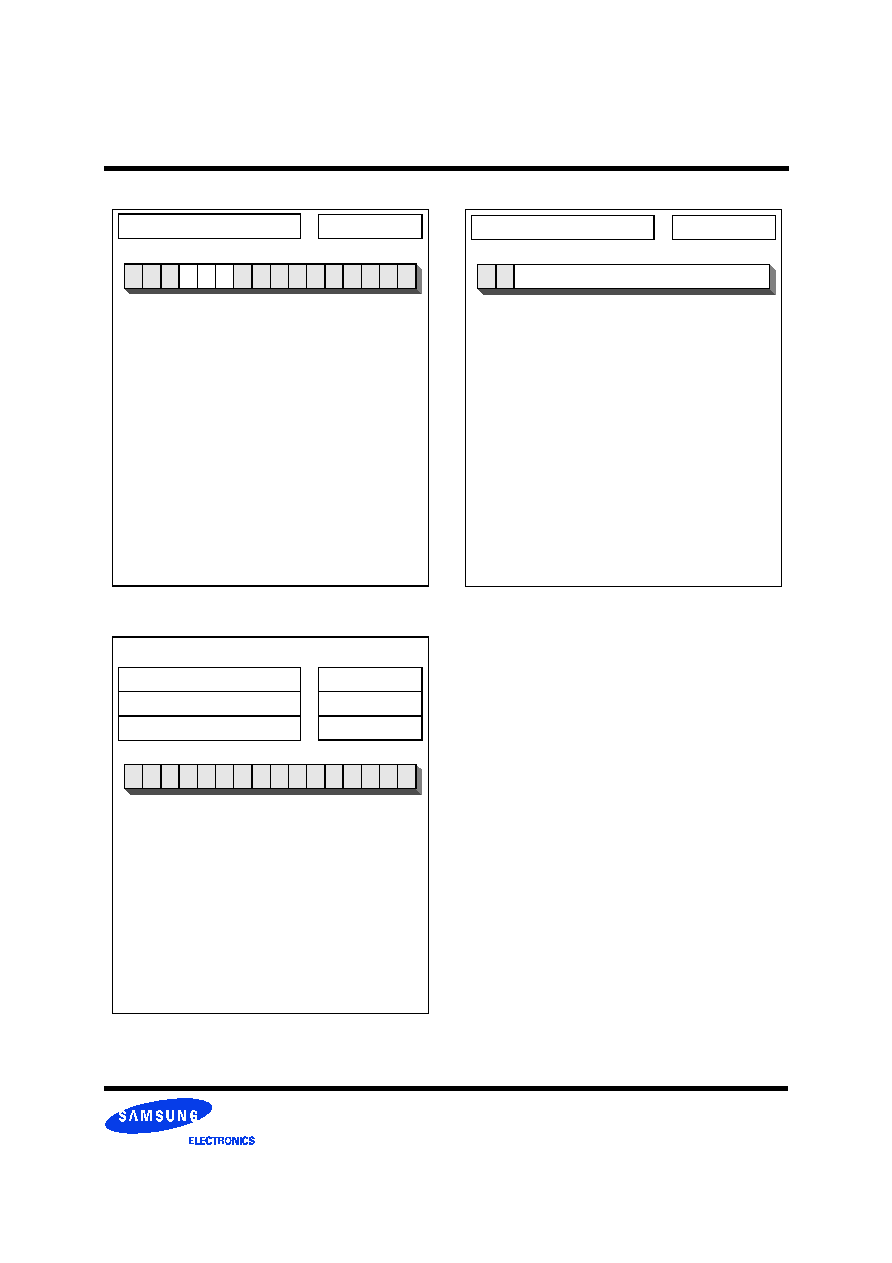
Page 37
Direct RDRAM
TM
K4R881869M
Rev. 0.9 Jan. 2000
Preliminary
Figure 42: SKIP Register
Figure 43: TEST Registers
15 14 13 12 11 10
9
8
7
6
5
4
3
2
1
0
Read/write register (except AS field).
Reset value is zero (SIO Reset).
AS - Autoskip. Read-only value determined by
autoskip circuit and stored when SETF serial command
is received by RDRAM during initialization. In figure
58, AS=1 corresponds to the early Q(a1) packet and
AS=0 to the Q(a1) packet one t
CYCLE
later for the four
uncertain cases.
MSE - Manual skip enable (0=auto, 1=manual).
MS - Manual skip (MS must be 1 when MSE=1).>
During initialization, the RDRAMs at the furthest point
in the fifth read domain may have selected the AS=0
value, placing them at the closest point in a sixth read
domain. Setting the MSE/MS fields to 1/1 overrides
the autoskip value and returns them to the furthest
point of the fifth read domain.
Control Register: SKIP
Address: 04b
16
0
0
0
0
0
0
0
0
0
0
0
0
0
0
AS
0
0
MSE MS
15 14 13 12 11 10
9
8
7
6
5
4
3
2
1
0
Read/write registers.
Reset value of TEST78,79 is zero ( SIO Reset).
Do not read or write TEST78,79 after SIO reset.
TEST77 must be written with zero after SIO reset.
These registers must only be used for testing purposes.
0
0
0
0
0
0
0
0
0
0
0
0
0
0
0
0
Control Register: TEST77
Address: 04d
16
Control Register: TEST78
Address: 04e
16
Control Register: TEST79
Address: 04f
16
Figure 44: TCYCLE Register
15 14 13 12 11 10
9
8
7
6
5
4
3
2
1
0
Read/write register.
Reset value is undefined
TCYCLE13..0 - Specifies the value of the t
CYCLE
datasheet parameter in 64ps units. For the t
CYCLE,MIN
of 2.5ns (2500ps), this field should be written with the
value
"
00027
16
"
(39∑64ps).
Control Register: TCYCLE
Address: 04c
16
0
0
TCYCLE13..TCYCLE0

Page 38
Direct RDRAM
TM
K4R881869M
Rev. 0.9 Jan. 2000
Preliminary
Power State Management
Table 17 summarizes the power states available to a Direct
RDRAM. In general, the lowest power states have the
longest operational latencies. For example, the relative
power levels of PDN state and STBY state have a ratio of
about 1:110, and the relative access latencies to get read data
have a ratio of about 250:1.
PDN state is the lowest power state available. The informa-
tion in the RDRAM core is usually maintained with self-
refresh; an internal timer automatically refreshes all rows of
all banks. PDN has a relatively long exit latency because the
TCLK/RCLK block must resynchronize itself to the external
clock signal.
NAP state is another low-power state in which either self-
refresh or REFA-refresh are used to maintain the core. See
"
Refresh
"
on page 42 for a description of the two refresh
mechanisms. NAP has a shorter exit latency than PDN
because the TCLK/RCLK block maintains its synchroniza-
tion state relative to the external clock signal at the time of
NAP entry. This imposes a limit (t
NLIMIT
) on how long an
RDRAM may remain in NAP state before briefly returning
to STBY or ATTN to update this synchronization state.
Figure 45 summarizes the transition conditions needed for
moving between the various power states. Note that NAP
and PDN have been divided into two substates (NAP-
A/NAP-S and PDN-A/PDN-S) to account for the fact that a
NAP or PDN exit may be made to either ATTN or STBY
states.
At initialization, the SETR/CLRR Reset sequence will put
the RDRAM into PDN-S state. The PDN exit sequence
involves an optional PDEV specification and bits on the
CMD and SIO
IN
pins.
Once the RDRAM is in STBY, it will move to the
ATTN/ATTNR/ATTNW states when it receives a non-
broadcast ROWA packet or non-broadcast ROWR packet
with the ATTN command. The RDRAM returns to STBY
from these three states when it receives a RLX command.
Alternatively, it may enter NAP or PDN state from ATTN or
STBY states with a NAPR or PDNR command in an ROWR
packet. The PDN or NAP exit sequence involves an optional
PDEV specification and bits on the CMD and SIO0 pins.
The RDRAM returns to the ATTN or STBY state it was
originally in when it first entered NAP or PDN.
An RDRAM may only remain in NAP state for a time
t
NLIMIT
. It must periodically return to ATTN or STBY.
The NAPRC command causes a napdown operation if the
RDRAM's NCBIT is set. The NCBIT is not directly visible.
It is undefined on reset. It is set by a NAPR command to the
RDRAM, and it is cleared by an ACT command to the
RDRAM. It permits a controller to manage a set of
RDRAMs in a mixture of power states.
STBY state is the normal idle state of the RDRAM. In this
state all banks and sense amps have usually been left
precharged and ROWA and ROWR packets on the ROW
pins are being monitored. When a non-broadcast ROWA
packet or non-broadcast ROWR packet (with the ATTN
command) packet addressed to the RDRAM is seen, the
RDRAM enters ATTN state (see the right side of Figure 46).
This requires a time t
SA
during which the RDRAM activates
the specified row of the specified bank. A time
TFRM∑t
CYCLE
after the ROW packet, the RDRAM will be
Table 17: Power State Summary
Power
State
Description
Blocks consuming power
Power
State
Description
Blocks consuming power
PDN
Powerdown state.
Self-refresh
NAP
Nap state. Similar to PDN
except lower wake-up
latency.
Self-refresh or
REFA-refresh
TCLK/RCLK-Nap
STBY
Standby state.
Ready for ROW
packets.
REFA-refresh
TCLK/RCLK
ROW demux receiver
ATTN
Attention state.
Ready for ROW and COL
packets.
REFA-refresh
TCLK/RCLK
ROW demux receiver
COL demux receiver
ATTNR
Attention read state.
Ready for ROW and COL
packets.
Sending Q (read data)
packets.
REFA-refresh
TCLK/RCLK
ROW demux receiver
COL demux receiver
DQ mux transmitter
Core power
ATTNW
Attention write state.
Ready for ROW and COL
packets.
Ready for D (write data)
packets.
REFA-refresh
TCLK/RCLK
ROW demux receiver
COL demux receiver
DQ demux receiver
Core power
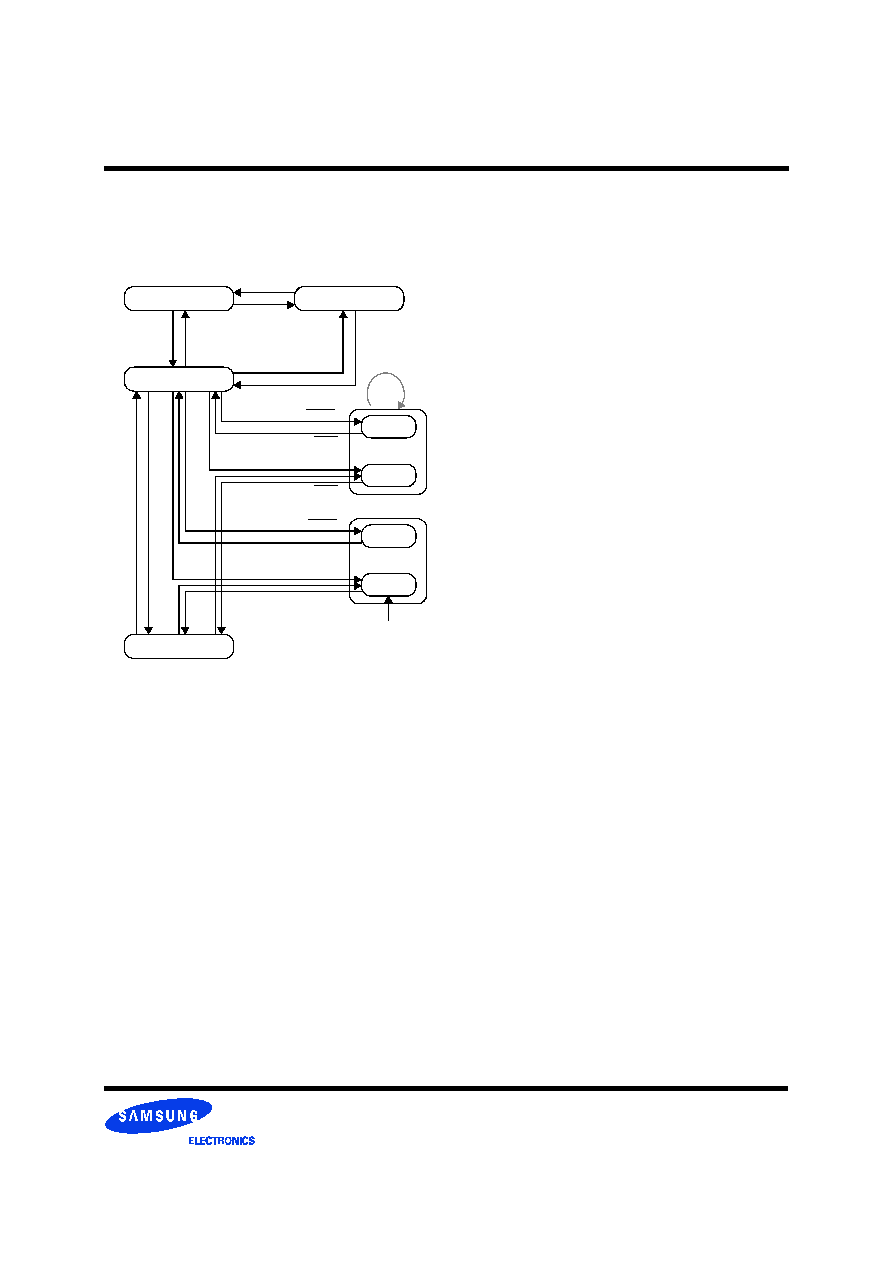
Page 39
Direct RDRAM
TM
K4R881869M
Rev. 0.9 Jan. 2000
Preliminary
able to frame COL packets (TFRM is a control register field
- see Figure 40). Once in ATTN state, the RDRAM will
automatically transition to the ATTNW and ATTNR states
as it receives WR and RD commands.
Once the RDRAM is in ATTN, ATTNW, or ATTNR states,
it will remain there until it is explicitly returned to the STBY
state with a RLX command. A RLX command may be given
in an ROWR, COLC , or COLX packet (see the left side of
Figure 46). It is usually given after all banks of the RDRAM
have been precharged; if other banks are still activated, then
the RLX command would probably not be given.
If a broadcast ROWA packet or ROWR packet (with the
ATTN command) is received, the RDRAM's power state
doesn't change. If a broadcast ROWR packet with RLXR
command is received, the RDRAM goes to STBY.
Figure 47 shows the NAP entry sequence (left). NAP state is
entered by sending a NAPR command in a ROW packet. A
time t
ASN
is required to enter NAP state (this specification is
provided for power calculation purposes). The clock on
CTM/CFM must remain stable for a time t
CD
after the
NAPR command.
The RDRAM may be in ATTN or STBY state when the
NAPR command is issued. When NAP state is exited, the
RDRAM will return to the original starting state (ATTN or
STBY). If it is in ATTN state and a RLXR command is
specified with NAPR, then the RDRAM will return to STBY
state when NAP is exited.
Figure 47 also shows the PDN entry sequence (right). PDN
state is entered by sending a PDNR command in a ROW
packet. A time t
ASP
is required to enter PDN state (this spec-
ification is provided for power calculation purposes). The
clock on CTM/CFM must remain stable for a time t
CD
after
the PDNR command.
The RDRAM may be in ATTN or STBY state when the
PDNR command is issued. When PDN state is exited, the
RDRAM will return to the original starting state (ATTN or
STBY). If it is in ATTN state and a RLXR command is
specified with PDNR, then the RDRAM will return to STBY
state when PDN is exited. The current- and slew-rate-control
levels are re-established.
The RDRAM's write buffer must be retired with the appro-
priate COP command before NAP or PDN are entered. Also,
all the RDRAM's banks must be precharged before NAP or
PDN are entered. The exception to this is if NAP is entered
with the NSR bit of the INIT register cleared (disabling self-
refresh in NAP). The commands for relaxing, retiring, and
precharging may be given to the RDRAM as late as the
ROPa0, COPa0, and XOPa0 packets in Figure 47. No broad-
cast packets nor packets directed to the RDRAM entering
Nap or PDN may overlay the quiet window. This window
extends for a time t
NPQ
after the packet with the NAPR or
PDNR command.
Figure 48 shows the NAP and PDN exit sequences. These
sequences are virtually identical; the minor differences will
be highlighted in the following description.
Before NAP or PDN exit, the CTM/CFM clock must be
stable for a time t
CE
. Then, on a falling and rising edge of
SCK, if there is a
"
01
"
on the CMD input, NAP or PDN state
will be exited. Also, on the falling SCK edge the SIO0 input
must be at a 0 for NAP exit and 1 for PDN exit.
If the PSX bit of the INIT register is 0, then a device
PDEV5..0 is specified for NAP or PDN exit on the DQA5..0
pins. This value is driven on the rising SCK edge 0.5 or 1.5
SCK cycles after the original falling edge, depending upon
the value of the DQS bit of the NAPX register. If the PSX bit
of the INIT register is 1, then the RDRAM ignores the
Figure 45: Power State Transition Diagram
automatic
automatic
a
u
t
o
m
a
t
i
c
a
u
t
o
m
a
t
i
c
a
u
t
o
m
a
t
i
c
a
u
t
o
m
a
t
i
c
ATTNR
ATTNW
ATTN
STBY
SETR/CLRR
NAP-A
NAPR ∑ RLXR
Notation:
SETR/CLRR - SETR/CLRR Reset sequence in SRQ packets
t
NLIMIT
NAP
NAP-S
PDEV.CMD∑SIO0
NAPR ∑ RLXR
PDEV.CMD∑SIO0
PDN-A
PDNR
∑
RLXR
PDN
PDN-S
PDEV.CMD∑SI O0
PDNR
∑
RLXR
PDEV.CMD∑SI O0
N
A
P
R
P
D
N
R
A
T
T
N
R
L
X
PDNR - PDNR command in ROWR packet
NAPR - NAPR command in ROWR packet
RLXR - RLX command in ROWR packet
RLX - RLX command in ROWR,COLC,COLX packets
SIO0 - SIO0 input value
PDEV.CMD - (PDEV=DEVID)∑(CMD=01)
ATTN - ROWA packet (non-broadcast) or ROWR packet
(non-broadcast) with ATTN command
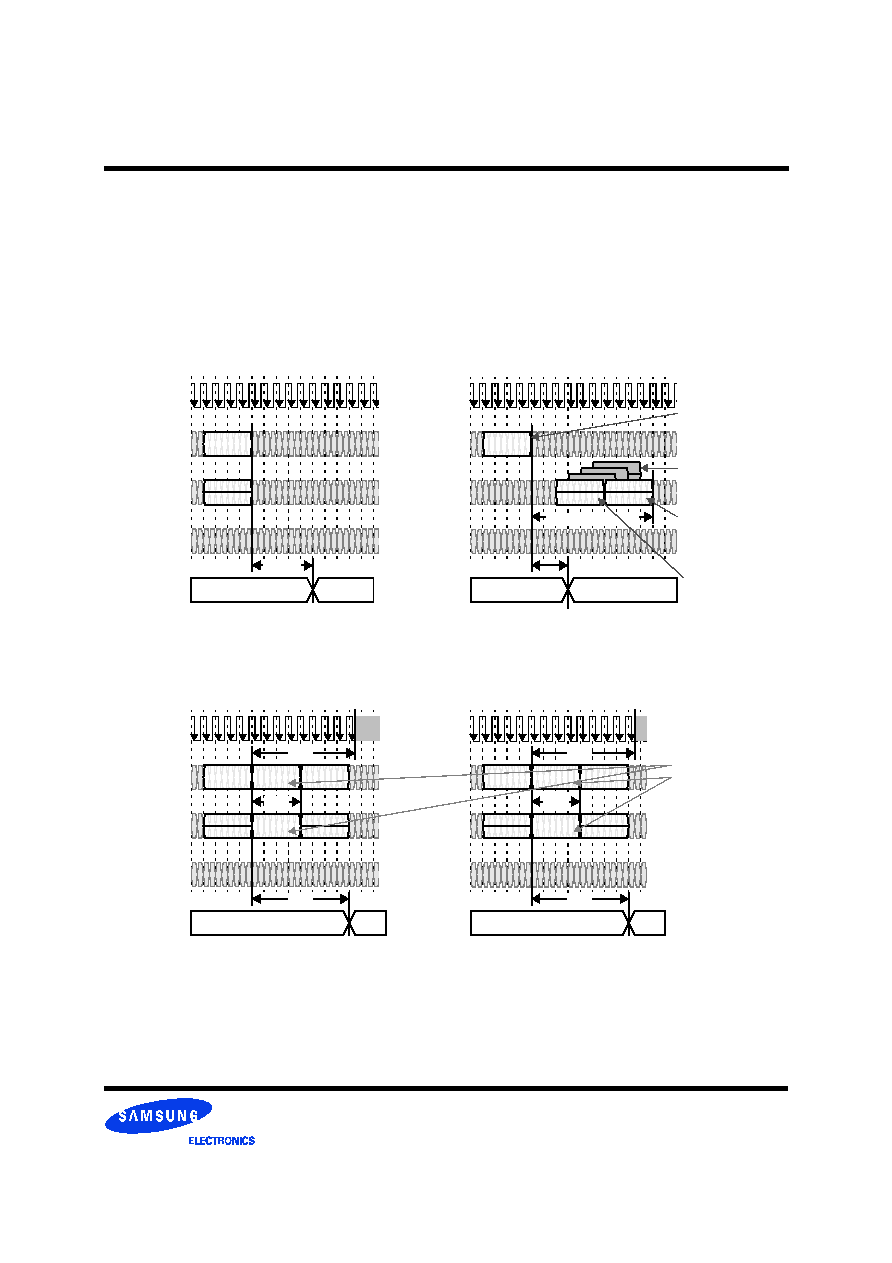
Page 40
Direct RDRAM
TM
K4R881869M
Rev. 0.9 Jan. 2000
Preliminary
PDEV5..0 address packet and exits NAP or PDN when the
wake-up sequence is presented on the CMD wire. The ROW
and COL pins must be quiet at a time t
S4
/t
H4
around the indi-
cated falling SCK edge (timed with the PDNX or NAPX
register fields). After that, ROW and COL packets may be
directed to the RDRAM which is now in ATTN or STBY
state.
Figure 49 shows the constraints for entering and exiting
NAP and PDN states. On the left side, an RDRAM exits
NAP state at the end of cycle T
3
. This RDRAM may not re-
enter NAP or PDN state for an interval of t
NU0
. The
RDRAM enters NAP state at the end of cycle T
13
. This
RDRAM may not re-exit NAP state for an interval of t
NU1
.
The equations for these two parameters depend upon a
number of factors, and are shown at the bottom of the figure.
NAPX is the value in the NAPX field in the NAPX register.
On the right side of Figure 48, an RDRAM exits PDN state
at the end of cycle T
3
. This RDRAM may not re-enter PDN
or NAP state for an interval of t
PU0
. The RDRAM enters
PDN state at the end of cycle T
13
. This RDRAM may not re-
exit PDN state for an interval of t
PU1
. The equations for
these two parameters depend upon a number of factors, and
are shown at the bottom of the figure. PDNX is the value in
the PDNX field in the PDNX register.
Figure 46: STBY Entry (left) and STBY Exit (right)
STBY
ATTN
CTM/CFM
DQA8..0
DQB8..0
COL4
..COL0
ROW2
..ROW0
T
0
T
4
T
8
T
12
T
1
T
5
T
9
T
13
T
2
T
6
T
10
T
14
T
3
T
7
T
11
T
15
T
16
T
20
T
17
T
21
T
18
T
22
T
19
T
23
CTM/CFM
DQA8..0
DQB8..0
COL4
..COL0
ROW2
..ROW0
T
0
T
4
T
8
T
12
T
1
T
5
T
9
T
13
T
2
T
6
T
10
T
14
T
3
T
7
T
11
T
15
T
16
T
20
T
17
T
21
T
18
T
22
T
19
T
23
t
AS
RLXR
Power
State
ATTN
Power
State
STBY
t
SA
ROP a0
RLXC
RLXX
TFRM∑t
CYCLE
ROP = non-broadcast ROWA
or ROWR/ATTN
a0 = {d0,b0,r0}
a1 = {d1,b1,c1}
No COL packets may be
placed in the three
indicated positions; i.e. at
(TFRM - {1,2,3})∑t
CYCLE
.
A COL packet to device d0
(or any other device) is okay
at
(TFRM)∑t
CYCLE
or later.
A COL packet to another
device (d1!= d0) is okay at
(TFRM - 4)∑t
CYCLE
or earlier.
COP a1
XOP a1
COP a1
XOP a1
COP a1
XOP a1
COP a0
XOP a0
COP a1
XOP a1
Figure 47: NAP Entry (left) and PDN Entry (right)
CTM/CFM
DQA8..0
DQB8..0
COL4
..COL0
ROW2
..ROW0
T
0
T
4
T
8
T
12
T
1
T
5
T
9
T
13
T
2
T
6
T
10
T
14
T
3
T
7
T
11
T
15
T
16
T
20
T
17
T
21
T
18
T
22
T
19
T
23
CTM/CFM
DQA8..0
DQB8..0
COL4
..COL0
ROW2
..ROW0
T
0
T
4
T
8
T
12
T
1
T
5
T
9
T
13
T
2
T
6
T
10
T
14
T
3
T
7
T
11
T
15
T
16
T
20
T
17
T
21
T
18
T
22
T
19
T
23
ROP a0
(NAPR)
Power
State
Power
State
a
The (eventual) NAP/PDN exit will be to the same ATTN/STBY state the RDRAM was in prior to NAP/PDN entry
t
CD
ROP a1
COP a0
XOP a0
COP a1
XOP a1
t
ASN
ATTN/STBY
a
NAP
ROP a0
(PDNR)
ROP a1
COP a0
XOP a0
COP a1
XOP a1
t
ASP
ATTN/STBY
a
PDN
quiet
quiet
quiet
quiet
t
CD
t
NPQ
t
NPQ
restricted
restricted
restricted
restricted
a0 = {d0,b0,r0,c0}
a1 = {d1,b1,r1,c1}
No ROW or COL packets
directed to device d0 may
overlap the restricted
interval. No broadcast ROW
packets may overlap the quiet
interval.
ROW or COL packets to a
device other than d0 may
overlap the restricted
interval.
ROW or COL packets
directed to device d0 after the
restricted interval will be
ignored.
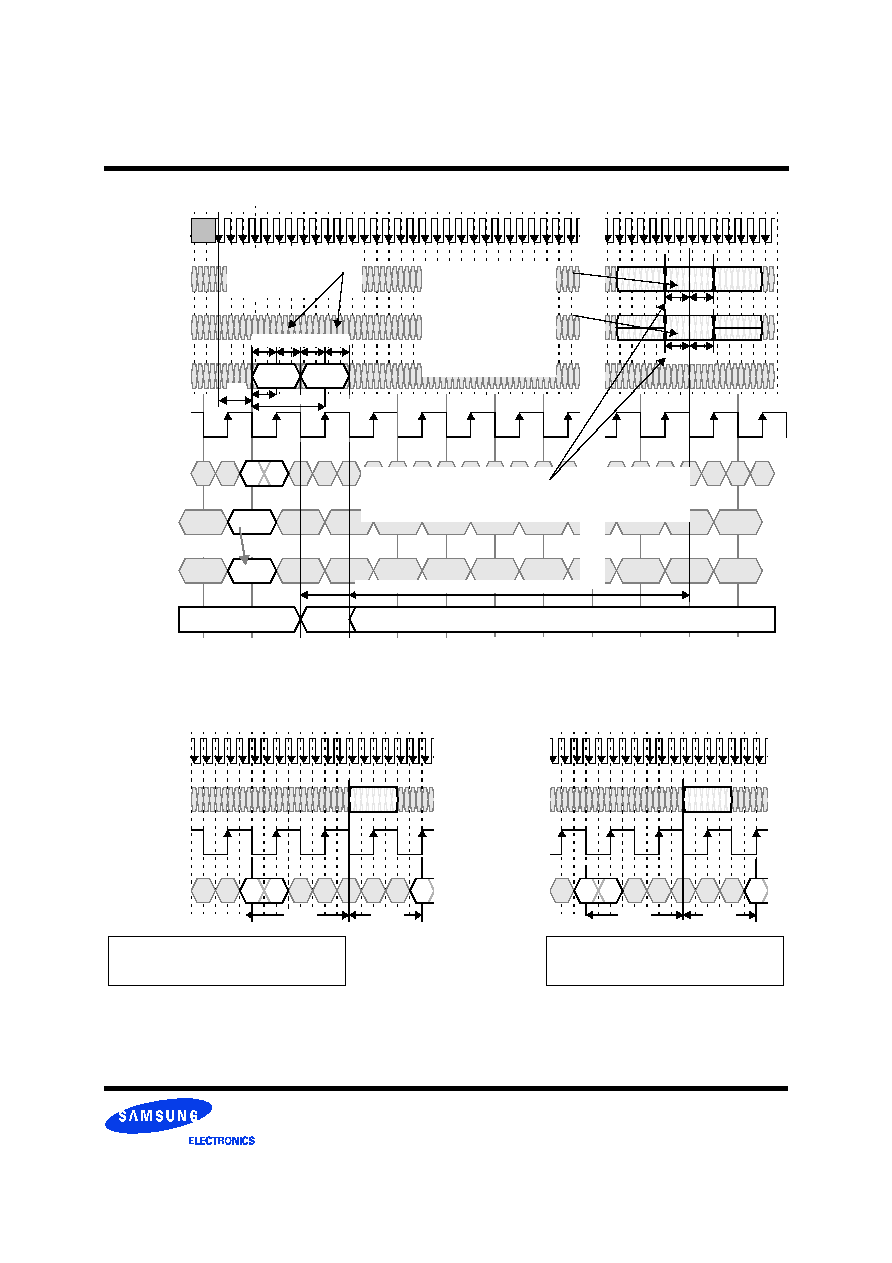
Page 41
Direct RDRAM
TM
K4R881869M
Rev. 0.9 Jan. 2000
Preliminary
Figure 48: NAP and PDN Exit
Figure 49: NAP Entry/Exit Windows (left) and PDN Entry/Exit Windows (right)
CTM/CFM
DQA8..0
DQB8..0
COL4
..COL0
ROW2
..ROW0
T
0
T
4
T
8
T
12
T
1
T
5
T
9
T
13
T
2
T
6
T
10
T
14
T
3
T
7
T
11
T
15
T
16
T
20
T
24
T
28
T
17
T
21
T
25
T
29
T
18
T
22
T
26
T
30
T
19
T
23
T
27
T
31
T
32
T
36
T
40
T
44
T
33
T
37
T
41
T
45
T
34
T
38
T
42
T
46
T
35
T
39
T
43
T
47
ROP
DQS=0
b,c
SCK
CMD
SIO0
SIO1
0
1
0/1
a
0/1
a
PDEV5..0
b
PDEV5..0
b
DQS=1
b
t
S3
t
S3
t
H3
t
H3
t
CE
a
Use 0 for NAP exit, 1 for PDN exit
b
Device selection timing slot is selected by DQS field of NAPX register
The packet is repeated
from SIO0 to SIO1
restricted
Power
State
DQS=0
b
DQS=1
b
d
Exit to STBY or ATTN depends upon whether RLXR was
asserted at NAP or PDN entry time
t
S4
t
H4
STBY/ATTN
d
NAP/PDN
(
NAPX)∑t
SCYCLE
)/(
256∑PDNX∑t
SCYCLE
)
restricted
t
S4
t
H4
COP
XOP
No ROW packets may
overlap the restricted interval
No COL packets may
overlap the restricted interval
if device PDEV is exiting the
NAP-A or PDN-A states
ROP
COP
XOP
c
The DQS field must be written with
"
1
"
for this RDRAM.
If PSX=1 in Init register, then
NAP/PDN exit is broadcast
(no PDEV field).
Effective hold becomes
t
H4
'=t
H4
+[PDNXA∑64∑t
SCYCLE
+t
PDNXB,MAX
]-[PDNX∑256∑t
SCYCLE
]
if [PDNX∑256∑t
SCYCLE
] < [PDNXA∑64∑t
SCYCLE
+t
PDNXB,MAX
].
t
PU0
= 5∑t
CYCLE
+ (2+256∑PDNX)∑t
SCYCLE
t
PU1
= 8∑t
CYCLE
- (0.5∑t
SCYCLE
)
= 23∑t
CYCLE
if PSR=0
if PSR=1
CTM/CFM
CMD
SCK
ROW2
..ROW0
T
0
T
4
T
8
T
12
T
1
T
5
T
9
T
13
T
2
T
6
T
10
T
14
T
3
T
7
T
11
T
15
T
16
T
20
T
17
T
21
T
18
T
22
T
19
T
23
NAPR
T
0
T
4
T
8
T
12
T
1
T
5
T
9
T
13
T
2
T
6
T
10
T
14
T
3
T
7
T
11
T
15
T
16
T
20
T
17
T
21
T
18
T
19
t
NU0
t
NU0
= 5∑t
CYCLE
+ (2+NAPX)∑t
SCYCLE
no entry to NAP or PDN
t
NU1
= 8∑t
CYCLE
- (0.5∑t
SCYCLE
)
PDNR
no exit
t
NU1
t
PU0
no exit
t
PU1
= 23∑t
CYCLE
if NSR=0
if NSR=1
NAP entry
PDN entry
no entry to NAP or PDN
0
1
NAP exit
0
1
PDN exit
0
1
CTM/CFM
CMD
SCK
ROW2
..ROW0
0
1
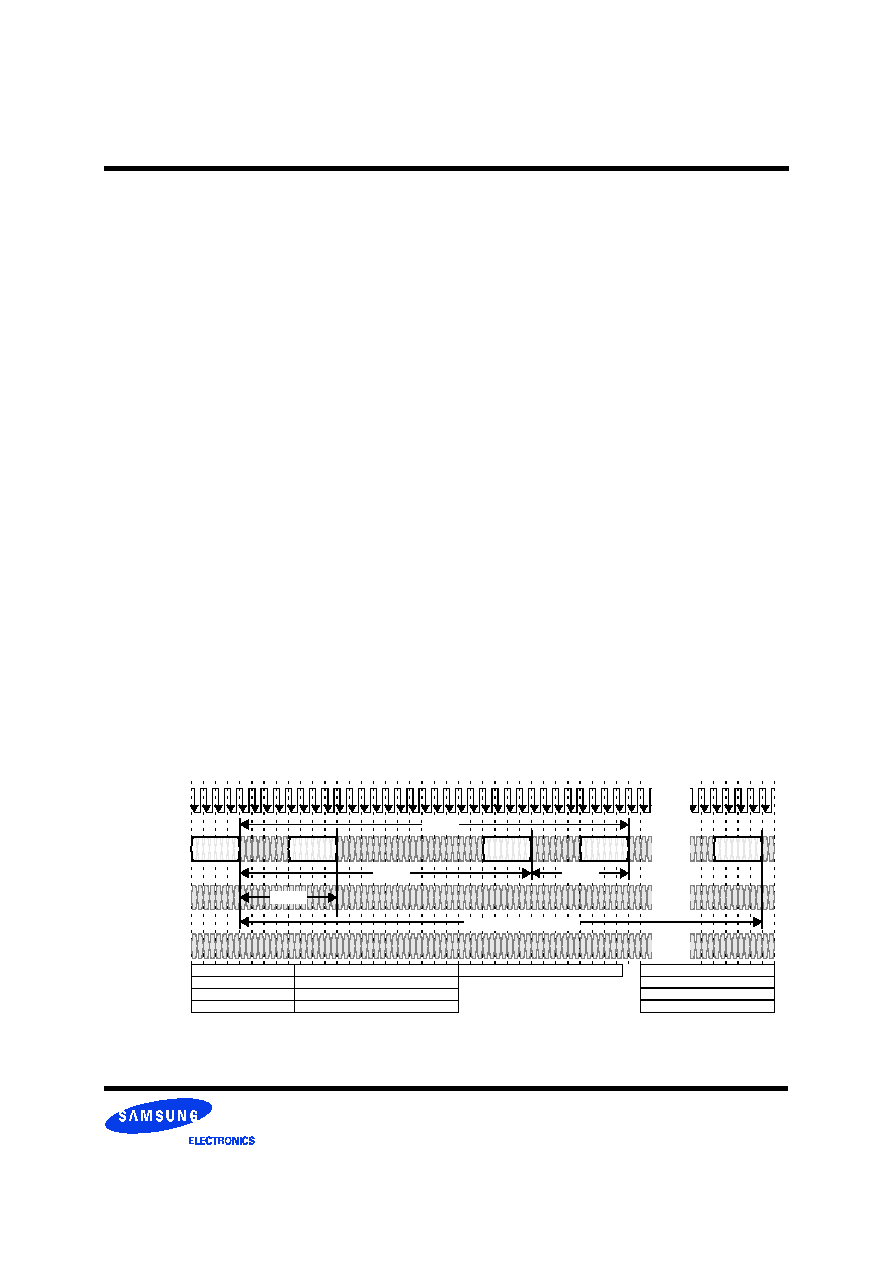
Page 42
Direct RDRAM
TM
K4R881869M
Rev. 0.9 Jan. 2000
Preliminary
Refresh
RDRAMs, like any other DRAM technology, use volatile
storage cells which must be periodically refreshed. This is
accomplished with the REFA command. Figure 50 shows an
example of this.
The REFA command in the transaction is typically a broad-
cast command (DR4T and DR4F are both set in the ROWR
packet), so that in all devices bank number Ba is activated
with row number REFR, where REFR is a control register in
the RDRAM. When the command is broadcast and ATTN is
set, the power state of the RDRAMs (ATTN or STBY) will
remain unchanged. The controller increments the bank
address Ba for the next REFA command. When Ba is equal
to its maximum value, the RDRAM automatically incre-
ments REFR for the next REFA command.
On average, these REFA commands are sent once every
t
REF
/2
BBIT+RBIT
(where BBIT are the number of bank
address bits and RBIT are the number of row address bits) so
that each row of each bank is refreshed once every t
REF
interval.
The REFA command is equivalent to an ACT command, in
terms of the way that it interacts with other packets (see
Table 10). In the example, an ACT command is sent after
t
RR
to address b0, a different (non-adjacent) bank than the
REFA command.
A second ACT command can be sent after a time t
RC
to
address c0, the same bank (or an adjacent bank) as the REFA
command.
Note that a broadcast REFP command is issued a time t
RAS
after the initial REFA command in order to precharge the
refreshed bank in all RDRAMs. After a bank is given a
REFA command, no other core operations (activate or
precharge) should be issued to it until it receives a REFP.
It is also possible to interleave refresh transactions (not
shown). In the figure, the ACT b0 command would be
replaced by a REFA b0 command. The b0 address would be
broadcast to all devices, and would be {Broad-
cast,Ba+2,REFR}. Note that the bank address should skip by
two to avoid adjacent bank interference. A possible bank
incrementing pattern would be: {13, 11, 9, 7, 5, 3, 1, 8, 10,
12, 14, 0, 2, 4, 6, 15, 29, 27, 25, 23, 21, 19, 17, 24, 26, 28,
30, 16, 18, 20, 22, 31}. Every time bank 31 is reached, the
REFA command would automatically increment the REFR
register.
A second refresh mechanism is available for use in PDN and
NAP power states. This mechanism is called self-refresh
mode. When the PDN power state is entered, or when NAP
power state is entered with the NSR control register bit set,
then self-refresh is automatically started for the RDRAM.
Self-refresh uses an internal time base reference in the
RDRAM. This causes an activate and precharge to be
carried out once in every t
REF
/2
BBIT+RBIT
interval. The
REFB and REFR control registers are used to keep track of
the bank and row being refreshed.
Before a controller places an RDRAM into self-refresh
mode, it should perform REFA/REFP refreshes until the
bank address is equal to the maximum value. This ensures
that no rows are skipped. Likewise, when a controller returns
an RDRAM to REFA/REFP refresh, it should start with the
minimum bank address value (zero).
Figure 50: REFA/REFP Refresh Transaction Example
CTM/CFM
DQA8..0
DQB8..0
COL4
..COL0
ROW2
..ROW0
T
0
T
4
T
8
T
12
T
1
T
5
T
9
T
13
T
2
T
6
T
10
T
14
T
3
T
7
T
11
T
15
T
16
T
20
T
24
T
28
T
17
T
21
T
25
T
29
T
18
T
22
T
26
T
30
T
19
T
23
T
27
T
31
T
32
T
36
T
40
T
44
T
33
T
37
T
41
T
45
T
34
T
38
T
42
T
46
T
35
T
39
T
43
T
47
REFA a0
ACT c0
t
RAS
t
RC
t
RP
Transaction a: REFA
a0 = {Broadcast,Ba,REFR}
a1 = {Broadcast,Ba}
Transaction c: xx
c0 = {Dc, ==Ba, Rc}
REFA d0
t
REF
/2
BBIT+RBIT
BBIT = # bank address bits
RBIT = # row address bits
ACT b0
Transaction d: REFA
d0 = {Broadcast,Ba+1,REFR}
REFB = REFB3..REFB0
REFR = REFR8..REFR0
t
RR
Transaction b: xx
b0 = {Db, /={Ba,Ba+1,Ba-1}, Rb}
REFP a1
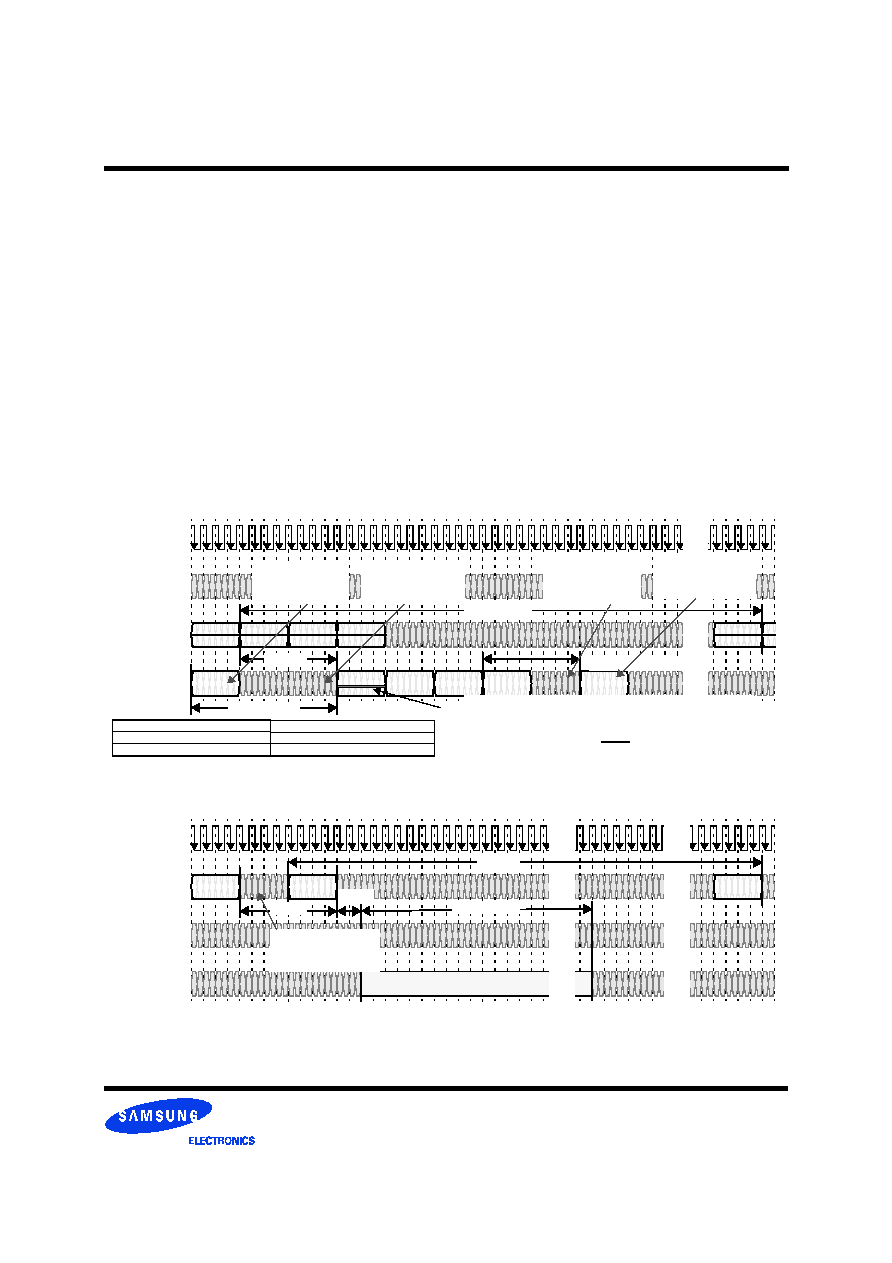
Page 43
Direct RDRAM
TM
K4R881869M
Rev. 0.9 Jan. 2000
Preliminary
Current and Temperature Control
Figure 51 shows an example of a transaction which performs
current control calibration. It is necessary to perform this
operation once to every RDRAM in every t
CCTRL
interval in
order to keep the I
OL
output current in its proper range.
This example uses four COLX packets with a CAL
command. These cause the RDRAM to drive four calibra-
tion packets Q(a0) a time t
CAC
later. An offset of t
RDTOCC
must be placed between the Q(a0) packet and read data
Q(a1)from the same device. These calibration packets are
driven on the DQA4..3 and DQB4..3 wires. The TSQ bit of
the INIT register is driven on the DQA5 wire during same
interval as the calibration packets. The remaining DQA and
DQB wires are not used during these calibration packets.
The last COLX packet also contains a SAM command
(concatenated with the CAL command). The RDRAM
samples the last calibration packet and adjusts its I
OL
current
value.
Unlike REF commands, CAL and SAM commands cannot
be broadcast. This is because the calibration packets from
different devices would interfere. Therefore, a current
control transaction must be sent every t
CCTRL
/N, where N is
the number of RDRAMs on the Channel. The device field
Da of the address a0 in the CAL/SAM command should be
incremented after each transaction.
Figure 52 shows an example of a temperature calibration
sequence to the RDRAM. This sequence is broadcast once
every t
TEMP
interval to all the RDRAMs on the Channel.
The TCEN and TCAL are ROP commands, and cause the
slew rate of the output drivers to adjust for temperature drift.
During the quiet interval t
TCQUIET
the devices being cali-
brated can't be read, but they can be written.
Figure 51: Current Control CAL/SAM Transaction Example
Figure 52: Temperature Calibration (TCEN-TCAL) Transactions to RDRAM
CTM/CFM
DQA8..0
DQB8..0
COL4
..COL0
ROW2
..ROW0
T
0
T
4
T
8
T
12
T
1
T
5
T
9
T
13
T
2
T
6
T
10
T
14
T
3
T
7
T
11
T
15
T
16
T
20
T
24
T
28
T
17
T
21
T
25
T
29
T
18
T
22
T
26
T
30
T
19
T
23
T
27
T
31
T
32
T
36
T
40
T
44
T
33
T
37
T
41
T
45
T
34
T
38
T
42
T
46
T
35
T
39
T
43
T
47
Transaction a0: CAL/SAM
a0 = {Da, Bx}
Transaction a1: RD
a1 = {Da, Bx}
CAL a0
CAL a2
Q (a0)
t
CAC
CAL a0
CAL a0
CAL/SAM a0
CAL
Q (a1)
t
READTOCC
a2 = {Da, Bx}
Transaction a2: CAL/SAM
Read data from the same
device from an earlier RD
command must be at this
packet position or earlier.
Read data from a different
device from an earlier RD
command can be anywhere
prior to the Q(a0) packet. .
Q (a1)
t
CCSAMTOREAD
Read data from a different
device from a later RD
command can be anywhere
after to the Q(a0) packet.
Read data from the same device
from a later RD command must
be at this packet position or
later.
t
CCTRL
DQA5 of the first calibrate packet has the inverted TSQ bit of INIT
control register; i.e. logic 0 or high voltage means hot temperature.
When used for monitoring, it should be enabled with the DQA3
bit (current control one value) in case there is no RDRAM present:
HotTemp = DQA5∑DQA3
Note that DQB3 could be used instead of DQA3.
CTM/CFM
DQA8..0
DQB8..0
COL4
..COL0
ROW2
..ROW0
T
0
T
4
T
8
T
12
T
1
T
5
T
9
T
13
T
2
T
6
T
10
T
14
T
3
T
7
T
11
T
15
T
16
T
20
T
24
T
28
T
17
T
21
T
25
T
29
T
18
T
22
T
26
T
30
T
19
T
23
T
27
T
31
T
32
T
36
T
40
T
44
T
33
T
37
T
41
T
45
T
34
T
38
T
42
T
46
T
35
T
39
T
43
T
47
t
TCEN
TCEN
TCAL
TCEN
t
TCAL
No read data from devices
t
TCQUIET
being calibrated
t
TEMP
Any ROW packet may be placed
in the gap between the ROW
packets with the TCEN and
TCAL commands.
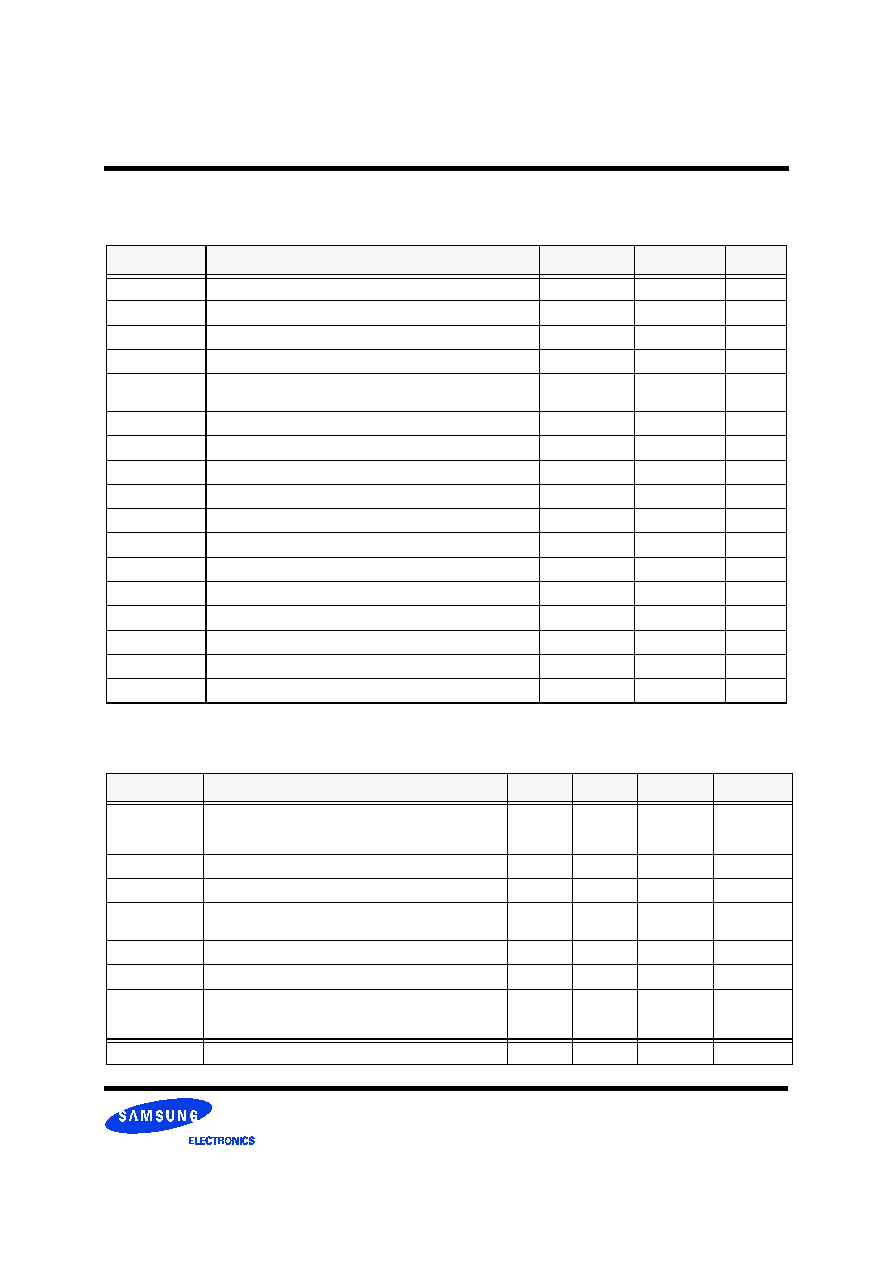
Page 44
Direct RDRAM
TM
K4R881869M
Rev. 0.9 Jan. 2000
Preliminary
Electrical Conditions
Timing Conditions
Table 18: Electrical Conditions
Symbol
Parameter and Conditions
Min
Max
Unit
T
J
Junction temperature under bias
-
100
∞
C
V
DD,
V
DDA
Supply voltage
2.50 - 0.13
2.50 + 0.13
V
V
DD,N,
V
DDA,N
Supply voltage droop (DC) during NAP interval (t
NLIMIT
)
-
2.0
%
v
DD,N,
v
DDA,N
Supply voltage ripple (AC) during NAP interval (t
NLIMIT
)
-2.0
2.0
%
V
CMOS
Supply voltage for CMOS pins (2.5V controllers)
Supply voltage for CMOS pins (1.8V controllers)
2.50 - 0.13
1.80 - 0.1
2.50 + 0.25
1.80 + 0.2
V
V
V
TERM
Termination voltage
1.80 - 0.1
1.80 + 0.1
V
V
REF
Reference voltage
1.40 - 0.2
1.40 + 0.2
V
V
DIL
RSL data input - low voltage
V
REF
- 0.5
V
REF
- 0.2
V
V
DIH
RSL data input - high voltage
V
REF
+ 0.2
V
REF
+ 0.5
V
V
DIS
RSL data input swing: V
DIS
= V
DIH
- V
DIL
0.4
1.0
V
A
DI
RSL data asymmetry: A
DI
= [(V
DIH
- V
REF
) + (V
DIL
- V
REF
)]/V
DIS
0
-20
%
V
X
RSL clock input - crossing point of true and complement signals
1.3
1.8
V
V
CM
RSL clock input - common mode V
CM
= (V
CIH
+V
CIL)
/2
1.4
1.7
V
V
CIS,CTM
RSL clock input swing: V
CIS
= V
CIH
- V
CIL
(CTM,CTMN pins).
0.35
0.70
V
V
CIS,CFM
RSL clock input swing: V
CIS
= V
CIH
- V
CIL
(CFM,CFMN pins).
0.125
0.70
V
V
IL,CMOS
CMOS input low voltage
- 0.3
V
CMOS
/2 - 0.25
V
V
IH,CMOS
CMOS input high voltage
V
CMOS
/2 + 0.25
V
CMOS
+0.3
V
Table 19: Timing Conditions
Symbol
Parameter
Min
Max
Unit
Figure(s)
t
CYCLE
CTM and CFM cycle times (-600)
CTM and CFM cycle times (-711)
CTM and CFM cycle times (-800)
3.33
2.80
2.50
3.83
3.83
3.83
ns
ns
ns
Figure 53
Figure 53
Figure 53
t
CR
, t
CF
CTM and CFM input rise and fall times
0.2
0.5
ns
Figure 53
t
CH
, t
CL
CTM and CFM high and low times
40%
60%
t
CYCLE
Figure 53
t
TR
CTM-CFM differential (MSE/MS=0/0)
CTM-CFM differential (MSE/MS=1/1)
a
0.0
0.9
1.0
1.0
t
CYCLE
Figure 42
Figure 53
t
DCW
Domain crossing window
-0.1
0.1
t
CYCLE
Figure 59
t
DR
, t
DF
DQA/DQB/ROW/COL input rise/fall times
0.2
0.65
ns
Figure 54
t
S
, t
H
DQA/DQB/ROW/COL-to-CFM set/hold @ t
CYCLE
=3.33ns
DQA/DQB/ROW/COL-to-CFM set/hold @ t
CYCLE
=2.81ns
DQA/DQB/ROW/COL-to-CFM set/hold @ t
CYCLE
=2.50ns
0.275
b,d
0.240
c,d
0.200
d
-
-
-
ns
ns
ns
Figure 54
Figure 54
Figure 54
t
DR1,
t
DF1
SIO0, SIO1 input rise and fall times
-
5.0
ns
Figure 56

Page 45
Direct RDRAM
TM
K4R881869M
Rev. 0.9 Jan. 2000
Preliminary
t
DR2,
t
DF2
CMD, SCK input rise and fall times
-
2.0
ns
Figure 56
t
CYCLE1
SCK cycle time - Serial control register transactions
1000
-
ns
Figure 56
SCK cycle time - Power transitions
10
-
ns
Figure 56
t
CH1
, t
CL1
SCK high and low times
4.25
-
ns
Figure 56
t
S1
CMD setup time to SCK rising or falling edge
e
1.25
-
ns
Figure 56
t
H1
CMD hold time to SCK rising or falling edge
e
1
-
ns
Figure 56
t
S2
SIO0 setup time to SCK falling edge
40
-
ns
Figure 56
t
H2
SIO0 hold time to SCK falling edge
40
-
ns
Figure 56
t
S3
PDEV setup time on DQA5..0 to SCK rising edge.
0
-
ns
Figure 48,
Figure 57
t
H3
PDEV hold time on DQA5..0 to SCK rising edge.
5.5
-
ns
t
S4
ROW2..0, COL4..0 setup time for quiet window
-1
-
t
CYCLE
Figure 48
t
H4
ROW2..0, COL4..0 hold time for quiet window
f
5
-
t
CYCLE
Figure 48
v
IL,CMOS
CMOS input low voltage - over/undershoot voltage duration is less
than or equal to 5ns
- 0.7
V
CMOS
/2 -
0.4
V
v
IH,CMOS
CMOS input high voltage - over/undershoot voltage duration is
less than or equal to 5ns
V
CMOS
/2
+ 0.4
V
CMOS
+
0.7
V
t
NPQ
Quiet on ROW/COL bits during NAP/PDN entry
4
-
t
CYCLE
Figure 47
t
READTOCC
Offset between read data and CC packets (same device)
12
-
t
CYCLE
Figure 51
t
CCSAMTOREAD
Offset between CC packet and read data (same device)
8
-
t
CYCLE
Figure 51
t
CE
CTM/CFM stable before NAP/PDN exit
2
-
t
CYCLE
Figure 48
t
CD
CTM/CFM stable after NAP/PDN entry
100
-
t
CYCLE
Figure 47
t
FRM
ROW packet to COL packet ATTN framing delay
7
-
t
CYCLE
Figure 46
t
NLIMIT
Maximum time in NAP mode
10.0
µ
s
Figure 45
t
REF
Refresh interval
32
ms
Figure 50
t
CCTRL
Current control interval
34 t
CYCLE
100ms
ms/t
CYCLE
Figure 51
t
TEMP
Temperature control interval
100
ms
Figure 52
t
TCEN
TCE command to TCAL command
150
-
t
CYCLE
Figure 52
t
TCAL
TCAL command to quiet window
2
2
t
CYCLE
Figure 52
t
TCQUIET
Quiet window (no read data)
140
-
t
CYCLE
Figure 52
t
PAUSE
RDRAM delay (no RSL operations allowed)
200.0
µ
s
page 28
a. MSE/MS are fields of the SKIP register. For this combination (skip override) the tDCW parameter range is effectively 0.0 to 0.0.
b. This parameter also applies to a -800 or -711 part when operated with t
CYCLE
=3.33ns.
c. This parameter also applies to a -800 part when operated with t
CYCLE
=2.81ns.
d. t
S,MIN
and t
H,MIN
for other t
CYCLE
values can be interpolated between or extrapolated from the timings at the 3 specified t
CYCLE
values.
e. With V
IL,CMOS
=0.5V
CMOS
-0.4V and V
IH,CMOS
=0.5V
CMOS
+0.4V
f. Effective hold becomes t
H4
'=t
H4
+[PDNXA∑64∑t
SCYCLE
+t
PDNXB,MAX
]-[PDNX∑256∑t
SCYCLE
]
if [PDNX∑256∑t
SCYCLE
] < [PDNXA∑64∑t
SCYCLE
+t
PDNXB,MAX
]. See Figure 48.
Table 19: Timing Conditions
Symbol
Parameter
Min
Max
Unit
Figure(s)

Page 46
Direct RDRAM
TM
K4R881869M
Rev. 0.9 Jan. 2000
Preliminary
Electrical Characteristics
Timing Characteristics
Table 20: Electrical Characteristics
Symbol
Parameter and Conditions
Min
Max
Unit
JC
Junction-to-Case thermal resistance
-
0.2
∞
C/Watt
I
REF
V
REF
current @ V
REF,MAX
-10
10
µ
A
I
OH
RSL output high current @ (0
V
OUT
V
DD
)
-10
10
µ
A
I
ALL
RSL I
OL
current @ V
OL
= 0.9V, V
DD,MIN
, T
J,MAX
a
30.0
90.0
mA
I
OL
RSL I
OL
current resolution step
-
2.0
mA
r
OUT
Dynamic output impedance
150
-
I
I,CMOS
CMOS input leakage current @ (0
V
I,CMOS
V
CMOS
)
-10.0
10.0
µ
A
V
OL,CMOS
CMOS output voltage @ I
OL,CMOS
= 1.0mA
-
0.3
V
V
OH,CMOS
CMOS output high voltage @ I
OH,CMOS
= -0.25mA
V
CMOS
-0.3
-
V
a. This measurement is made in manual current control mode; i.e. with all output device legs sinking current.
Table 21: Timing Characteristics
Symbol
Parameter
Min
Max
Unit
Figure(s)
t
Q
CTM-to-DQA/DQB output time @ t
CYCLE
=3.33ns
CTM-to-DQA/DQB output time @ t
CYCLE
=2.81ns
CTM-to-DQA/DQB output time @ t
CYCLE
=2.50ns
-0.350
a,c
-0.300
b,c
-0.260
c
+0.350
a,c
+0.300
b,c
+0.260
c
ns
ns
ns
Figure 55
Figure 55
Figure 55
t
QR
, t
QF
DQA/DQB output rise and fall times
0.2
0.45
ns
Figure 55
t
Q1
SCK(neg)-to-SIO0 delay @ C
LOAD,MAX
= 20pF (SD read data valid).
-
10
ns
Figure 58
t
QR1
, t
QF1
SIO
OUT
rise/fall @ C
LOAD,MAX
= 20pF
-
5
ns
Figure 58
t
PROP1
SIO0-to-SIO1 or SIO1-to-SIO0 delay @ C
LOAD,MAX
= 20pF
-
10
ns
Figure 58
t
NAPXA
NAP exit delay - phase A
-
50
ns
Figure 48
t
NAPXB
NAP exit delay - phase B
-
40
ns
Figure 48
t
PDNXA
PDN exit delay - phase A
-
4
µ
s
Figure 48
t
PDNXB
PDN exit delay - phase B
-
9000
t
CYCLE
Figure 48
t
AS
ATTN-to-STBY power state delay
-
1
t
CYCLE
Figure 46
t
SA
STBY-to-ATTN power state delay
-
0
t
CYCLE
Figure 46
t
ASN
ATTN/STBY-to-NAP power state delay
-
8
t
CYCLE
Figure 47
t
ASP
ATTN/STBY-to-PDN power state delay
-
8
t
CYCLE
Figure 47
a. This parameter also applies to a -800 or -711 part when operated with t
CYCLE
=3.33ns.
b. This parameter also applies to a -800 part when operated with t
CYCLE
=2.81ns.
c. t
Q,MIN
and t
Q,MAX
for other t
CYCLE
values can be interpolated between or extrapolated from the timings at the 3 specified t
CYCLE
values.
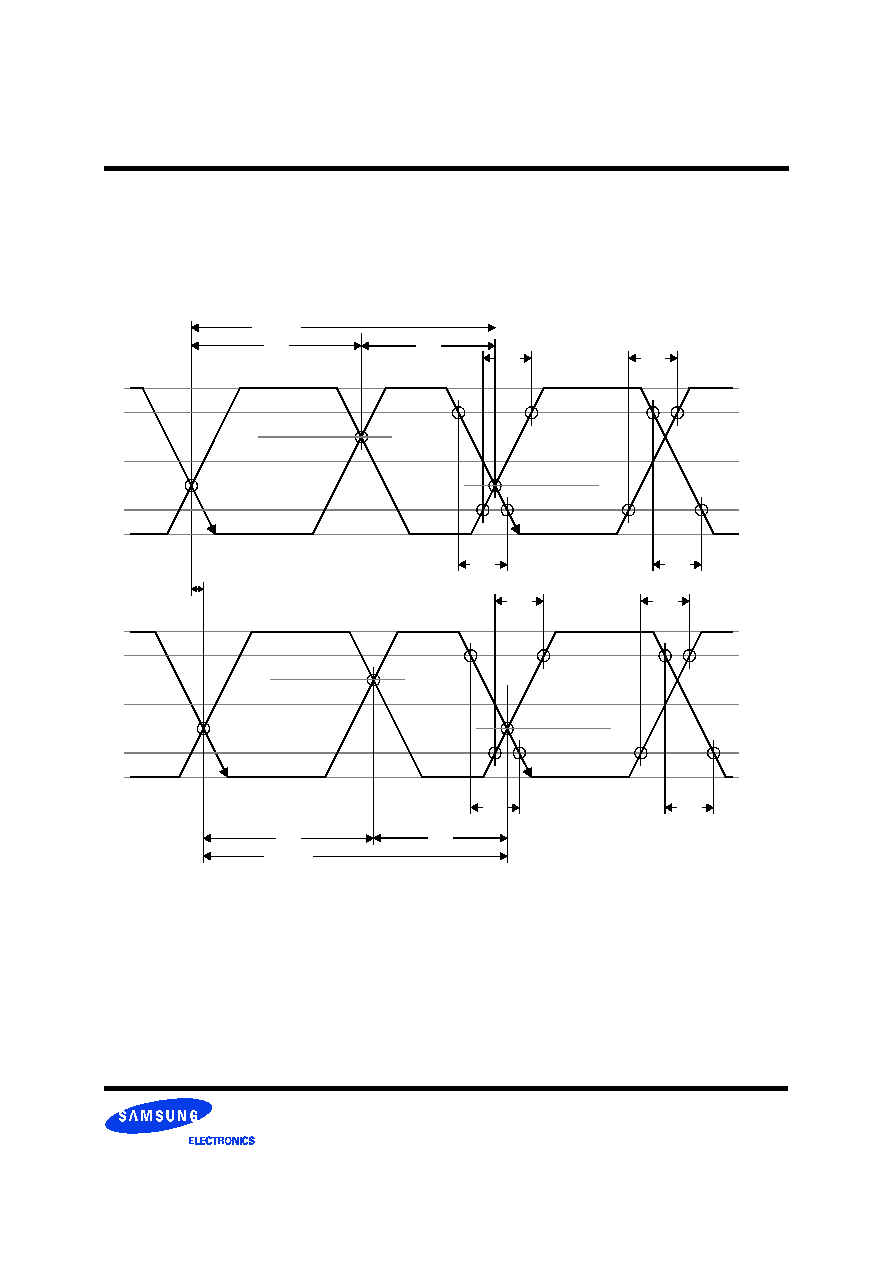
Page 47
Direct RDRAM
TM
K4R881869M
Rev. 0.9 Jan. 2000
Preliminary
RSL - Clocking
Figure 53 is a timing diagram which shows the detailed
requirements for the RSL clock signals on the Channel.
The CTM and CTMN are differential clock inputs used for
transmitting information on the DQA and DQB, outputs.
Most timing is measured relative to the points where they
cross. The t
CYCLE
parameter is measured from the falling
CTM edge to the falling CTM edge. The t
CL
and t
CH
param-
eters are measured from falling to rising and rising to falling
edges of CTM. The t
CR
and t
CF
rise- and fall-time parame-
ters are measured at the 20% and 80% points.
The CFM and CFMN are differential clock outputs used for
receiving information on the DQA, DQB, ROW and COL
outputs. Most timing is measured relative to the points
where they cross. The t
CYCLE
parameter is measured from
the falling CFM edge to the falling CFM edge. The t
CL
and
t
CH
parameters are measured from falling to rising and rising
to falling edges of CFM. The t
CR
and t
CF
rise- and fall-time
parameters are measured at the 20% and 80% points.
The t
TR
parameter specifies the phase difference that may be
tolerated with respect to the CTM and CFM differential
clock inputs (the CTM pair is always earlier).
Figure 53: RSL Timing - Clock Signals
V
CIH
50%
V
CIL
80%
20%
CTM
CTMN
V
CIH
50%
V
CIL
80%
20%
CFM
CFMN
t
TR
t
CF
t
CF
t
CR
t
CR
t
CYCLE
t
CL
t
CH
t
CF
t
CF
t
CR
t
CR
t
CYCLE
t
CL
t
CH
V
CM
V
X+
V
X-
V
CM
V
X+
V
X-
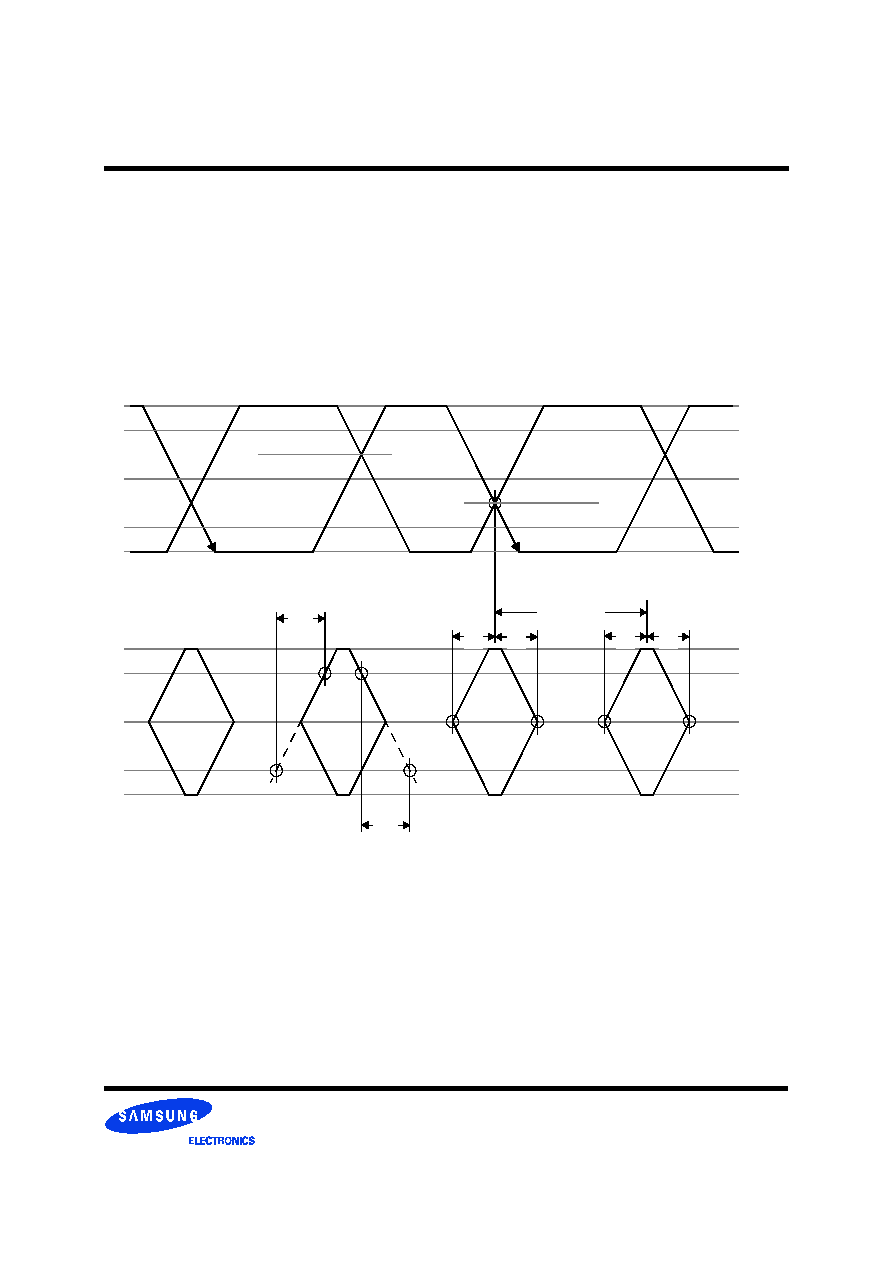
Page 48
Direct RDRAM
TM
K4R881869M
Rev. 0.9 Jan. 2000
Preliminary
RSL - Receive Timing
Figure 54 is a timing diagram which shows the detailed
requirements for the RSL input signals on the Channel.
The DQA, DQB, ROW, and COL signals are inputs which
receive information transmitted by a Direct RAC on the
Channel. Each signal is sampled twice per t
CYCLE
interval.
The set/hold window of the sample points is t
S
/t
H.
The
sample points are centered at the 0% and 50% points of a
cycle, measured relative to the crossing points of the falling
CFM clock edge. The set and hold parameters are measured
at the V
REF
voltage point of the input transition.
The t
DR
and t
DF
rise- and fall-time parameters are measured
at the 20% and 80% points of the input transition.
Figure 54: RSL Timing - Data Signals for Receive
V
DIH
V
REF
V
DIL
80%
20%
V
CIH
50%
V
CIL
80%
20%
CFM
CFMN
DQA
t
S
ROW
DQB
t
DF
t
DR
t
H
t
S
t
H
0.5∑t
CYCLE
even
odd
COL
V
CM
V
X+
V
X-
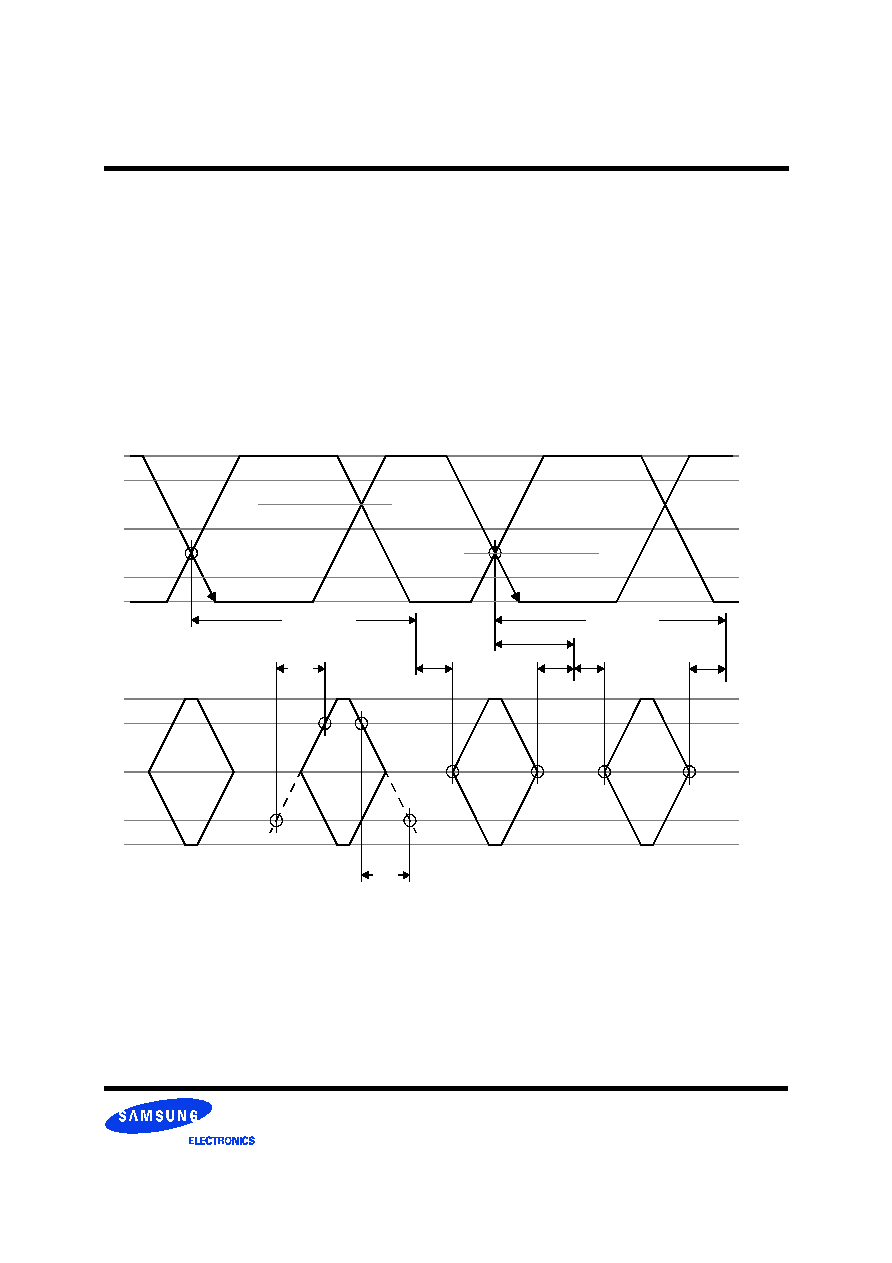
Page 49
Direct RDRAM
TM
K4R881869M
Rev. 0.9 Jan. 2000
Preliminary
RSL - Transmit Timing
Figure 55 is a timing diagram which shows the detailed
requirements for the RSL output signals on the Channel.
The DQA and DQB signals are outputs to transmit informa-
tion that is received by a Direct RAC on the Channel. Each
signal is driven twice per t
CYCLE
interval. The beginning
and end of the even transmit window is at the 75% point of
the previous cycle and at the 25% point of the current cycle.
The beginning and end of the odd transmit window is at the
25% point and at the 75% point of the current cycle. These
transmit points are measured relative to the crossing points
of the falling CTM clock edge. The size of the actual
transmit window is less than the ideal t
CYCLE
/2, as indicated
by the non-zero values of t
Q,MIN
and t
Q,MAX
. The t
Q
param-
eters are measured at the 50% voltage point of the output
transition.
The t
QR
and t
QF
rise- and fall-time parameters are measured
at the 20% and 80% points of the output transition.
Figure 55: RSL Timing - Data Signals for Transmit
t
Q,MIN
t
Q,MAX
t
Q,MAX
t
Q,MIN
0.25∑t
CYCLE
V
QH
50%
V
QL
80%
20%
V
CIH
50%
V
CIL
80%
20%
CTM
CTMN
t
QF
t
QR
even
odd
0.75∑t
CYCLE
0.75∑t
CYCLE
DQA
DQB
V
CM
V
X+
V
X-
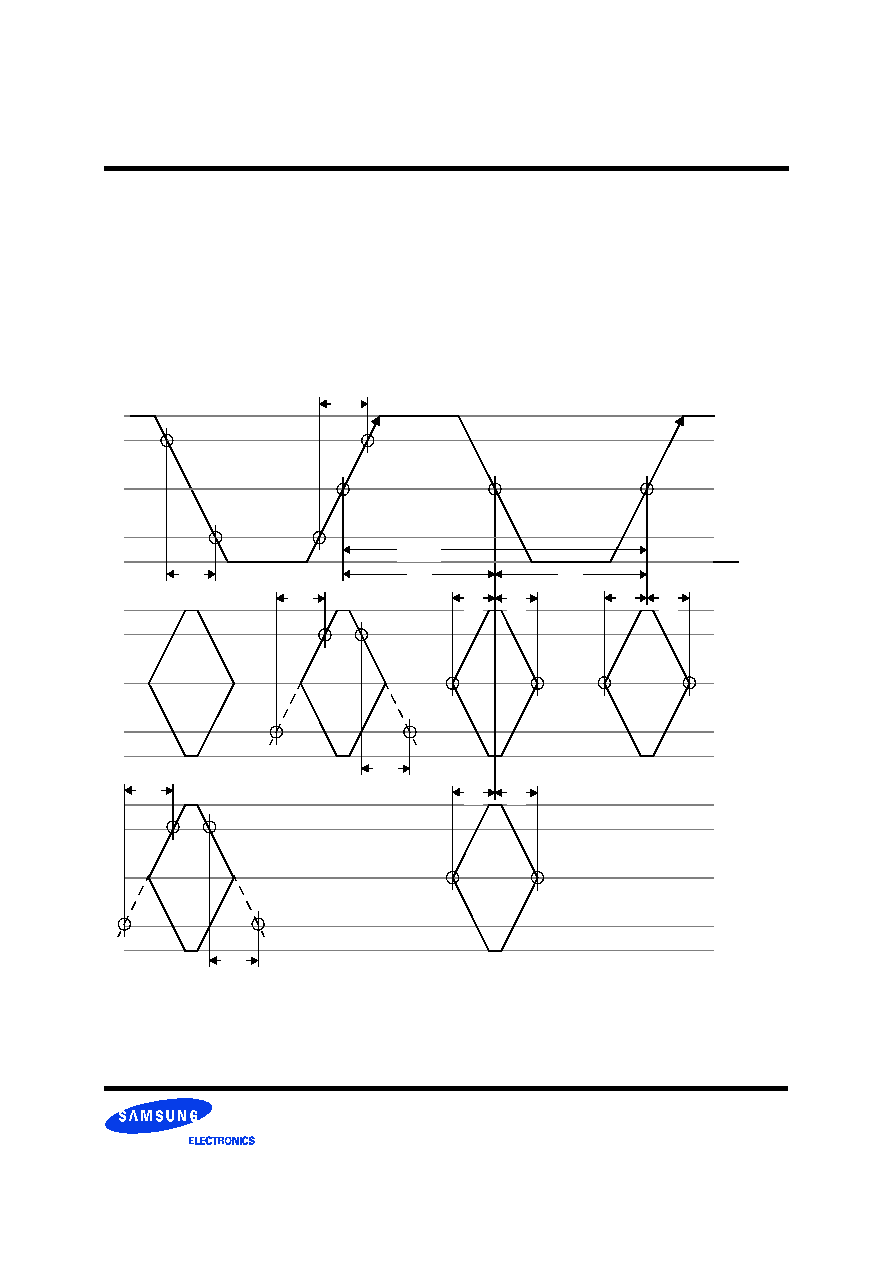
Page 50
Direct RDRAM
TM
K4R881869M
Rev. 0.9 Jan. 2000
Preliminary
CMOS - Receive Timing
Figure 56 is a timing diagram which shows the detailed
requirements for the CMOS input signals .
The CMD and SIO0 signals are inputs which receive infor-
mation transmitted by a controller (or by another RDRAM's
SIO1 output. SCK is the CMOS clock signal driven by the
controller. All signals are high true.
The cycle time, high phase time, and low phase time of the
SCK clock are t
CYCLE1
, t
CH1
and t
CL1
, all measured at the
50% level. The rise and fall times of SCK, CMD, and SIO0
are t
DR1
and t
DF1
, measured at the 20% and 80% levels.
The CMD signal is sampled twice per t
CYCLE1
interval, on
the rising edge (odd data) and the falling edge (even data).
The set/hold window of the sample points is t
S1
/t
H1.
The
SCK and CMD timing points are measured at the 50% level.
The SIO0 signal is sampled once per t
CYCLE1
interval on the
falling edge. The set/hold window of the sample points is
t
S2
/t
H2.
The SCK and SIO0 timing points are measured at the
50% level.
Figure 56: CMOS Timing - Data Signals for Receive
V
IH,CMOS
50%
V
IL,CMOS
80%
20%
SCK
t
S1
CMD
t
DR2
t
H1
t
S1
t
H1
even
odd
t
DF2
V
IH,CMOS
50%
V
IL,CMOS
80%
20%
t
DR2
t
DF2
t
CH1
t
CL1
t
CYCLE1
t
S2
SIO0
t
DR1
t
H2
t
DF1
V
IH,CMOS
50%
V
IL,CMOS
80%
20%
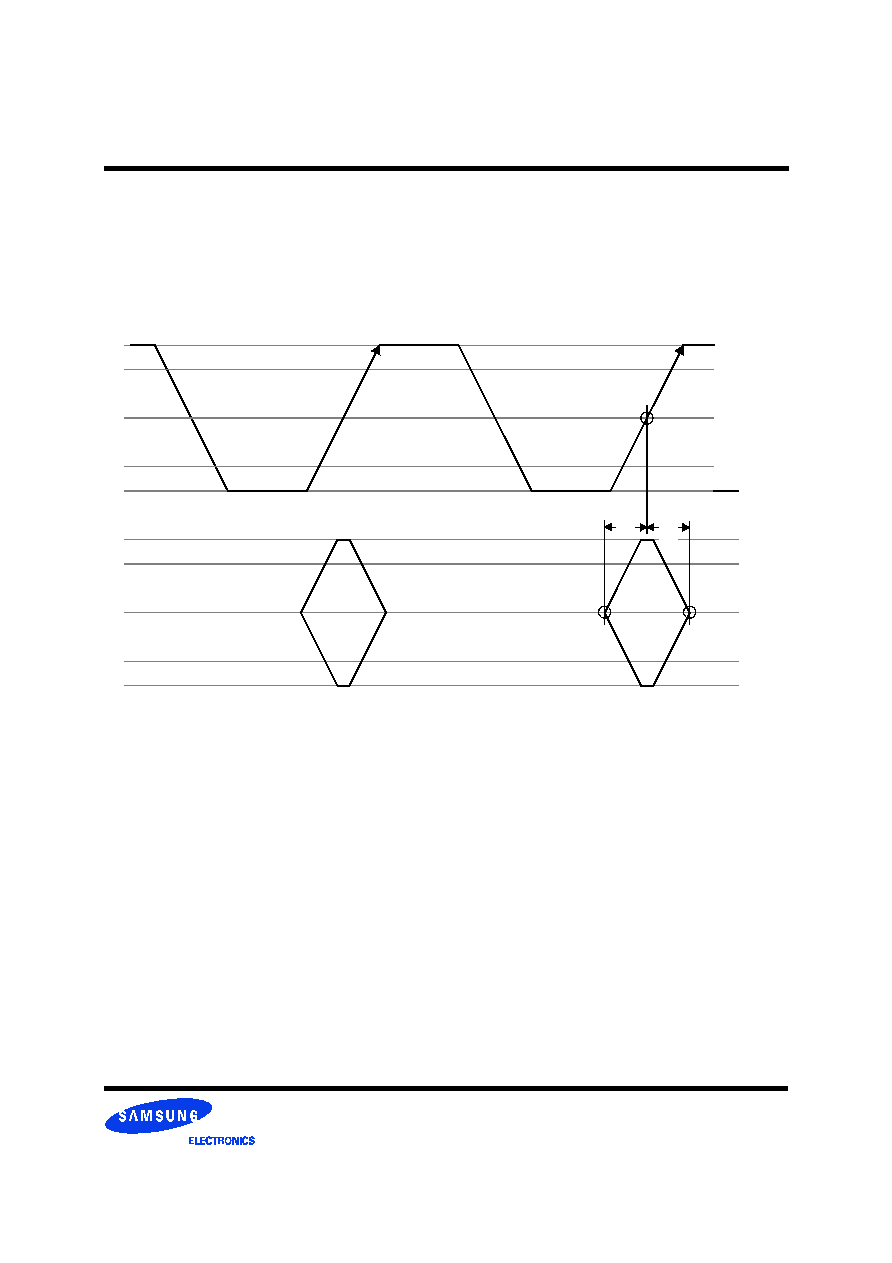
Page 51
Direct RDRAM
TM
K4R881869M
Rev. 0.9 Jan. 2000
Preliminary
The SCK clock is also used for sampling data on RSL inputs
in one situation. Figure 48 shows the PDN and NAP exit
sequences. If the PSX field of the INIT register is one (see
Figure 27), then the PDN and NAP exit sequences are broad-
cast; i.e. all RDRAMs that are in PDN or NAP will perform
the exit sequence. If the PSX field of the INIT register is
zero, then the PDN and NAP exit sequences are directed; i.e.
only one RDRAM that is in PDN or NAP will perform the
exit sequence.
The address of that RDRAM is specified on the DQA[5:0]
bus in the set hold window t
S3
/t
H3
around the rising edge of
SCK. This is shown in Figure 57. The SCK timing point is
measured at the 50% level, and the DQA[5:0] bus signals are
measured at the V
REF
level.
Figure 57: CMOS Timing - Device Address for NAP or PDN Exit
V
IH,CMOS
50%
V
IL,CMOS
80%
20%
SCK
V
DIH
V
REF
V
DIL
80%
20%
DQA[5:0]
t
S3
t
H3
PDEV
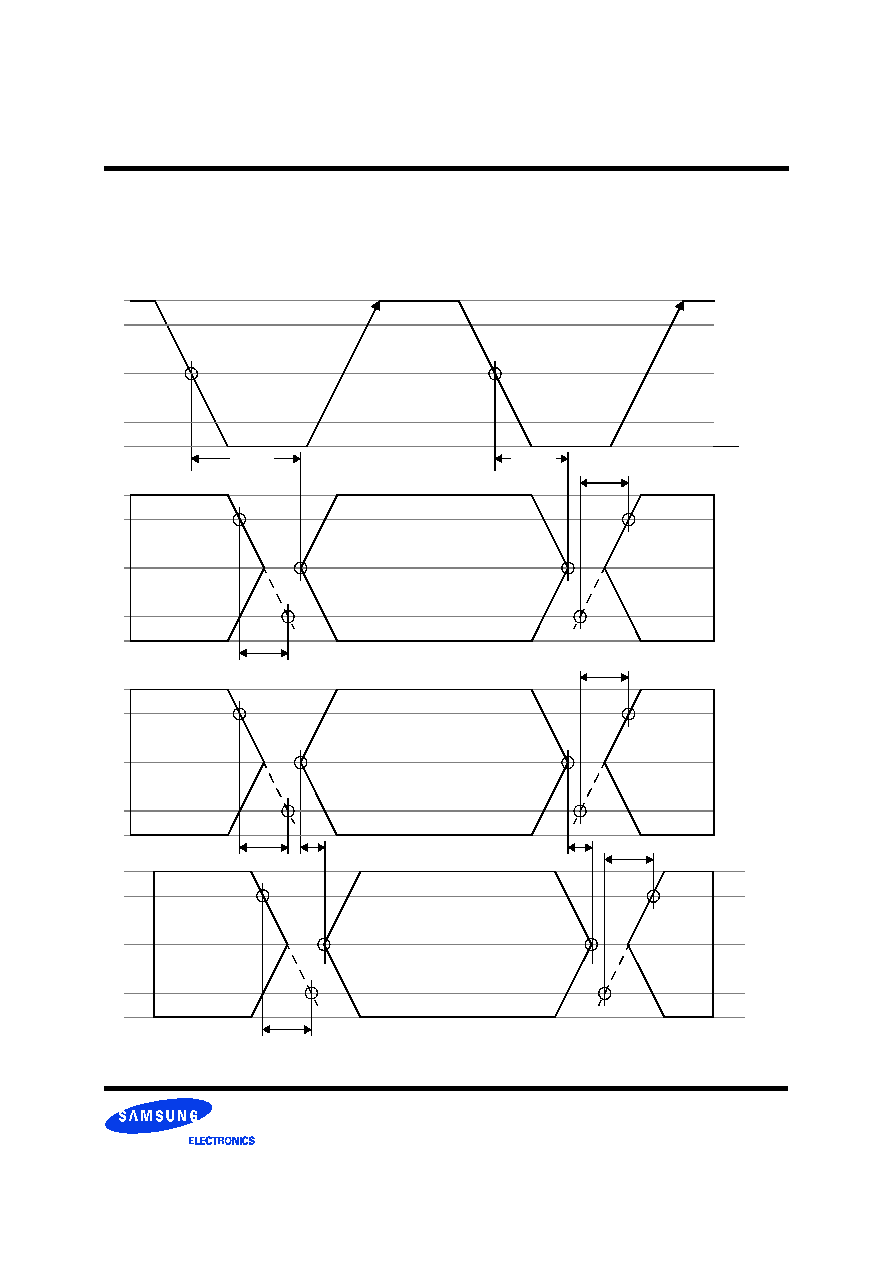
Page 52
Direct RDRAM
TM
K4R881869M
Rev. 0.9 Jan. 2000
Preliminary
CMOS - Transmit Timing
Figure 58 is a timing diagram which shows the detailed
requirements for the CMOS output signals. The SIO0 signal
is driven once per t
CYCLE1
interval on the falling edge. The
clock-to-output window is t
Q1,MIN
/t
Q1,MAX.
The SCK and
SIO0 timing points are measured at the 50% level. The rise
and fall times of SIO0 are t
QR1
and t
QF1
, measured at the
20% and 80% levels.
Figure 58: CMOS Timing - Data Signals for Transmit
V
IH,CMOS
50%
V
IL,CMOS
80%
20%
SCK
SIO0
t
QR1
t
QF1
V
OH,CMOS
50%
V
OL,CMOS
80%
20%
t
Q1,MAX
V
IH,CMOS
50%
V
IL,CMOS
80%
20%
t
Q1,MIN
V
OH,CMOS
50%
V
OL,CMOS
80%
20%
SIO0
t
DR1
t
DF1
t
QR1
t
QF1
t
PROP1,MAX
t
PROP1,MIN
or
SIO1
SIO1
or
SIO0

Page 53
Direct RDRAM
TM
K4R881869M
Rev. 0.9 Jan. 2000
Preliminary
Figure 58 also shows the combinational path connecting
SIO0 to SIO1 and the path connecting SIO1 to SIO0 (read
data only). The t
PROP1
parameter specified this propagation
delay. The rise and fall times of SIO0 and SIO1 inputs must
be t
DR1
and t
DF1
, measured at the 20% and 80% levels. The
rise and fall times of SIO0 and SIO1 outputs are t
QR1
and
t
QF1
, measured at the 20% and 80% levels.
RSL - Domain Crossing Window
When read data is returned by the RDRAM, imformation
must cross from the receive clock domain (CFM) to the
transmit clock domain (CTM). The t
TR
parameter permits
the CFM to CTM phase to vary through an entire cycle; i.e.
there is no restriction on the alignment of these two clocks.
A second parameter t
DCW
is needed in order to describe how
the delay between a RD command packet and read data
packet varies as a function of the t
TR
value.
Figure 59 shows this timing for five distinct values of t
TR
.
Case A (t
TR
=0) is what has been used throughout this docu-
ment. The delay between the RD command and read data is
t
CAC
. As t
TR
varies from zero to t
CYCLE
(cases A through
E), the command to data delay is (t
CAC
-t
TR
). When the t
TR
value is in the range 0 to t
DCW,MAX
, the command to data
delay can also be (t
CAC
-t
TR
-t
CYCLE
). This is shown as cases
A' and B' (the gray packets). Similarly, when the t
TR
value
is in the range (t
CYCLE
+t
DCW,MIN
) to t
CYCLE
, the command
to data delay can also be (t
CAC
-t
TR
+t
CYCLE
). This is shown
as cases D' and E' (the gray packets). The RDRAM will
work reliably with either the white or gray packet timing.
The delay value is selected at initialization, and remains
fixed thereafter.
Figure 59: RSL Transmit - Crossing Read Domains
CFM
COL
t
TR
CTM
DQA/B
DQA/B
t
TR
=0
t
CYCLE
Case A
t
TR
=0
Case A'
t
TR
CTM
DQA/B
DQA/B
t
TR
=t
DCW,MAX
Case B
t
TR
=t
DCW,MAX
Case B'
t
TR
CTM
DQA/B
t
TR
=0.5∑t
CYCLE
Case C
CTM
DQA/B
DQA/B
t
TR
=t
CYCLE
+t
DCW,MIN
Case D
t
TR
=t
CYCLE
+t
DCW,MIN
Case D'
CTM
DQA/B
DQA/B
t
TR
=t
CYCLE
Case E
t
TR
=t
CYCLE
Case E'
t
TR
t
TR
RD a1
Q(a1)
Q(a1)
Q(a1)
Q(a1)
t
CAC
-t
TR
t
CAC
-t
TR
-t
CYCLE
Q(a1)
Q(a1)
Q(a1)
Q(a1)
Q(a1)
t
CAC
-t
TR
t
CAC
-t
TR
+t
CYCLE
t
CAC
-t
TR
t
CAC
-t
TR
+t
CYCLE
t
CAC
-t
TR
t
CAC
-t
TR
-t
CYCLE
t
CAC
-t
TR
∑∑∑
∑∑∑
∑∑∑
∑∑∑
∑∑∑
∑∑∑

Page 54
Direct RDRAM
TM
K4R881869M
Rev. 0.9 Jan. 2000
Preliminary
Timing Parameters
Table 22: Timing Parameter Summary
Parameter
Description
Min
-45
-800
Min
-45
-711
Min
-53
-600
Max
Units
Figure(s)
t
RC
Row Cycle time of RDRAM banks -the interval between ROWA packets
with ACT commands to the same bank.
28
28
28
-
t
CYCLE
Figure 15
Figure 16
t
RAS
RAS-asserted time of RDRAM bank - the interval between ROWA packet
with ACT command and next ROWR packet with PRER
a
command to the
same bank.
20
20
20
64
µ
s
b
t
CYCLE
Figure 15
Figure 16
t
RP
Row Precharge time of RDRAM banks - the interval between ROWR packet
with PRER
a
command and next ROWA packet with ACT command to the
same bank.
8
8
8
-
t
CYCLE
Figure 15
Figure 16
t
PP
Precharge-to-precharge time of RDRAM device - the interval between suc-
cessive ROWR packets with PRER
a
commands to any banks of the same
device.
8
8
8
-
t
CYCLE
Figure 12
t
RR
RAS-to-RAS time of RDRAM device - the interval between successive
ROWA packets with ACT commands to any banks of the same device.
8
8
8
-
t
CYCLE
Figure 13
t
RCD
RAS-to-CAS Delay - the interval from ROWA packet with ACT command
to COLC packet with RD or WR command). Note - the RAS-to-CAS delay
seen by the RDRAM core (t
RCD-C
) is equal to t
RCD-C
= 1 + t
RCD
because of
differences in the row and column paths through the RDRAM interface.
9
7
7
-
t
CYCLE
Figure 15
Figure 16
t
CAC
CAS Access delay - the interval from RD command to Q read data. The
equation for t
CAC
is given in the TPARM register in Figure 39.
8
8
8
12
t
CYCLE
Figure 4
Figure 39
t
CWD
CAS Write Delay (interval from WR command to D write data.
6
6
6
6
t
CYCLE
Figure 4
t
CC
CAS-to-CAS time of RDRAM bank - the interval between successive COLC
commands).
4
4
4
-
t
CYCLE
Figure 15
Figure 16
t
PACKET
Length of ROWA, ROWR, COLC, COLM or COLX packet.
4
4
4
4
t
CYCLE
Figure 3
t
RTR
Interval from COLC packet with WR command to COLC packet which
causes retire, and to COLM packet with bytemask.
8
8
8
-
t
CYCLE
Figure 17
t
OFFP
The interval (offset) from COLC packet with RDA command, or from
COLC packet with retire command (after WRA automatic precharge), or
from COLC packet with PREC command, or from COLX packet with PREX
command to the equivalent ROWR packet with PRER. The equation for
t
OFFP
is given in the TPARM register in Figure 39.
4
4
4
4
t
CYCLE
Figure 14
Figure 39
t
RDP
Interval from last COLC packet with RD command to ROWR packet with
PRER.
4
4
4
-
t
CYCLE
Figure 15
t
RTP
Interval from last COLC packet with automatic retire command to ROWR
packet with PRER.
4
4
4
-
t
CYCLE
Figure 16
a. Or equivalent PREC or PREX command. See Figure 14.
b. This is a constraint imposed by the core, and is therefore in units of
µ
s rather than t
CYCLE
.
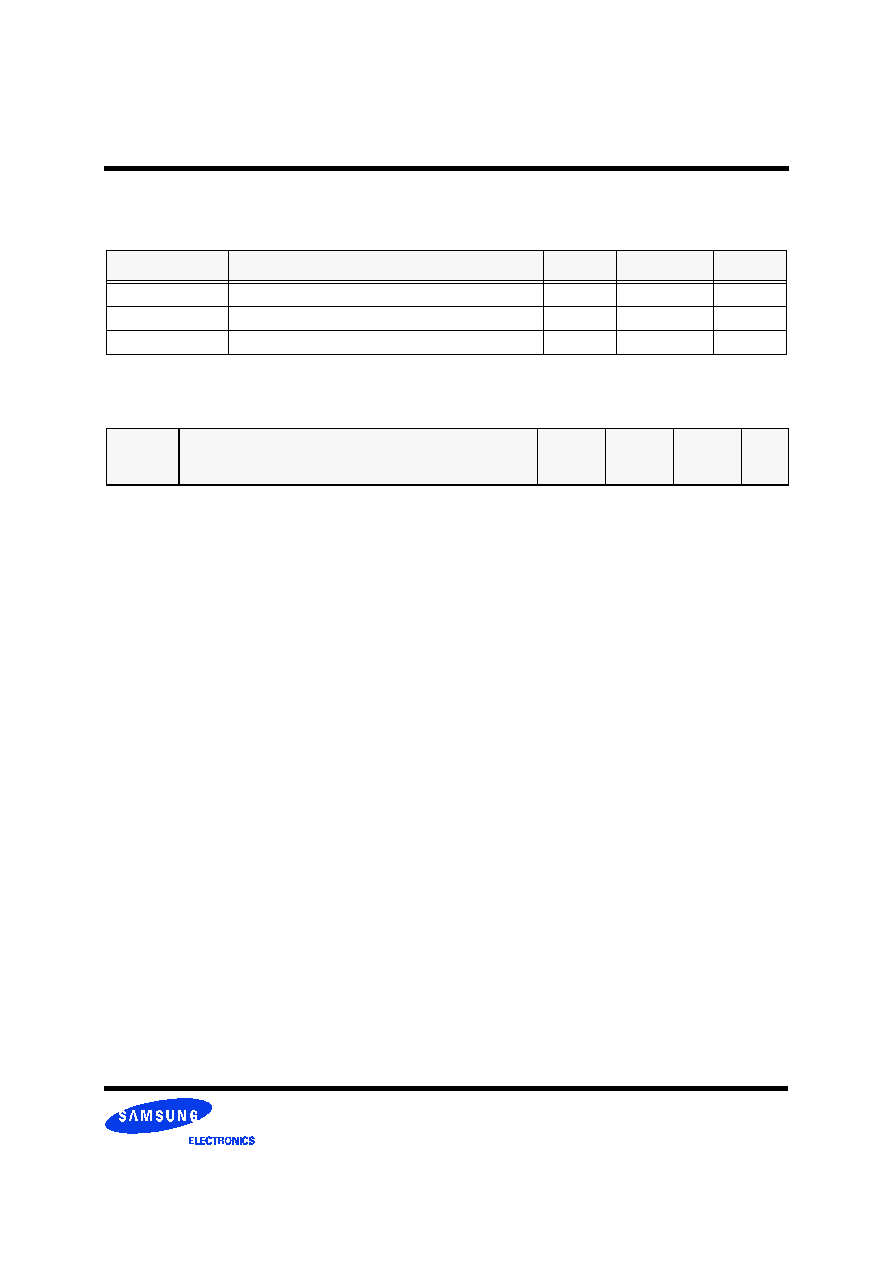
Page 55
Direct RDRAM
TM
K4R881869M
Rev. 0.9 Jan. 2000
Preliminary
Absolute Maximum Ratings
I
DD
- Supply Current Profile
Table 23: Absolute Maximum Ratings
Symbol
Parameter
Min
Max
Unit
V
I,ABS
Voltage applied to any RSL or CMOS pin with respect to Gnd
- 0.3
V
DD
+0.3
V
V
DD,ABS
, V
DDA,ABS
Voltage on VDD and VDDA with respect to Gnd
- 0.5
V
DD
+1.0
V
T
STORE
Storage temperature
- 50
100
∞
C
Table 24: Supply Current Profile
I
DD
value
RDRAM blocks consuming power
a
Max
-45
-800
Max
-45
-711
Max
-53.3
-600
Unit
I
DD,PDN
Self-refresh only for INIT.LSR=0
TBD
TBD
TBD
µ
A
I
DD,NAP
T/RCLK-Nap
TBD
TBD
TBD
mA
I
DD,STBY
T/RCLK, ROW-demux
TBD
TBD
TBD
mA
I
DD,ATTN
T/RCLK, ROW-demux, COL-demux
TBD
TBD
TBD
mA
I
DD,ATTN-W
T/RCLK, ROW-demux,COL-demux,DQ-demux,1
∑
WR-SenseAmp, 4
∑
ACT-
Bank
TBD
TBD
TBD
mA
I
DD,ATTN-R
T/RCLK, ROW-demux,COL-demux,DQ-mux,1
∑
RD-SenseAmp, 4
∑
ACT-
Bank
b
TBD
TBD
TBD
mA
a. The CMOS interface consumes power in all power states.
b. This does not include the IOL sink current. The RDRAM dissipates IOL
∑
VOL in each output driver when a logic one is driven.
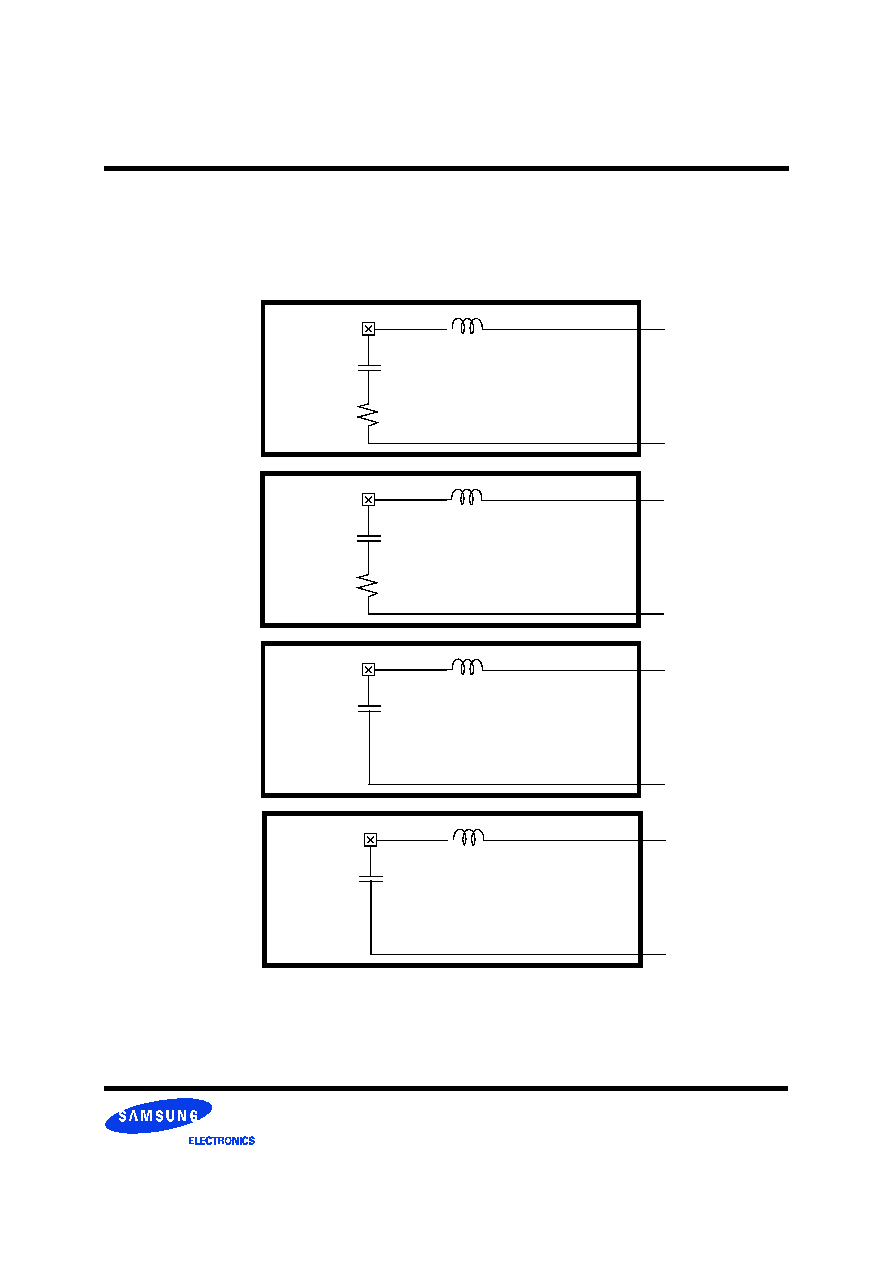
Page 56
Direct RDRAM
TM
K4R881869M
Rev. 0.9 Jan. 2000
Preliminary
Capacitance and Inductance
Figure 60 shows the equivalent load circuit of the RSL and
CMOS pins. The circuit models the load that the device
presents to the Channel.
Figure 60: Equivalent Load Circuit for RSL Pins
Gnd Pin
CTM,CTMN,
Pad
L
I
R
I
C
I
Gnd Pin
SCK,CMD Pin
Pad
L
I,CMOS
C
I,CMOS
Gnd Pin
SIO0,SIO1 Pin
Pad
L
I,CMOS
C
I,CMOS,SIO
Gnd Pin
DQA,DQB,RQ Pin
Pad
L
I
R
I
C
I
CFM,CFMN Pin

Page 57
Direct RDRAM
TM
K4R881869M
Rev. 0.9 Jan. 2000
Preliminary
This circuit does not include pin coupling effects that are
often present in the packaged device. Because coupling
effects make the effective single-pin inductance L
I
, and
capacitance C
I
, a function of neighboring pins, these param-
eters are intrinsically data-dependent. For purposes of speci-
fying the device electrical loading on the Channel, the
effective L
I
and C
I
are defined as the worst-case values over
all specified operating conditions.
L
I
is defined as the effective pin inductance based on the
device pin assignment. Because the pad assignment places
each RSL signal adjacent to an AC ground (a Gnd or Vdd
pin), the effective inductance must be defined based on this
configuration. Therefore, L
I
assumes a loop with the RSL
pin adjacent to an AC ground.
C
I
is defined as the effective pin capacitance based on the
device pin assignment. It is the sum of the effective package
pin capacitance and the IO pad capacitance.
Table 25: RSL Pin Parasitics
Symbol
Parameter and Conditions - RSL pins
Min
Max
Unit
L
I
RSL effective input inductance
4.0
nH
L
12
Mutual inductance between any DQA or DQB RSL signals.
0.2
nH
Mutual inductance between any ROW or COL RSL signals.
0.6
nH
L
I
Difference in L
I
value between any RSL pins of a single device.
-
1.8
nH
C
I
RSL effective input capacitance
a
-800
RSL effective input capacitance
a
-711
RSL effective input capacitance
a
-600
2.0
2.0
2.0
2.4
2.4
2.6
pF
pF
pF
C
12
Mutual capacitance between any RSL signals.
-
0.1
pF
C
I
Difference in C
I
value between average of CTM/CFM and any
RSL pins of a single device.
-
0.06
pF
R
I
RSL effective input resistance
4
15
a. This value is a combination of the device IO circuitry and package capacitances.
Table 26: CMOS Pin Parasitics
Symbol
Parameter and Conditions - CMOS pins
Min
Max
Unit
L
I ,CMOS
CMOS effective input inductance
8.0
nH
C
I ,CMOS
CMOS effective input capacitance (SCK,CMD)
a
1.7
2.1
pF
C
I ,CMOS,SIO
CMOS effective input capacitance (SIO1, SIO0)
a
-
7.0
pF
a. This value is a combination of the device IO circuitry and package capacitances.
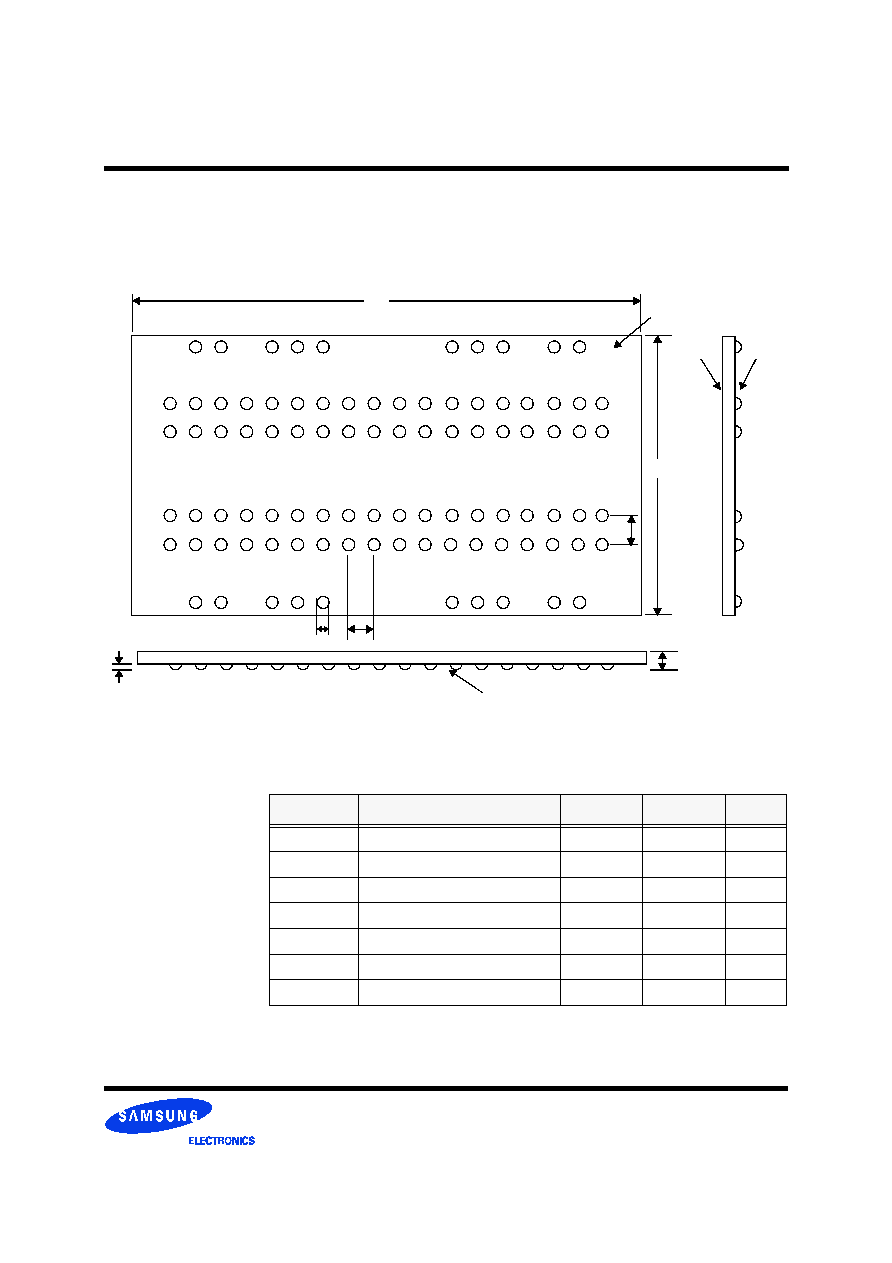
Page 58
Direct RDRAM
TM
K4R881869M
Rev. 0.9 Jan. 2000
Preliminary
Center-Bonded uBGA Package
Figure 61 shows the form and dimensions of the recom-
mended package for the center-bonded CSP device class.
Figure 61: Center-Bonded uBGA Package
Table 27 lists the numerical values corresponding to dimen-
sions shown in Figure 61.
Table 27: Center-Bonded uBGA Package Dimensions
A
B
C
D
E
F
G
H
J
1
2
3
4
5
6
7
D
E
E1
8
Bottom
9
10
K
L
M
N
P
R
S
Y
U
Top
Bottom
A
Bottom
e1
d
e2
Symbol
Parameter
Min
Max
Unit
e1
Ball pitch (x-axis)
0.80
0.80
mm
e2
Ball pitch (y-axis)
0.80
0.80
mm
A
Package body length
10.40
10.60
mm
D
Package body width
17.40
17.60
mm
E
Package total thickness
-
1.00
a
mm
E1
Ball height
0.20
0.30
mm
d
Ball diameter
0.30
0.40
mm
a. The E,MAX parameter for SO-RIMM applications is 0.94mm.

Page 59
Direct RDRAM
TM
K4R881869M
Rev. 0.9 Jan. 2000
Preliminary
Glossary of Terms
ACT
Activate command from AV field.
activate
To access a row and place in sense amp.
adjacent
Two RDRAM banks which share sense
amps (also called doubled banks).
ASYM
CCA register field for RSL V
OL
/V
OH
.
ATTN
Power state - ready for ROW/COL
packets.
ATTNR
Power state - transmitting Q packets.
ATTNW
Power state - receiving D packets.
AV
Opcode field in ROW packets.
bank
A block of 2
RBIT
∑2
CBIT
storage cells in the
core of the RDRAM.
BC
Bank address field in COLC packet.
BBIT
CNFGA register field - # bank address
bits.
broadcast
An operation executed by all RDRAMs.
BR
Bank address field in ROW packets.
bubble
Idle cycle(s) on RDRAM pins needed
because of a resource constraint.
BYT
CNFGB register field - 8/9 bits per byte.
BX
Bank address field in COLX packet.
C
Column address field in COLC packet.
CAL
Calibrate (I
OL
) command in XOP field.
CBIT
CNFGB register field - # column address
bits.
CCA
Control register - current control A.
CCB
Control register - current control B.
CFM,CFMN
Clock pins for receiving packets.
Channel
ROW/COL/DQ pins and external wires.
CLRR
Clear reset command from SOP field.
CMD
CMOS pin for initialization/power control.
CNFGA
Control register with configuration fields.
CNFGB
Control register with configuration fields.
COL
Pins for column-access control.
COL
COLC,COLM,COLX packet on COL pins.
COLC
Column operation packet on COL pins.
COLM
Write mask packet on COL pins.
column
Rows in a bank or activated row in sense
amps have 2
CBIT
dualocts column storage.
command
A decoded bit-combination from a field.
COLX
Extended operation packet on COL pins.
controller
A logic-device which drives the
ROW/COL /DQ wires for a Channel of
RDRAMs.
COP
Column opcode field in COLC packet.
core
The banks and sense amps of an RDRAM.
CTM,CTMN
Clock pins for transmitting packets.
current control
Periodic operations to update the proper
I
OL
value of RSL output drivers.
D
Write data packet on DQ pins.
DBL
CNFGB register field - doubled-bank.
DC
Device address field in COLC packet.
device
An RDRAM on a Channel.
DEVID
Control register with device address that is
matched against DR, DC, and DX fields.
DM
Device match for ROW packet decode.
doubled-bank
RDRAM with shared sense amp.
DQ
DQA and DQB pins.
DQA
Pins for data byte A.
DQB
Pins for data byte B.
DQS
NAPX register field - PDN/NAP exit.
DR,DR4T,DR4F
Device address field and packet framing
fields in ROWA and ROWR packets.
dualoct
16 bytes - the smallest addressable datum.
DX
Device address field in COLX packet.
field
A collection of bits in a packet.
INIT
Control register with initialization fields.
initialization
Configuring a Channel of RDRAMs so
they are ready to respond to transactions.
LSR
CNFGA register field - low-power self-
refresh.
M
Mask opcode field (COLM/COLX packet).
MA
Field in COLM packet for masking byte A.
MB
Field in COLM packet for masking byte B.
MSK
Mask command in M field.
MVER
Control register - manufacturer ID.
NAP
Power state - needs SCK/CMD wakeup.
NAPR
Nap command in ROP field.
NAPRC
Conditional nap command in ROP field.
NAPXA
NAPX register field - NAP exit delay A.
NAPXB
NAPX register field - NAP exit delay B.
NOCOP
No-operation command in COP field.
NOROP
No-operation command in ROP field.

Page 60
Direct RDRAM
TM
K4R881869M
Rev. 0.9 Jan. 2000
Preliminary
NOXOP
No-operation command in XOP field.
NSR
INIT register field- NAP self-refresh.
packet
A collection of bits carried on the Channel.
PDN
Power state - needs SCK/CMD wakeup.
PDNR
Powerdown command in ROP field.
PDNXA
Control register - PDN exit delay A.
PDNXB
Control register - PDN exit delay B.
pin efficiency
The fraction of non-idle cycles on a pin.
PRE
PREC,PRER,PREX precharge commands.
PREC
Precharge command in COP field.
precharge
Prepares sense amp and bank for activate.
PRER
Precharge command in ROP field.
PREX
Precharge command in XOP field.
PSX
INIT register field - PDN/NAP exit.
PSR
INIT register field - PDN self-refresh.
PVER
CNFGB register field - protocol version.
Q
Read data packet on DQ pins.
R
Row address field of ROWA packet.
RBIT
CNFGB register field - # row address bits.
RD/RDA
Read (/precharge) command in COP field.
read
Operation of accesssing sense amp data.
receive
Moving information from the Channel into
the RDRAM (a serial stream is demuxed).
REFA
Refresh-activate command in ROP field.
REFB
Control register - next bank (self-refresh).
REFBIT
CNFGA register field - ignore bank bits
(for REFA and self-refresh).
REFP
Refresh-precharge command in ROP field.
REFR
Control register - next row for REFA.
refresh
Periodic operations to restore storage cells.
retire
The automatic operation that stores write
buffer into sense amp after WR command.
RLX
RLXC,RLXR,RLXX relax commands.
RLXC
Relax command in COP field.
RLXR
Relax command in ROP field.
RLXX
Relax command in XOP field.
ROP
Row-opcode field in ROWR packet.
row
2
CBIT
dualocts of cells (bank/sense amp).
ROW
Pins for row-access control
ROW
ROWA or ROWR packets on ROW pins.
ROWA
Activate packet on ROW pins.
ROWR
Row operation packet on ROW pins.
RQ
Alternate name for ROW/COL pins.
RSL
Rambus Signaling Levels.
SAM
Sample (I
OL
) command in XOP field.
SA
Serial address packet for control register
transactions w/ SA address field.
SBC
Serial broadcast field in SRQ.
SCK
CMOS clock pin..
SD
Serial data packet for control register
transactions w/ SD data field.
SDEV
Serial device address in SRQ packet.
SDEVID
INIT register field - Serial device ID.
self-refresh
Refresh mode for PDN and NAP.
sense amp
Fast storage that holds copy of bank's row.
SETF
Set fast clock command from SOP field.
SETR
Set reset command from SOP field.
SINT
Serial interval packet for control register
read/write transactions.
SIO0,SIO1
CMOS serial pins for control registers.
SOP
Serial opcode field in SRQ.
SRD
Serial read opcode command from SOP.
SRP
INIT register field - Serial repeat bit.
SRQ
Serial request packet for control register
read/write transactions.
STBY
Power state - ready for ROW packets.
SVER
Control register - stepping version.
SWR
Serial write opcode command from SOP.
TCAS
TCLSCAS register field - t
CAS
core delay.
TCLS
TCLSCAS register field - t
CLS
core delay.
TCLSCAS
Control register - t
CAS
and t
CLS
delays.
TCYCLE
Control register - t
CYCLE
delay.
TDAC
Control register - t
DAC
delay.
TEST77
Control register - for test purposes.
TEST78
Control register - for test purposes.
TRDLY
Control register - t
RDLY
delay.
transaction
ROW,COL,DQ packets for memory
access.
transmit
Moving information from the RDRAM
onto the Channel (parallel word is muxed).
WR/WRA
Write (/precharge) command in COP field.
write
Operation of modifying sense amp data.
XOP
Extended opcode field in COLX packet.

Page 61
Direct RDRAM
TM
K4R881869M
Rev. 0.9 Jan. 2000
Preliminary
Table Of Contents
Overview . . . . . . . . . . . . . . . . . . . . . . . . . . . . . . . . . . 1
Features . . . . . . . . . . . . . . . . . . . . . . . . . . . . . . . . . . . 1
Key Timing Parameters/Part Numbers . . . . . . . . . . . 1
Pinouts and Definitions . . . . . . . . . . . . . . . . . . . . . . . 2
Pin Description . . . . . . . . . . . . . . . . . . . . . . . . . . . . . . 3
Block Diagram . . . . . . . . . . . . . . . . . . . . . . . . . . . . . . 4
General Description . . . . . . . . . . . . . . . . . . . . . . . . . . 5
Packet Format . . . . . . . . . . . . . . . . . . . . . . . . . . . . .6,7
Field Encoding Summary . . . . . . . . . . . . . . . . . . . . .8,9
DQ Packet Timing . . . . . . . . . . . . . . . . . . . . . . . . . . 10
COLM Packet to D Packet Mapping . . . . . . . . . .10,11
ROW-to-ROW Packet Interaction . . . . . . . . . . . 12, 13
ROW-to-COL Packet Interaction . . . . . . . . . . . . . . . 13
COL-to-COL Packet Interaction . . . . . . . . . . . . . . . . 14
COL-to-ROW Packet Interaction . . . . . . . . . . . . . . . 15
ROW-to-ROW Examples . . . . . . . . . . . . . . . . . . .16,17
Row and Column Cycle Description . . . . . . . . . . . . 17
Precharge Mechanisms . . . . . . . . . . . . . . . . . . . .18,19
Read Transaction - Example . . . . . . . . . . . . . . . . . . 20
Write Transaction - Example . . . . . . . . . . . . . . . . . . 21
Write/Retire - Examples . . . . . . . . . . . . . . . . . . . 22, 23
Interleaved Write - Example. . . . . . . . . . . . . . . . . . . 24
Interleaved Read - Example . . . . . . . . . . . . . . . . . . 25
Interleaved RRWW . . . . . . . . . . . . . . . . . . . . . . . . . 25
Control Register Transactions . . . . . . . . . . . . . . . . . 26
Control Register Packets . . . . . . . . . . . . . . . . . . . . . 27
Initialization . . . . . . . . . . . . . . . . . . . . . . . . . . . . .28-29
Control Register Summary. . . . . . . . . . . . . . . . . 30-37
Power State Management . . . . . . . . . . . . . . . . . 38-41
Refresh . . . . . . . . . . . . . . . . . . . . . . . . . . . . . . . . . . 42
Current and Temperature Control . . . . . . . . . . . . . . 43
Electrical Conditions . . . . . . . . . . . . . . . . . . . . . . . . 44
Timing Conditions . . . . . . . . . . . . . . . . . . . . . . . .44-45
Electrical Characteristics . . . . . . . . . . . . . . . . . . . . . 46
Timing Characteristics . . . . . . . . . . . . . . . . . . . . . . . 46
RSL Clocking . . . . . . . . . . . . . . . . . . . . . . . . . . . . . . 47
RSL - Receive Timing . . . . . . . . . . . . . . . . . . . . . . . 48
RSL - Transmit Timing . . . . . . . . . . . . . . . . . . . . . . . 49
CMOS - Receive Timing . . . . . . . . . . . . . . . . . . .50-51
CMOS - Transmit Timing . . . . . . . . . . . . . . . . . . .52-53
RSL - Domain Crossing Window . . . . . . . . . . . . . . . 53
Timing Parameters. . . . . . . . . . . . . . . . . . . . . . . . . . 54
Absolute Maximum Ratings . . . . . . . . . . . . . . . . . . . 55
I
DD
- Supply Current Profile . . . . . . . . . . . . . . . . . . . 55
Capacitance and Inductance . . . . . . . . . . . . . . . .56-57
Center-Bonded
µ
BGA Package . . . . . . . . . . . . . . . . 58
Glossary of Terms . . . . . . . . . . . . . . . . . . . . . . . .59-60
© Copyright January 2000 Samsung Electronics.
All rights reserved.
Direct Rambus and Direct RDRAM are trademarks of
Rambus Inc. Rambus, RDRAM, and the Rambus Logo are
registered trademarks of Rambus Inc.
This document contains advanced information that is subject
to change by Samsung without notice.
Document Version 0.9
Samsung Electronics Co., Ltd.
San #24 Nongseo-Ri, Kiheung-Eup Yongin-City
Kyunggi-Do, KOREA
Telephone: 82-331-209-4519
Fax: 82-2-760-7990
http://www.samsungsemi.com

Page 62
Direct RDRAM
TM
K4R881869M
Rev. 0.9 Jan. 2000
Preliminary































































